Eighth Pay Commission
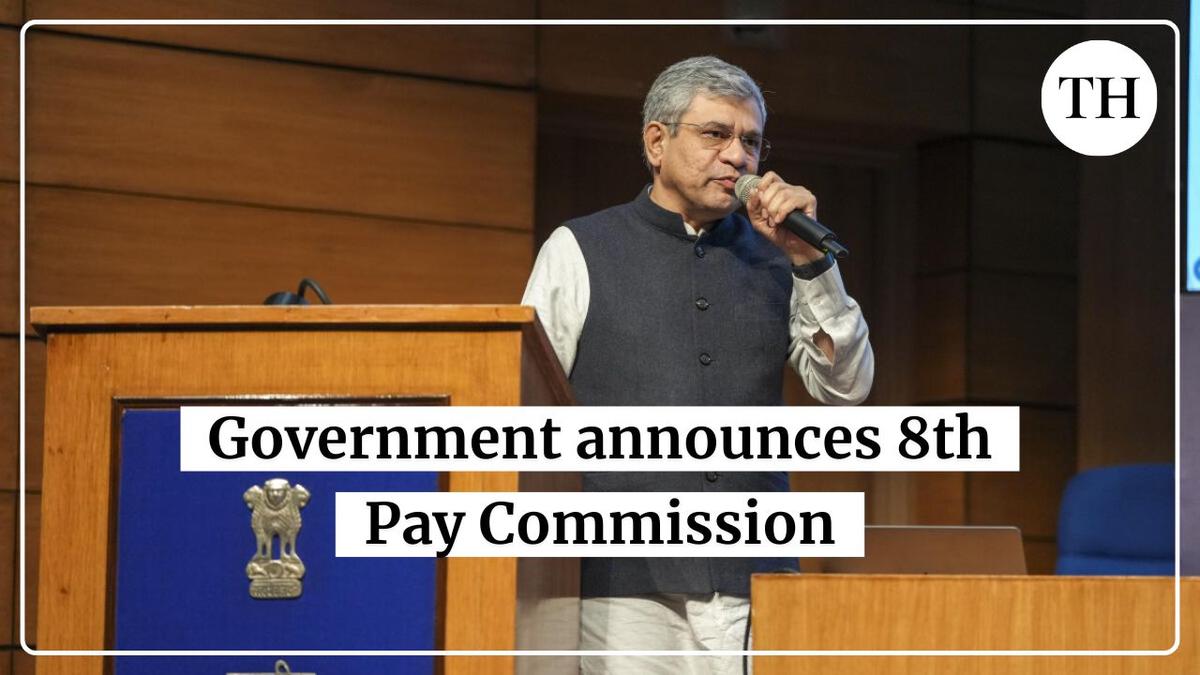
- 17 Jan 2025
In News:
The Union government has approved the constitution of the Eighth Pay Commission, benefiting 50 lakh central government employees and 65 lakh pensioners, including serving and retired defence personnel. The decision, taken ahead of the Delhi Assembly elections, aims to address long-standing demands from trade unions and employee organizations.
Key Features of the 8th Pay Commission
- Early Constitution: Although the Seventh Pay Commission's term ends in 2026, the early establishment of the Eighth Pay Commission ensures timely recommendations and implementation.
- Composition: The commission will have a Chairperson and two members, typically led by a retired Supreme Court judge.
- Terms of Reference (ToR):
- Revision of Pay: Recommend updates to salary structures and allowances.
- Addressing Pay Disparities: Resolve wage differences across various cadres.
- Market Parity: Align pay structures with industry standards.
- Pension and Retirement Benefits: Improve pension schemes and adjust them for inflation.
- Economic Impact Analysis: Assess how salary hikes contribute to economic growth.
- Stakeholder Consultations: Engage with governments and other stakeholders before finalizing recommendations.
Economic Implications of the 8th Pay Commission
- Employee Well-being: Higher wages will enhance the quality of life for government employees.
- Boost to Consumption: Increased salaries are expected to stimulate demand and support economic expansion.
- Ripple Effect on PSUs & States: Many public sector undertakings and state governments follow the central pay commission’s recommendations, potentially leading to wider economic benefits.
- Fiscal Considerations: The implementation of the Seventh Pay Commission in 2016-17 led to an expenditure increase of ?1 lakh crore. A similar rise in 2026-27 could impact fiscal space for capital expenditures.
Challenges and Concerns
- Implementation Delays: Past commissions have taken two years to submit recommendations, which could push implementation beyond 2027.
- Living Wage & Pension Issues: Existing formulas for minimum wage and pension calculations may need revision to reflect rising healthcare, education, and digital access costs.
- Financial Burden on the Exchequer: A significant increase in revenue expenditure could limit the government’s ability to invest in infrastructure and development projects.
Konkan Region’s Sada and Biodiversity
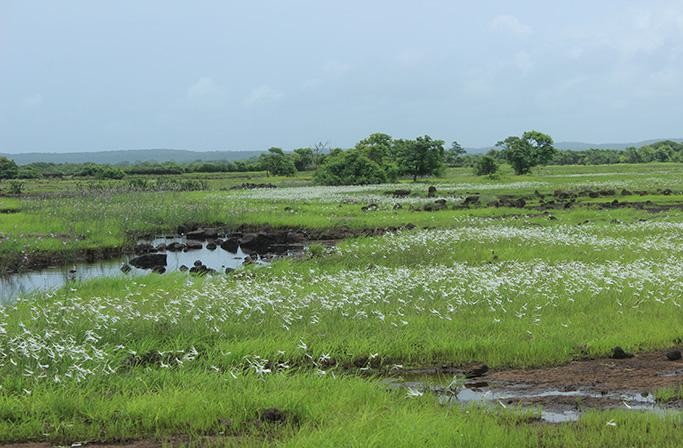
- 14 Jan 2025
In News:
A Konkan secret, the flat-top sada is a freshwater paradise.
Key Highlights:
Geography of Sada:
- The Konkan region lies between the Arabian Sea and the Western Ghats.
- Sada refers to flat-topped hills, formed by centuries of erosion, and is a prominent feature in the Ratnagiri district.
- These areas are typically barren except during the monsoon season when they come alive with flora and fauna.
Biodiversity and Ecosystem Services:
- A biodiversity survey between 2022-2024 recorded 459 plant species, with 105 being endemic to the Konkan region.
- The survey also identified 31 species of reptiles, 13 species of amphibians, 169 species of birds, and 41 species of mammals.
- These ecosystems play a vital role in water conservation. The lateritic soil layer atop the Sada acts as a catchment for rainwater, recharging the groundwater and providing freshwater to local communities year-round.
Traditional Land Use and Agriculture:
- Local Farming: During monsoons, the Sada is used by locals for growing traditional crops like rice and millets (e.g., nanchani), using sustainable farming practices without pesticides or chemical fertilizers.
- Water Management: The locals rely on open wells, springs, and perennial streams for freshwater, which are carefully maintained through cultural rituals and community hygiene practices.
Conservation and Cultural Importance:
- The region is home to geoglyphs, ancient artworks estimated to be 10,000 years old, adding to its cultural and historical significance.
- Waterbodies on the Sada serve as habitats for species like the Indian flapshell turtle (Lissemys punctata) and provide water for other wildlife, including leopards, jackals, hyenas, barking deer, and migratory birds.
Environmental Threats:
- Land-use Change: Increasing conversion of open land and croplands into orchards and residential areas, along with various developmental projects, threatens the region's biodiversity.
- Mining: Extraction of laterite stones for construction purposes is another environmental risk.
- Wasteland Classification: The region is often classified as a ‘wasteland’ in the Wasteland Atlas, further complicating conservation efforts.
Flamingo Festival 2025
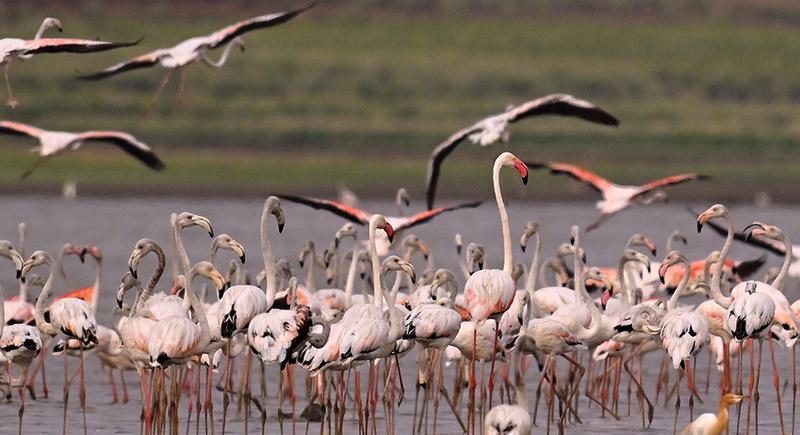
- 10 Jan 2025
In News:
The Flamingo Festival 2025 took place at Sullurpeta, in Tirupati district, Andhra Pradesh. It celebrates the arrival of migratory birds, with a focus on flamingos, to the region's key bird habitats, including Pulicat Lake and Nelapattu Bird Sanctuary.
Key Highlights:
- Birdwatching: Over 200 bird species, including flamingos, are expected to flock to the region during this festival.
- Locations: The event spans across five locations:
- Nelapattu Bird Sanctuary
- B.V. Palem (Pulicat Lake)
- Atakanithippa
- Sri City
- Sullurpeta (site for cultural programs and stalls)
- Collaborations: In association with organizations like the Bombay Natural History Society.
- Focus on Local Community: Local residents of the eco-sensitive zone will be prioritized and supported.
Key Facts on Local Wildlife and Significance:
- Pulicat Lake:
- Location: On the Andhra Pradesh-Tamil Nadu border, with 96% of the lake in Andhra Pradesh.
- Significance: The second-largest brackish water lake in India (after Chilika Lake in Odisha).
- Biodiversity: Critical habitat for migratory birds, including flamingos, and home to diverse flora and fauna.
- Economic Importance: Supports local fisheries and provides livelihood to nearby communities.
- Nelapattu Bird Sanctuary:
- Location: 20 km north of Pulicat Lake.
- Ecological Role: Largest breeding site in Southeast Asia for spot-billed pelicans.
- Biodiversity: 189 bird species, including painted storks and glossy ibises.
- Flora and Fauna: Features Barringtonia swamp forests and southern dry evergreen scrub, critical for biodiversity conservation.
- Symbiotic Relationship with Locals: Guano (bird droppings) from pelicans serves as a natural fertilizer for local agriculture, benefiting the farmers.
Flamingo Facts:
- Species: India hosts two flamingo species:
- Greater Flamingo (larger size, pale pink)
- Lesser Flamingo (smaller size, bright pink)
- Behavior: Nomadic and social birds, found in large flocks.
- Coloration: Flamingos' pink color comes from carotenoids in their diet, which are broken down and absorbed into their bodies.
Environmental & Economic Impact: The festival, apart from being a celebration of migratory birds, plays a vital role in:
- Eco-tourism development
- Biodiversity conservation
Local community engagement by highlighting sustainable tourism practices and supporting local livelihoods through eco-friendly initiatives like the Mahatma Gandhi National Rural Employment Guarantee Scheme (MGNREGS).
Toda Tribe
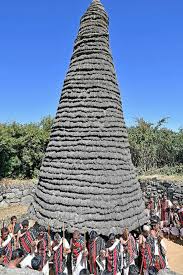
- 11 Jan 2025
In News:
- The Toda tribe, one of the oldest Dravidian ethnic groups in the Nilgiris Hills of Tamil Nadu, celebrated their traditional Modhweth festival marking the New Year.
What is the Modhweth Festival?
- About:
- Celebrated annually on the last Sunday of December or the first Sunday of January.
- Held at the Moonpo temple in Muthanadu Mund village, Nilgiri district.
- The Moonpo temple features a unique vertical spire with a thatched roof and a flat stone on top, making it one of the last Toda temples of its kind in the Nilgiris.
- Rituals and Celebrations:
- Prayers are offered to the deity, Thenkish Amman, for good health, rains, and bountiful harvest.
- Participants perform a traditional dance outside the temple.
- Unique Customs:
- Toda youth showcase their strength and masculinity by lifting a greased boulder weighing around 80 kg.
- Women are not part of the celebrations as per traditional customs.
What is the Toda Tribe?
- About:
- A pastoral tribe native to the Nilgiri Hills of Tamil Nadu.
- Classified as a Particularly Vulnerable Tribal Group (PVTG) in Tamil Nadu.
- The Toda language is Dravidian but stands out for its uniqueness among Dravidian languages.
- Significance:
- Toda lands are part of the Nilgiri Biosphere Reserve, a UNESCO International Biosphere Reserve.
- Their territory is also recognized as a UNESCO World Heritage Site.
- Religion and Beliefs:
- Their religious practices are based on a pantheon of gods, with Tökisy (goddess) and Ön (god of the underworld) as central deities.
Nilgiri Biosphere Reserve (NBR)
- About:
- Established in 1986 as India’s first Biosphere Reserve.
- Located across Tamil Nadu, Karnataka, and Kerala.
- India’s first biosphere reserve under UNESCO’s Man and the Biosphere Programme.
- Tribal Groups in NBR:
- Home to several groups such as Adiyan, Aranadan, Kader, Kurichian, Kuruman, and Kurumbas.
- Ecological Significance:
- Represents the confluence of Afro-tropical and Indo-Malayan biotic zones.
- Fauna:
- Home to species like Nilgiri tahr, Nilgiri langur, gaur, Indian elephant, Nilgiri danio (freshwater fish), and Nilgiri barbare.
- Protected Areas in NBR:
- Mudumalai Wildlife Sanctuary, Wayanad Wildlife Sanctuary, Bandipur National Park, Nagarhole National Park, Mukurthi National Park, and Silent Valley.
IIT Bombay Develops Painless Needle-Free Shock Syringes
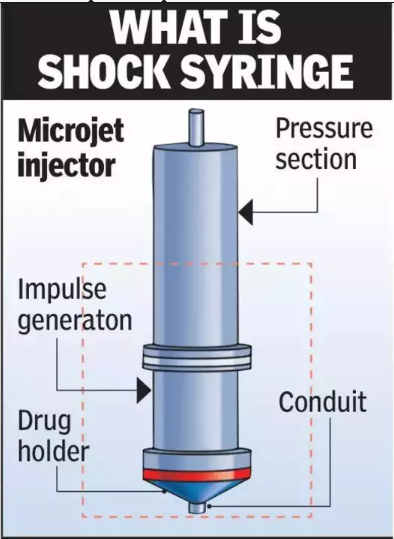
- 29 Dec 2024
In News:
Researchers at IIT Bombay, led by Viren Menezes from the Department of Aerospace Engineering, have developed a shockwave-based, needle-free syringe to deliver drugs painlessly and safely. The research was published in the Journal of Biomedical Materials and Devices.
Key Features of Shock Syringe:
- Unlike traditional syringes, the shock syringe uses high-energy shockwaves (traveling faster than the speed of sound) to deliver drugs, without the need for needles.
- The device is designed to reduce pain, tissue damage, and infection risk.
- The shock syringe aims to eliminate the discomfort and fear associated with needles.
How the Shock Syringe Works:
- The shock syringe is slightly longer than a ballpoint pen and contains a micro shock tube with three sections: driver, driven, and drug holder.
- Pressurized nitrogen gas is applied to the driver section, which creates a microjet of liquid drug. The microjet travels at speeds nearly twice as fast as a commercial airplane.
- The drug is then delivered through the nozzle of the syringe, penetrating the skin rapidly and gently.
Design Considerations:
- The syringe's nozzle has an opening of 125 μm (approximately the width of a human hair), ensuring a balance between precision and speed.
- Continuous monitoring of pressure ensures safe and effective drug delivery with minimal skin damage.
Testing and Results:
- Lab tests were conducted on rats, injecting three types of drugs:
- Anaesthetics (Ketamine-Xylazine): Shock syringe produced similar results to needles in terms of effect onset and duration.
- Viscous drugs (e.g., Terbinafine): The shock syringe outperformed needles, delivering the drug more deeply into the skin layers.
- Insulin for diabetic rats: The shock syringe lowered blood sugar levels more effectively and sustained the effect for a longer period.
- The skin analysis revealed less damage and inflammation with the shock syringe compared to traditional needles.
Advantages:
- Painless drug delivery: Patients experience little to no discomfort.
- Reduced tissue damage: The shock syringe causes less skin trauma and inflammation.
- Faster healing: Wounds from the injection heal quicker compared to traditional needles.
- Better drug absorption: Especially for viscous drugs, the shock syringe delivers more efficient and deeper drug penetration.
Potential Applications:
- The shock syringe could revolutionize immunization drives, making vaccinations faster and more efficient.
- It could significantly reduce the risk of bloodborne diseases caused by needle-stick injuries.
- The device is designed to perform over 1,000 injections, ensuring cost-effectiveness and reliability with minimal nozzle replacements.
Future Prospects:
- While promising, the future of shock syringes in clinical use depends on:
- Further innovation for human use.
- Obtaining regulatory approval.
- Ensuring the device’s affordability and accessibility.
Private Aviation and Emissions

- 26 Dec 2024
In News:
Private aviation is releasing more than its ‘fair share’ of emissions.
Key Highlights:
- Aviation Sector's Global Emissions:
- The aviation sector contributed 2% of global CO2 emissions in 2022, around 800 Mt CO2 (International Energy Agency).
- If considered as a nation, aviation would rank among the top 10 emitters worldwide.
- Emissions from aviation have grown faster than other sectors like rail, road, or shipping in recent decades.
- Private Aviation and Its Impact:
- Private jets emit 5 to 14 times more CO2 per passenger than commercial flights and 50 times more than trains.
- Emissions from private aviation increased by 46% between 2019 and 2023.
- Each private flight contributes 3.6 tonnes of CO2 on average, intensifying global warming.
- Private aviation is responsible for significant nitrogen oxide (NOx) emissions and the creation of vapor trails, which further amplify environmental damage.
Trends in Private Aviation Growth:
- Global Trends:
- The number of private jets increased from 25,993 in December 2023 to 26,454 in February 2024.
- In the U.S., 69% of private aviation activity is concentrated.
- 8,500 more jets are expected to be delivered in the next 10 years globally.
- Private Aviation in India:
- 112 private planes were registered in India as of March 2024, placing it among the top 20 countries for private aircraft ownership.
- India's private aviation sector is expanding, driven by the growing billionaire and millionaire population.
- Private aircraft ownership in India stands at 1 per 1 lakh population, which is low compared to countries like Malta (46.51 per lakh) and the U.S. (5.45 per lakh).
Emission Reduction Efforts and Solutions:
- Sustainable Aviation Fuels (SAFs):
- SAFs are bio-based or waste-derived fuels that can reduce carbon emissions by up to 80% compared to conventional jet fuels.
- Airlines like SpiceJet (2018) and AirAsia (2023) have tested SAFs, but large-scale adoption is hindered by high costs and limited production.
- India aims to leverage its ethanol production chain, with potential to meet 15-20% of aviation fuel demand by 2050 if only surplus sugar is used.
- Hydrogen and Electric Aviation:
- Hydrogen offers a higher energy density than kerosene and emits only water vapor, making it a clean fuel alternative. However, hydrogen faces challenges with storage, infrastructure, and aircraft redesign.
- Battery-electric propulsion offers zero emissions but is currently limited by battery weight, energy density, and charging infrastructure.
India’s Policy and Initiatives:
- Government Initiatives:
- UDAN Scheme (Ude Desh ka Aam Nagrik) aims to enhance rural connectivity.
- NABH (Nextgen Airports for Bharat Nirman) seeks to increase airport capacity by five times.
- Sustainability Efforts:
- Indian airlines have tested SAFs, such as a 25% jatropha oil blend by SpiceJet in 2018.
- Ethanol for aviation fuel: India plans to use surplus sugar for ethanol, potentially fulfilling 15-20% of aviation fuel needs by 2050.
- Challenges to Decarbonisation:
- SAFs are costly and limited in availability.
- Hydrogen requires extensive infrastructure and aircraft redesign.
- Battery-electric solutions are currently unsuitable for long-haul flights due to energy limitations.
GenCast AI
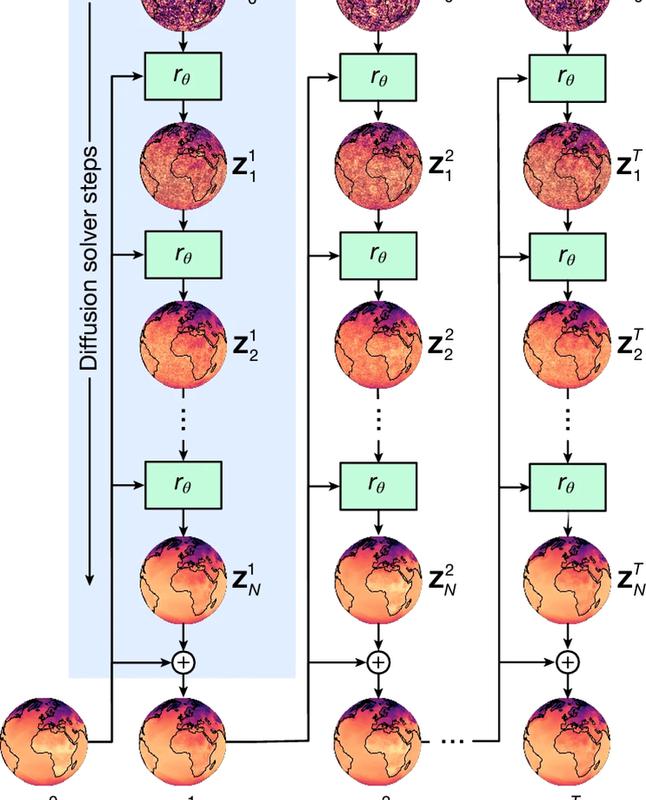
- 24 Dec 2024
In News:
Google’s GenCast AI is an advanced weather forecasting model developed by DeepMind that uses machine learning techniques to provide more accurate and longer-term weather predictions compared to traditional forecasting methods.
How GenCast Works:
- Training on Reanalysis Data:
- GenCast is trained on 40 years of reanalysis data (from 1979 to 2019). This data combines historical weather observations with modern weather forecasts, providing a comprehensive picture of past weather and climate conditions.
- Ensemble Forecasting with AI:
- Unlike traditional Numerical Weather Prediction (NWP) models, which run simulations based on physical laws and initial conditions, GenCast uses an ensemble forecasting approach where multiple predictions are generated by an AI model, not an NWP model.
- It produces a range of possible weather scenarios, each with different starting conditions, to reflect the uncertainty in weather forecasts.
- Neural Network and Diffusion Model:
- GenCast uses a neural network architecture with 41,162 nodes and 240,000 edges that process weather data. Each node accepts data, manipulates it, and passes it to another node, helping to refine and improve predictions.
- It uses a diffusion model, a type of AI model commonly used in generative AI. The model takes noisy input data, processes it through 30 refinement steps, and gradually produces a clearer forecast (de-noising the data).
- The result is a probabilistic forecast, such as "there's a 25% chance of rain in Chennai on December 25," rather than a deterministic forecast, which would provide exact quantities like "5 mm of rain."
- Faster Processing:
- The entire forecast process is incredibly efficient. GenCast can generate 50 ensemble forecasts at once with a spatial resolution of 0.25° x 0.25° (latitude-longitude) and temporal resolution of 12 hours.
- Using Google's TPU v5 units, it can produce these forecasts in just 8 minutes—far faster than traditional supercomputers, which can take several hours to run NWP simulations.
Key Features of GenCast:
- Better Performance on Extreme Weather: GenCast has shown superior accuracy in predicting extreme weather events, such as tropical cyclones, compared to traditional NWP models like those from the European Centre for Medium-Range Weather Forecasts (ECMWF).
- Probabilistic Forecasting: GenCast produces probabilistic forecasts, offering predictions like the likelihood of rain rather than precise measures, which helps with better preparation, especially for extreme weather events.
- Long-Term Forecasting: GenCast can generate forecasts for up to 15 days, which is longer than most traditional models, and is particularly useful for anticipating events like wind power generation and tropical cyclone tracking.
- Efficiency: GenCast's speed and resource efficiency set it apart from traditional NWP models, reducing forecast times dramatically.
Comparison with Traditional Weather Models:
- Numerical Weather Prediction (NWP): Traditional NWP models rely on solving complex physical equations to simulate the atmosphere and provide deterministic forecasts. These models require significant computational power and are typically limited to weather predictions for about a week.
- GenCast's Probabilistic Forecasts: In contrast, GenCast offers probabilistic predictions, making it better suited for providing early warnings about extreme weather, with better lead times for disaster preparation.
Future Developments:
While GenCast is impressive, Google acknowledges the importance of traditional NWP models for both supplying initial conditions and providing the foundational data needed to train AI models like GenCast. Ongoing collaboration with weather agencies is crucial to enhancing AI-based methods for weather prediction.
Overall, GenCast represents a significant leap forward in the use of AI for weather forecasting, with potential for greater accuracy, efficiency, and longer-term predictions compared to current methods.
RBI's Report on State Finances (2024-25)
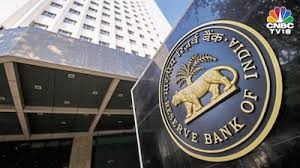
- 23 Dec 2024
In News:
The Reserve Bank of India's (RBI) report titled "State Finances – A Study of Budgets of 2024-25" provides a comprehensive analysis of the fiscal position of Indian states.
Key Highlights
- States' Performance Post-Pandemic
- Improved Tax Revenue: The average tax buoyancy has increased significantly from 0.86 (2013-2020) to 1.4 (2021-2025), reflecting enhanced tax collection efficiency.
- Capital Expenditure: There is a consistent rise in capital expenditure, which increased from 2.4% of GDP in 2021-22 to 2.8% in 2023-24 and is budgeted at 3.1% in 2024-25. This indicates a growing focus on investment in infrastructure like highways and bridges.
- Fiscal Discipline and Debt Levels
- Gross Fiscal Deficit (GFD): The gross fiscal deficit is projected at 3.2% of GDP in 2024-25, a slight increase from 2.9% in 2023-24.
- Debt-to-GDP Ratio: While states' debt-to-GDP ratio decreased from 31.0% in March 2021 to 28.5% in March 2024, it remains higher than the pre-pandemic level of 25.3% in 2019.
- Increased Borrowing and Debt Pressure
- Market Borrowings: States' reliance on market borrowings has increased, accounting for 79% of the GFD in FY25. Gross market borrowings surged by 32.8%, totaling Rs 10.07 trillion in FY23-24.
- Electricity Distribution Companies (DISCOMs): Continued losses in DISCOMs, accumulating Rs 6.5 lakh crore by 2022-23 (2.4% of India's GDP), continue to strain state finances.
- Rising Subsidy Burden
- Many states are offering subsidies and loan waivers, such as farm loan waivers and free services (electricity, transport, etc.), which risk diverting funds away from critical infrastructure projects. This includes significant subsidies for income transfers to farmers, women, and youth.
- Fiscal Transparency Concerns
- Revenue Generation Issues: Revenue growth from non-tax sources and central grants is slowing. The pace of State Goods and Services Tax (SGST) growth has also slowed down, which impacts overall state revenues.
- Lack of Fiscal Transparency: Inadequate reporting of off-budget liabilities obfuscates the true fiscal position, leading to a lack of clarity and accountability in state finances.
Recommendations by the RBI
- Debt Consolidation: States are encouraged to create clear and transparent debt reduction paths, with consistent reporting of off-budget liabilities to improve fiscal accountability.
- Expenditure Efficiency: Focus on outcome-based budgeting, ensuring funds are directed towards productive and sustainable investments, particularly in climate-sensitive areas.
- Subsidy Rationalization: States should contain and optimize subsidies to ensure they don't overshadow essential growth-promoting expenditure.
- Efficient Borrowings: Reduce over-reliance on market borrowings to control fiscal deficits and minimize financial risks.
- Revenue Generation: Improve collection mechanisms for SGST, strengthen non-tax revenue sources, and increase grants to reduce dependence on borrowings.
Balancing Subsidies and Fiscal Discipline
- Importance of Subsidies: Welfare programs like subsidies for healthcare, food security (e.g., Public Distribution System), and LPG connections (e.g., Pradhan Mantri Ujjwala Yojana) play a crucial role in human development and economic equality by supporting vulnerable populations.
- Importance of Fiscal Discipline: Excessive welfare spending without corresponding revenue generation can lead to high deficits and public debt, threatening long-term fiscal stability. Maintaining fiscal discipline ensures sustainable public finances, promotes investor confidence, and supports economic growth.
2024 World Chess Championship

- 13 Dec 2024
In News:
D. Gukesh became the youngest world chess champion after defeating Ding Liren of China in the final game of their match.
Key Facts about the 2024 World Chess Championship:
- Held At: Singapore, from November 25 to December 12, 2024.
- Players: Reigning champion Ding Liren (China) vs. Challenger D. Gukesh (India).
- Significance: This was the first-ever World Championship match contested by two Asian players. Gukesh became the third Asian to win the World Championship after Viswanathan Anand (India) and Ding Liren (China).
- Historical Context: The World Chess Championship was first established in 1886 with Wilhelm Steinitz as the first official World Champion.
- Governing Body: Organized by FIDE (Fédération Internationale des Échecs), which has been responsible for the event since 1948.
- Selection Process: Gukesh earned his spot through his victory in the 2024 Candidates Tournament in Toronto, while Ding Liren was the reigning champion after Magnus Carlsen declined to defend his title.
D. Gukesh: Key Details
- Birth: May 29, 2006, in Chennai, India.
- Grandmaster Title: Achieved at age 12 years, 7 months, and 17 days, making him the third-youngest Grandmaster in history.
- Chess Rating: He is the youngest player to reach a 2750 FIDE rating.
- Significant Wins:
- Gold medals in both team and individual events at the 2024 Chess Olympiad.
- Bronze medal in team events at the 2024 Asian Games.
- Remarkable Fact: Gukesh is four years younger than Garry Kasparov was when he won the World Championship in 1985.
FIDE World Chess Championship Overview:
- Founded: 1924 in Paris; headquartered in Lausanne, Switzerland.
- Governing Body: The International Chess Federation (FIDE) is recognized by the International Olympic Committee and governs global chess competitions. FIDE has 201 member countries.
Indian Chess Achievements:
- Viswanathan Anand: First Indian to win the World Chess Championship (5-time World Champion).
- D. Gukesh: Second Indian to win the World Chess Championship.
Indian Scientists Develop Novel Gene Therapy for Haemophilia
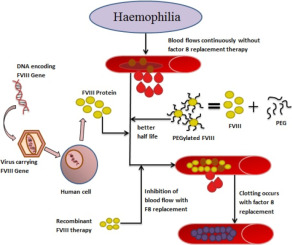
- 12 Dec 2024
In News:
Indian scientists have developed a successful gene therapy treatment for severe haemophilia A, a rare inherited blood disorder causing spontaneous, potentially fatal bleeding episodes.
Key Highlights:
Trial Success:
- The trial, conducted at Christian Medical College (CMC), Vellore, involved five patients from Tamil Nadu.
- Results: None of the five patients reported bleeding episodes for over a year after receiving the treatment. The follow-up period averaged 14 months.
- This marks a significant improvement, as haemophilia patients typically experience frequent bleeding episodes requiring regular treatment.
Gene Therapy as a One-Time Solution:
- Traditional treatments involve frequent injections of clotting factors to prevent bleeding.
- The new gene therapy offers a one-time solution, teaching the body to produce enough clotting factor to prevent hemorrhages.
Haemophilia A - Overview:
- Caused by the absence of Factor VIII, a critical blood-clotting protein.
- Hemophilia A primarily affects males (since it's an X-linked disorder), though some females with two defective X chromosomes can also develop the condition.
- Symptoms include prolonged bleeding from minor injuries or internal bleeding in joints and muscles.
Current Treatment Challenges:
- Haemophilia treatments can be expensive and require lifelong care, costing up to ?2.54 crore over a 10-year period.
- The therapy requires repeated infusions of clotting factors or synthetic alternatives, which can be burdensome.
Gene Therapy Details:
- The gene therapy used in this trial involves fusing stem cells with the gene for Factor VIII using a lentivirus vector (safer than other vectors like adenovirus).
- This therapy eliminates the need for repeated Factor VIII infusions, providing a more cost-effective and sustainable solution.
Global Context:
- India has one of the world’s largest haemophilia populations, with an estimated 40,000 to 100,000 patients.
- The success of this gene therapy in India could lead to localized production, reducing treatment costs and increasing accessibility to gene therapy in resource-constrained settings.
Comparison with Roctavian:
- Roctavian, the only FDA-approved gene therapy for haemophilia A, also uses gene delivery to produce Factor VIII, but requires immunosuppressive therapy and is not approved for children.
- In contrast, the Vellore trial's lentivirus-based approach is considered safer, especially for children, with the potential for broader application.
Railways (Amendment) Bill, 2024
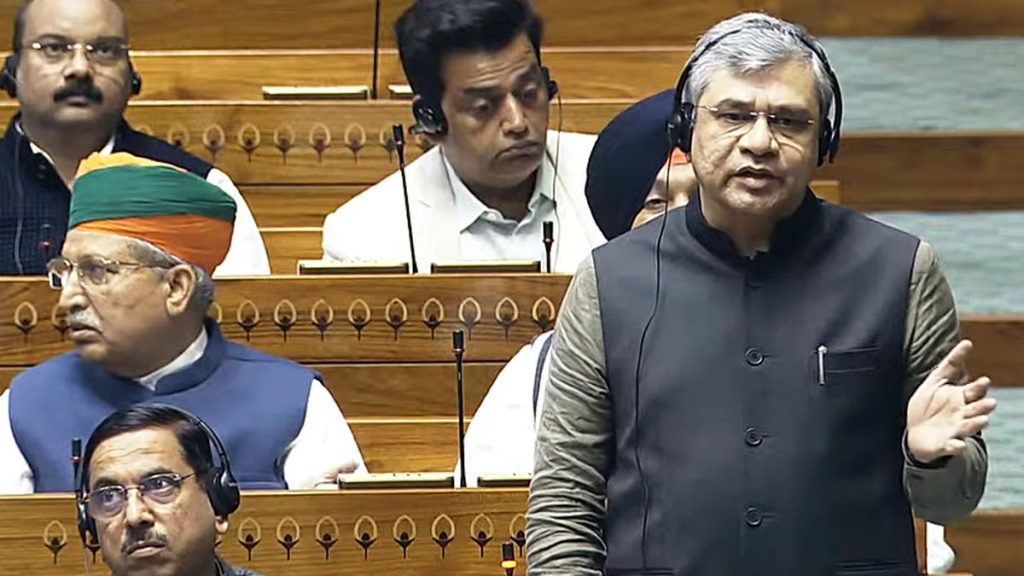
- 12 Dec 2024
In News:
The Railways (Amendment) Bill, 2024 was passed in the Lok Sabha on December 20, 2024, aiming to enhance the functioning and autonomy of Indian Railways.
Key Provisions:
- Repeal of the Indian Railway Board Act, 1905: The Bill repeals the 1905 Act and incorporates its provisions into the Railways Act, 1989, simplifying the legal framework by reducing the need to refer to two separate laws.
- Statutory Backing for Railway Board: The Bill provides statutory backing to the Railway Board, which previously lacked such a legal mandate. It grants the Union government the authority to determine the number of members, their qualifications, terms, and conditions of service.
- Decentralization of Power: The Bill aims to decentralize decision-making, granting greater autonomy to regional railway zones. This shift will allow more independence in budgeting, infrastructure projects, and recruitment, addressing long-standing calls for improved regional empowerment.
- Independent Regulator: The Bill proposes the creation of an independent regulator for overseeing tariffs, safety, and private sector participation. This idea has been supported by previous expert committees to encourage greater competition and transparency in the sector.
- Fast-Tracking Infrastructure and Services: The Bill will streamline approvals for new train services and infrastructure projects, helping meet demands from underserved regions, particularly in states like Bihar.
Objectives:
- Modernization of the Legal Framework: By incorporating the provisions of the 1905 Act into the 1989 Act, the Bill aims to simplify and modernize the legal architecture governing the railways.
- Empowerment of Railway Zones: Autonomy for railway zones is seen as a key step towards improving efficiency and accountability in operations.
- Private Sector Participation: The establishment of an independent regulator is expected to promote private participation in the railway sector, aligning with international standards.
Historical Context:
- The Indian Railways Act, 1890 established the foundations for Indian Railways as a government entity, which was further refined with the Indian Railway Board Act, 1905.
- This Bill aligns with recommendations from previous committees, including the Sreedharan Committee (2014) and the Committee on Restructuring Railways (2015), which have called for greater decentralization and autonomy for railway zones, as well as an independent regulatory body.
Challenges and Proposed Reforms:
- Financial Sustainability: The railways face challenges such as high operating costs, particularly from salaries and pensions, and losses in the passenger segment. Suggestions to improve finances include rationalizing passenger fares, enhancing freight revenue, and attracting private investment in infrastructure.
- Efficient Freight Operations: The Bill also addresses concerns about network congestion, especially for freight operations, and aims to increase the competitiveness of freight transport by improving infrastructure and reducing cross-subsidies from passenger fares.
Recommendations of various Committees on reforming the Railways
Regulatory Structure for Railway Sector
- Set up independent regulator to fix tariffs, promote competition, and protect consumer interests
Organisational structure of Indian Railways
- Corporatisation of Indian Railways
- Reorganise Railway Board to reflect a corporate business structure
- Envision the Railway Board as a policymaker alone
- Provide zones with full financial autonomy
Operations
- Separate core and non-core business (hospitals, schools, catering and security) of the Railways
- Permit private participation in some railway operations
Finances
- Clearly define social obligations and commercial business roles
- Restructure accounting procedure to reflect zone and route-wise profit and loss statements6,7,9
- Develop PPP models to attract private participation in: (i) developing and maintaining stations/ terminals, (ii) leasing of wagons, (iii) freight train operations, (iv) manufacturing of rolling stock, and (v) running non-core business operations
- Monetise railway assets
- Rationalise passenger tariffs
Regulatory Structure for Railway Sector
- Set up independent regulator to fix tariffs, promote competition, and protect consumer interests
Organisational structure of Indian Railways
- Corporatisation of Indian Railways
- Reorganise Railway Board to reflect a corporate business structure
- Envision the Railway Board as a policymaker alone
- Provide zones with full financial autonomy
Operations
- Separate core and non-core business (hospitals, schools, catering and security) of the Railways
- Permit private participation in some railway operations
Finances
- Clearly define social obligations and commercial business roles
- Restructure accounting procedure to reflect zone and route-wise profit and loss statements6,7,9
- Develop PPP models to attract private participation in: (i) developing and maintaining stations/ terminals, (ii) leasing of wagons, (iii) freight train operations, (iv) manufacturing of rolling stock, and (v) running non-core business operations
- Monetise railway assets
- Rationalise passenger tariffs
World Malaria Report 2024
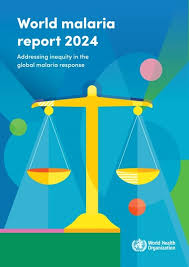
- 12 Dec 2024
In News:
The World Malaria Report 2024 released by the World Health Organization (WHO) highlights significant progress in malaria control, particularly in India, but underscores the continued burden of malaria in Southeast Asia, where India accounts for half of all malaria cases.
About Malaria:
- Cause: Malaria is caused by Plasmodium parasites, primarily P. falciparum and P. vivax, transmitted through bites from infected female Anopheles mosquitoes.
- Transmission: Non-contagious; transmitted via mosquito bites.
- Symptoms: Fever, chills, and headaches appear 10–15 days after the mosquito bite. In some individuals, the symptoms may be mild.
- Prevention: Includes vector control strategies like insecticide-treated bed nets and indoor spraying. Malaria is treatable with early diagnosis and prompt medication.
India’s Malaria Status:
- Progress:
- India has made significant strides in reducing malaria, with cases decreasing from 22.8 million in 2000 to 4 million in 2023, a reduction of 82.4%.
- Similarly, malaria-related deaths dropped by 82.9%, from 35,000 in 2000 to 6,000 in 2023.
- Exit from High-Burden-High-Impact (HBHI) Group:
- India exited this group in 2024, signaling its success in reducing malaria burden.
- Cases dropped by 69% (from 6.4 million in 2017 to 2 million in 2023), and deaths fell by 68% (from 11,100 to 3,500 in the same period).
Key Strategies Behind India's Success:
- Artemisinin-Based Combination Therapy (ACT): Used to treat malaria effectively.
- Long-Lasting Insecticidal Nets (LLIN): Widely deployed to control mosquito populations.
- Targeted Interventions: Focused on forested and tribal areas where malaria transmission is higher, particularly in states like Jharkhand, Odisha, and the North-East.
- Effective Monitoring: Ensures proper implementation of strategies and interventions.
WHO's Global Malaria Report 2024 Highlights:
- Global Burden: In 2023, there were 263 million malaria cases globally and 597,000 deaths. The African region remains the hardest hit, accounting for 95% of malaria deaths.
- Progress Since 2000: Malaria incidence and deaths have significantly decreased. The global number of malaria cases and deaths dropped substantially, with over 2.2 billion cases and 12.7 million deaths averted.
- Malaria-Free Countries: As of November 2024, 44 countries and one territory, including Egypt, have been certified malaria-free.
- Emerging Threats: Drug resistance (especially to Artemisinin) and insecticide resistance are growing concerns, affecting control efforts.
India and Southeast Asia:
- India contributes nearly half of the malaria cases in Southeast Asia, while Indonesia accounts for about one-third. Despite progress, India and Indonesia together accounted for 88% of malaria deaths in the region.
- South-East Asia Progress: The region reduced malaria cases by 82.4% from 22.8 million in 2000 to 4 million in 2023. Timor-Leste and Bhutan reported zero indigenous malaria cases in 2023.
Global Recommendations:
- WHO stresses the need for continued investment, innovative strategies, and targeted actions, especially in high-burden areas like Africa, to sustain progress and tackle remaining challenges, such as drug resistance, insecticide resistance, and new vector species like Anopheles stephensi, which thrives in urban areas.
Ayush Visa

- 11 Dec 2024
In News:
- Recently, the government introduced a separate category of Ayush Visa for foreigners seeking treatment under the Ayush systems of medicine (Ayurveda, Yoga, Unani, Siddha, and Homeopathy).
- The Ayush Visa is available in four sub-categories:
- Ayush Visa: For foreigners visiting India for therapeutic care and wellness treatment in accredited hospitals/wellness centers.
- Ayush Attendant Visa: For attendants accompanying patients seeking Ayush treatment.
- e-Ayush Visa: An electronic version of the Ayush Visa for convenience.
- e-Ayush Attendant Visa: For attendants accompanying patients on an e-Ayush Visa.
- Visa Statistics (as of December 4, 2024):
- 123 regular Ayush visas have been issued.
- 221 e-Ayush visas issued.
- 17 e-Ayush attendant visas issued.
- Advantage Healthcare India Portal:
- The Ministry of Health and Family Welfare launched the Advantage Healthcare India portal, an official platform for Medical Value Travel (MVT).
- The portal facilitates information for international patients seeking medical treatment and wellness services in India.
- The website for accessing the portal is www.healinindia.gov.in.
- Government's Objectives: The government aims to sensitize stakeholders involved in MVT, including Ayush facility providers, to ensure smooth services for international patients.
AgeXtend
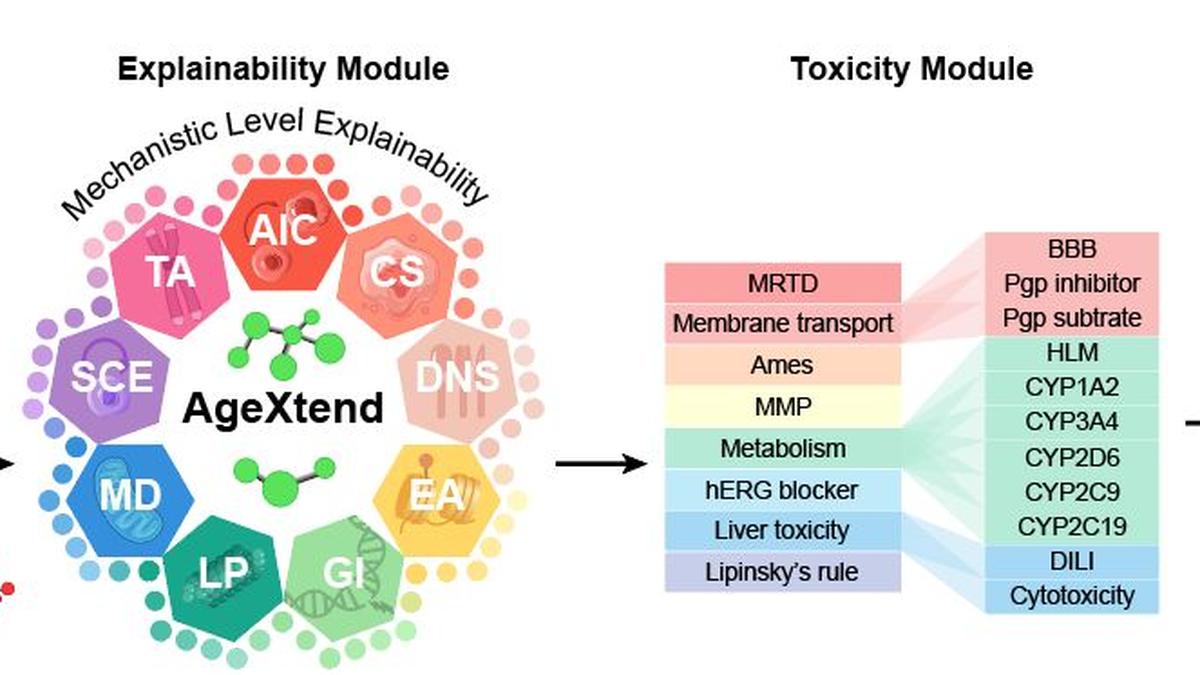
- 11 Dec 2024
In News:
- AgeXtend is developed by researchers at Indraprastha Institute of Information Technology – Delhi (IIIT-Delhi) to rapidly identify age-defying compounds, known as geroprotectors, to promote healthy aging.
Key Features of AgeXtend:
- What is AgeXtend?
- An AI-based platform designed to discover compounds with geroprotective (anti-aging) properties.
- Objective: To accelerate the identification of molecules promoting longevity by reducing the time and effort compared to conventional research methods.
- Development: Developed by researchers from the Indraprastha Institute of Information Technology (IIIT), Delhi.
- Working Mechanism:
- Scans over 1.1 billion compounds to predict, analyze, and validate molecules with anti-aging potential.
- Utilizes machine learning to determine efficacy, safety, and mechanisms of action.
- Experimental validation conducted using yeast, worms (C. elegans), and human cell models.
- Significance:
- The largest study on longevity, including compounds from commercial drugs, FDA-approved drugs, Ayurvedic, and Chinese medicine.
- Provides a scientific rationale for identifying geroprotective compounds, aiding targeted research.
- Open-source code and data promote collaboration and allow commercial exploration.
Platform Capabilities:
- AI Analysis:
- Uses bioactivity data from existing geroprotectors to predict new compounds with similar properties.
- Evaluates geroprotective potential, toxicity, and identifies target proteins and mechanisms of action for accuracy and safety.
- Unique Feature: Explains why a compound is considered geroprotective, revealing underlying mechanisms.
- Example Validation: Successfully identified benefits of metformin and taurine without prior knowledge, confirming the platform’s predictive power.
- Study Scale: The study involved scanning over 1.1 billion molecules, making it the largest study on longevity to date.
Open-Source and Commercial Use:
- Availability:
- The code and data are available as open-source for researchers and students. Commercial access is available for a fee.
- A Python package for AgeXtend is available via pip on pypi.org.
- Further Collaboration: The researchers have reached out to pharma companies to further investigate promising compounds.
- Exploring Natural Compounds: AgeXtend also explores natural compounds from the human microbiome, investigating their role in controlling cell aging.
Governor of the Reserve Bank of India (RBI)
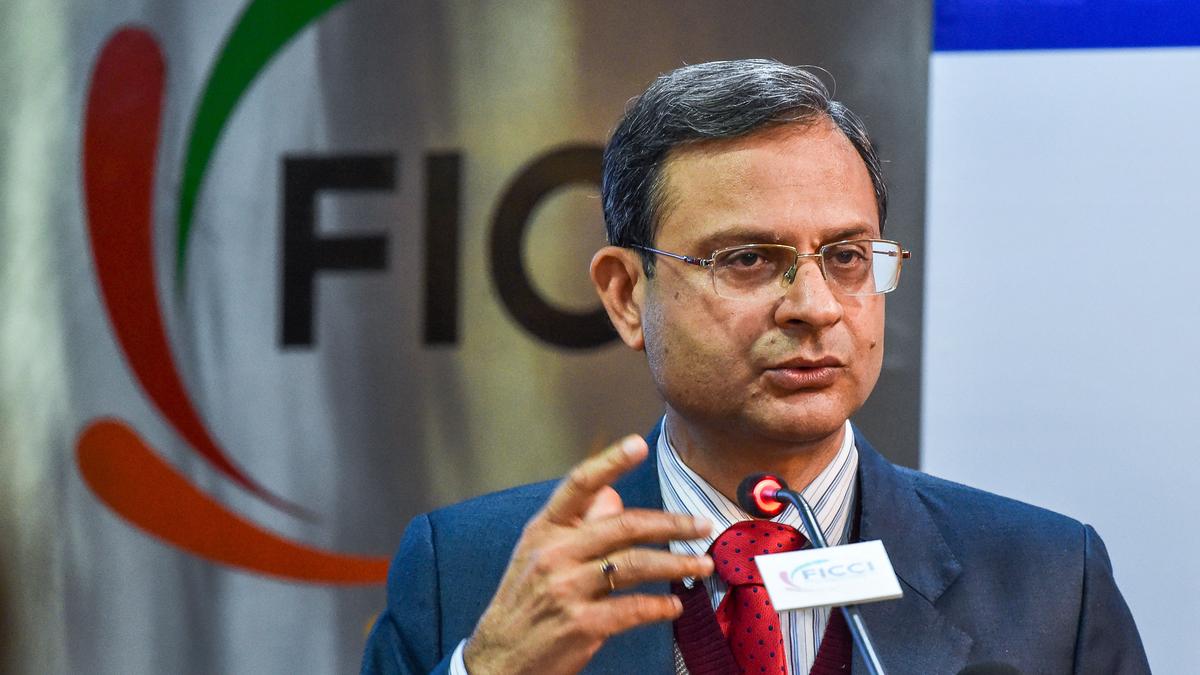
- 10 Dec 2024
In News:
Recently, the Government of India announced the appointment of Sanjay Malhotra as the 26th Governor of the Reserve Bank of India (RBI). He replaces Shaktikanta Das, whose six-year tenure ends on December 10, 2024.
Background of Sanjay Malhotra:
- Education & Early Career: Sanjay Malhotra is a 1990-batch IAS officer from the Rajasthan cadre. He holds a degree in Computer Science Engineering from the Indian Institute of Technology (IIT) Kanpur and a Master’s in Public Policy from Princeton University.
- Professional Experience: Malhotra has over 33 years of experience in various sectors including power, finance, taxation, information technology, and mines. He is currently serving as the Revenue Secretary in the Ministry of Finance, a position he has held since October 2022. Prior to this, he was Secretary of the Department of Financial Services.
- Monetary Policy and Challenges: As RBI Governor, Malhotra will inherit the responsibility of steering India's monetary policy, especially as inflation has been a persistent issue and economic growth has slowed. His first monetary policy review is expected in February 2025.
About the Appointment Process:
RBI Governors are appointed by the Government of India, and the appointment process involves the Financial Sector Regulatory Appointment Search Committee, which includes the Cabinet Secretary, the current RBI Governor, the Financial Services Secretary, and two independent members. The committee prepares a list of eligible candidates, interviews them, and the final decision is made by the Cabinet Committee on Appointments, chaired by the Prime Minister.
RBI Governors Eligibility Criteria
- The RBI Act, 1934 does not mention any specific qualification for the governor. People with different educational backgrounds were selected to head the institution. However, the governor traditionally is either a civil services personnel or an economist.
- Candidates should have prior experience in areas such as:
- Working with the International Monetary Fund (IMF) or World Bank.
- Serving as Chairman or General Manager of a bank.
- Holding significant positions in reputable financial or banking organizations.
- Working in the Ministry of Finance of the Government of India.
- The candidate must be an Indian citizen aged 35 years or older.
- The candidate cannot be a member of Parliament, State Legislature, or hold any other office for profit
Key Responsibilities of the RBI Governor:
- Monetary Policy: The RBI Governor chairs the Monetary Policy Committee (MPC), which is responsible for setting benchmark interest rates and managing inflation.
- Regulation of Financial Institutions: The Governor oversees the regulation of banks, non-banking financial companies (NBFCs), and other financial institutions.
- Currency Management: The Governor ensures the proper issuance of currency and the withdrawal of unfit notes.
- Crisis Management and Policy Execution: The Governor is pivotal in managing financial crises and ensuring the execution of policies related to foreign exchange and financial inclusion.
Reforms in Merchant Shipping
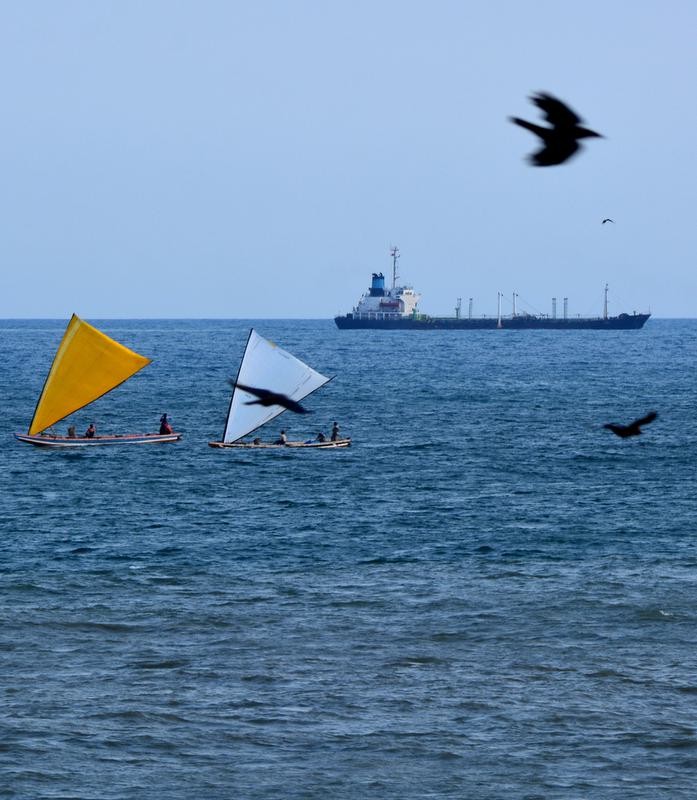
- 10 Dec 2024
In News:
The Government is preparing to introduce several significant bills aimed at driving much-needed reforms in the shipping industry. Key among them are the Merchant Shipping Bill, 2024 and the Coastal Shipping Bill, 2024, both of which promise to bring transformative changes to boost the sector.
Context and Need for Reforms:
- Outdated Framework: The Merchant Shipping Act, 1958, and the Coasting Vessels Act, 1838, fail to address the current needs of the shipping sector, particularly offshore vessels.
- Regulatory Gaps: Inadequate regulation of offshore vessels, maritime training institutions, and welfare provisions for seafarers on foreign-flagged ships.
- Global Alignment: Need to align with international maritime conventions and modernize administration for competitiveness and better governance.
- Investment and Growth: Outdated laws hinder foreign investment and ease of doing business, necessitating a regulatory overhaul.
Key Features of the Merchant Shipping Bill, 2024:
- Ease of Vessel Registration:
- Reduces ownership threshold for Indian entities from 100% to 51%, enabling NRIs, OCIs, and foreign entities to invest.
- Facilitates registration of vessels chartered by Indian entities under the "bareboat charter-cum-demise" system, promoting capital-deficient entrepreneurs.
- Temporary registration provisions for vessels destined for demolition, boosting India's ship recycling industry.
- Expansion of Vessel Scope:
- Broadens the definition of "vessel" to include all types of mechanized and non-mechanized crafts, such as submersibles, hydrofoils, and Mobile Offshore Units (MOUs).
- Ensures comprehensive regulatory oversight, particularly in the offshore sector, enhancing transparency and safety.
- Coastal Security:
- Strengthens coastal security by empowering authorities to issue instructions to all types of vessels, addressing vulnerabilities highlighted by incidents like the 26/11 Mumbai attacks.
- Marine Pollution Measures:
- Incorporates global standards like the MARPOL convention to address marine pollution.
- Introduces measures such as reducing sulphur content in marine fuel and banning single-use plastics on Indian ships.
- Launch of the ‘Swachh Sagar’ portal to ensure proper disposal of ship-generated waste.
- Seafarer Welfare:
- Expands welfare provisions to include Indian seafarers working on foreign-flagged ships, offering protections under the Maritime Labour Convention (MLC).
- Ensures better working conditions and safety standards for a growing workforce of Indian seafarers abroad.
- Maritime Training Regulations:
- Establishes a legal framework to regulate maritime training institutions, addressing the rise of unauthorized institutes post-liberalization.
- Ensures standardized, high-quality education and eliminates fraudulent practices.
Coastal Shipping Bill, 2024:
- Focus on Commercial Utilization of Coastal Waters:
- Distinguishes between the technical regulation of ships and the commercial utilization of Indian coastal waters.
- Aims to streamline licensing, operations, and coastal planning, enhancing the integration of inland and coastal shipping.
- Alignment with ‘Sagarmala’ Program: Supports the promotion of coastal shipping through better infrastructure and connectivity, in line with the government's ‘Sagarmala’ initiative, which boosts port connectivity and coastal trade.
International Conventions India Has Ratified:
- MARPOL: Focuses on preventing ship-based pollution.
- Maritime Labour Convention (MLC): Protects seafarers' rights and ensures fair working conditions.
- Bunker Convention: Addresses liability for oil pollution damage.
- Wreck Removal Convention: Mandates safe removal of shipwrecks.
- Civil Liability Convention: Establishes liability for oil pollution incidents.
Significance of the Reforms:
- Modernized Framework: Aligns India’s maritime laws with global standards for enhanced competitiveness.
- Economic Growth: Encourages foreign investment and entry into the shipping sector by removing regulatory barriers.
- Environmental Sustainability: Focus on combating marine pollution and ensuring sustainable shipping practices.
- Enhanced Safety and Security: Strengthens coastal security and ensures stringent safety regulations for vessels.
- Seafarers’ Welfare: Extends benefits and protections to Indian seafarers working globally, ensuring better working conditions.
- Maritime Education: Provides a robust regulatory framework to ensure high-quality, standardized maritime training.
Community and Individual Forest Rights in Anamalai Tiger Reserve (ATR)
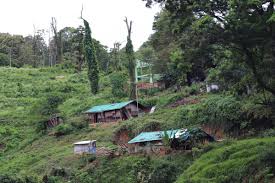
- 08 Dec 2024
In News:
- The Coimbatore District Collector, granted community and individual forest rights under the Forest Rights Act, 2006, to tribal settlements in the Anamalai Tiger Reserve (ATR) on December 6, 2024.These rights were handed over to three tribal settlements and 14 families at a function in Coimbatore.
Key Highlights:
- Community Forest Rights:
- Three tribal settlements in ATR—Nagaroothu I, Nagaroothu II, and Chinnarpathi—were granted community rights.
- These rights allow the settlements to collect forest produce excluding timber, such as mango, amla, honey, tamarind, and grass for making brooms.
- Individual Forest Rights:
- Individual rights were granted to 14 families from the Old Sarkarpathy tribal settlement.
- The families had requested these rights for traditional cultivation practices passed down by their ancestors.
- The individual rights were approved after the recommendation of a sub-divisional committee and scrutiny by a district-level committee.
- About the Forest Rights Act (FRA), 2006:
- Purpose: The FRA was enacted to address historical injustices faced by forest-dwelling communities and ensure their livelihood and food security.
- Key Provisions:
- Individual Rights: Self-cultivation, habitation, and in-situ rehabilitation.
- Community Rights: Access to grazing, fishing, water bodies in forests, and protection of traditional knowledge and customary rights.
- Eligibility: Rights can be claimed by any community or individual who has lived in the forest for at least three generations (75 years) before December 13, 2005.
- Critical Wildlife Habitats: The Act mandates that critical wildlife habitats in national parks and sanctuaries remain inviolate for wildlife conservation.
- Authorities Involved in Vesting Forest Rights:
- Gram Sabha: Initiates the process for determining the nature and extent of rights.
- Sub-Divisional Level Committee: Examines resolutions passed by the Gram Sabha.
- District Level Committee: Grants final approval for forest rights.
- Challenges with Forest Rights Implementation:
- The Xaxa Committee pointed out several challenges in the implementation of the FRA, such as:
- Arbitrary rejection of claims.
- Lack of deadlines for claims processing.
- Unaddressed rights of communities displaced by development projects.
- The Xaxa Committee pointed out several challenges in the implementation of the FRA, such as:
- About Anamalai Tiger Reserve:
- Located in the Anamalai Hills of Pollachi and Coimbatore District, Tamil Nadu, at an altitude of 1,400 meters.
- Established as a tiger reserve in 2007, it is surrounded by multiple protected areas like the Parambikulam Tiger Reserve, Chinnar Wildlife Sanctuary, and Eravikulam National Park.
- Biodiversity in Anamalai Tiger Reserve:
- Habitats: The reserve contains wet evergreen forests, semi-evergreen forests, moist deciduous forests, dry deciduous forests, and unique habitats like montane grasslands and marshy grasslands.
- Flora: The reserve is home to around 2,500 species of angiosperms, including species like balsam, orchids, and wild relatives of cultivated crops such as mango, jackfruit, cardamom, and pepper.
- Fauna: It supports various wildlife species, including tigers, Asiatic elephants, sambars, spotted deer, leopards, jackals, and jungle cats.
RBI Cuts CRR, Keeps Repo Rate Unchanged
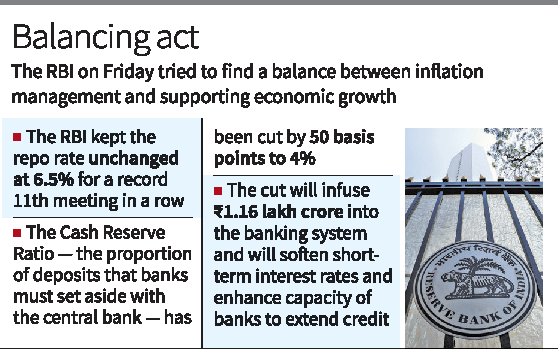
- 07 Dec 2024
In News:
The Reserve Bank of India (RBI) has recently made significant monetary policy decisions that could have a broad impact on the economy.
Key Highlights:
Cut in Cash Reserve Ratio (CRR)
- CRR Reduction: The RBI has reduced the CRR by 50 basis points (bps), from 4.5% to 4%.
- Impact on Banks: This move will free up ?1.16 lakh crore in liquidity, which banks can use to lend, boosting the credit flow in the economy.
- Objective: The CRR cut is aimed at easing the liquidity stress in the financial system, which has been tightening due to RBI's foreign exchange interventions.
- Bank Benefits: Banks will benefit as they don’t earn interest on the CRR, and the extra liquidity may help them reduce deposit rates. Additionally, it may encourage banks to pass on benefits to borrowers, particularly in terms of lending rates.
Repo Rate Kept Unchanged at 6.5%
- Decision: The MPC decided to keep the key policy rate, the Repo rate, unchanged at 6.5%, continuing its stance for the 11th consecutive meeting.
- Reasons for Keeping Repo Rate Steady:
- Persistent inflation, particularly food prices, is a key concern. Despite strong growth in sectors like rural consumption, inflation remains high and continues to affect disposable income.
- RBI Governor emphasized that durable price stability is essential for strong, sustained economic growth.
Impact on Borrowers
- Borrowing Costs: With the Repo rate unchanged, external benchmark lending rates (EBLR) linked to the Repo rate will not rise, providing relief to borrowers by keeping Equated Monthly Installments (EMIs) stable.
- Deposit Rates: However, the CRR cut may lead to a marginal reduction in deposit rates due to increased liquidity in the system.
Economic Growth Forecast Adjusted
- Reduced GDP Growth Estimate: The RBI has downgraded the GDP growth forecast for FY25 to 6.6%, down from the earlier estimate of 7.2%. This revision comes after the economy showed signs of slowdown in the second quarter of FY25.
- Growth Outlook: Despite the downgrade, the RBI remains cautiously optimistic about recovery driven by festive demand and rural consumption. Governor Das indicated that the slowdown had likely bottomed out and the economy is set to recover in the coming quarters.
Inflation Forecast Raised
- Inflation Outlook: The inflation estimate for FY25 has been revised upward to 4.8%, compared to the earlier forecast of 4.5%. This is largely due to rising food prices, which surged to a 14-month high of 6.21% in October.
- Inflationary Pressures: The MPC noted that inflation has remained above the RBI’s target of 4%, primarily driven by food inflation. As inflation impacts consumption, the RBI aims to balance growth support with inflation management.
Monetary Policy Stance
- Neutral Stance Retained: The RBI has maintained a ‘neutral’ stance, meaning it is neither tightening nor easing monetary policy drastically, focusing instead on bringing inflation closer to its target of 4%.
- Inflation Control: While the RBI is aware of the economic slowdown, it continues to prioritize inflation control to ensure price stability and support sustainable growth.
Global and Domestic Economic Context
- Global Factors: The RBI has also been cautious about global developments, including capital outflows and the impact of U.S. monetary policy on the Indian economy. A rate cut could have further weakened the rupee by narrowing the interest rate differential with the U.S.
- Domestic Concerns: Domestically, the economy faces challenges such as weak manufacturing growth and high inflation. The GDP growth in Q2 FY25 dropped to 5.4%, a seven-quarter low, highlighting concerns over demand and inflationary pressures.
BharatiyaVayuyanVidheyak Bill, 2024
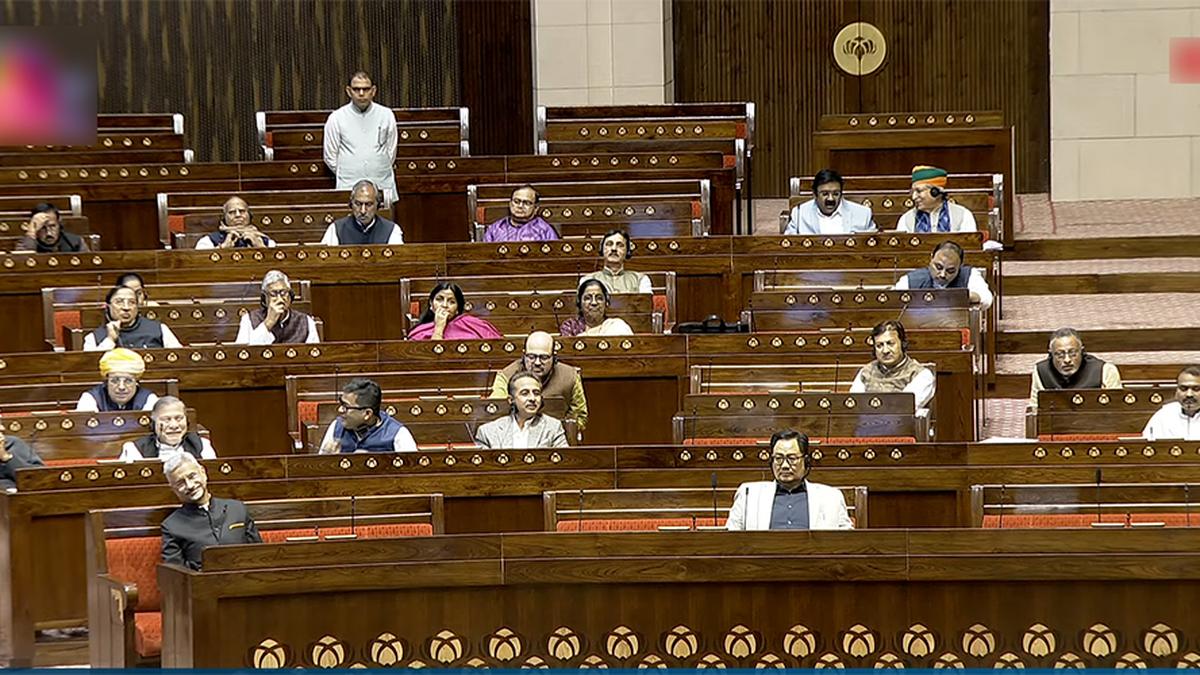
- 06 Dec 2024
In News:
In a significant move, the Indian Parliament passed the BharatiyaVayuyanVidheyak Bill, 2024 on December 5, 2024, bringing much-needed reforms to the aviation sector. The Bill, which replaces the Aircraft Act of 1934, aims to streamline aviation regulations and improve the ease of doing business in the industry.
Key Highlights of the BharatiyaVayuyanVidheyak Bill, 2024:
- Single-Window Clearance for Aviation Personnel: One of the major changes is the transfer of responsibility for the Radio Telephone Operator Restricted (RTR) certification from the Department of Telecom (DoT) to the Directorate General of Civil Aviation (DGCA). This move consolidates the certification process under a single authority, making it easier for aviation personnel like pilots, engineers, and flight dispatchers to obtain their licenses.
- Regulation of Aircraft Design: The Bill not only retains provisions for regulating aircraft manufacturing, maintenance, and repair, but also introduces new provisions to regulate aircraft design and the places where aircraft are designed.
- Enhanced Penalties for Violations: The Bill specifies severe penalties for violations, such as dangerous flying, carrying prohibited items (like arms or explosives), or littering near airports. Offenders may face imprisonment up to three years, fines up to ?1 crore, or both.
- Introduction of Second Appeal Mechanism: For the first time, the Bill introduces a second appeal process against decisions of regulatory bodies like the DGCA and BCAS, ensuring further scrutiny of decisions related to penalties.
- Improved Licensing Process: The shift of the RTR certification process from the DoT to DGCA aims to curb allegations of corruption associated with the previous system, where candidates often had to pay bribes to clear exams.
Organizational Setup and Authorities:
The Bill outlines the establishment of three key authorities under the Ministry of Civil Aviation:
- DGCA: Responsible for civil aviation safety, licensing, and ensuring compliance with international standards.
- BCAS: Ensures aviation security and develops relevant security measures.
- AAIB: Investigates aviation accidents and incidents.
The central government retains supervision over these bodies, with the power to modify or review their orders.
Criticisms and Concerns:
- Lack of Autonomy for DGCA: The DGCA, unlike independent regulators in other sectors (such as telecom or insurance), operates under direct government supervision. The lack of clear qualifications, selection process, and tenure for the DGCA Director General has raised concerns about the regulator's independence.
- Unilateral Appointment of Arbitrators: The Bill empowers the government to unilaterally appoint an arbitrator in certain cases, which has been criticized for potentially violating the right to equality under Article 14 of the Constitution. The Supreme Court has previously ruled that such unilateral appointments may be unconstitutional.
- Discretionary Criminal Penalties: The central government is granted the discretion to impose criminal penalties for rule violations, which some argue could undermine the principle of separation of powers, as it is the legislature's role to define criminal offenses and penalties.
- Exclusionary Hindi Title: Some critics argue that the Hindi title of the Bill may alienate non-Hindi-speaking populations, which make up a significant portion of India’s demographic.
Overview of Global Plastic Treaty Negotiations

- 05 Dec 2024
In News:
The recent negotiations for a global treaty aimed at curbing plastic pollution, held in Busan, South Korea, concluded without reaching a legally binding agreement. This marked the fifth round of discussions since the United Nations Environment Assembly (UNEA) initiated the process in March 2022, with the goal of finalizing a treaty by the end of 2024. The failure to adopt a treaty was primarily due to disagreements over production cap goals and the elimination of specific plastic chemicals and products.
Key Points of Dispute
- Production Cap Goals: A coalition of over 100 countries, including many from Africa, Latin America, and the European Union, pushed for clear production cap goals in the treaty. They argued that such measures are essential for effective regulation of plastic pollution.
- Opposition from Oil-Producing Nations: Conversely, a group of “like-minded countries” such as Saudi Arabia, Kuwait, Russia, and Iran opposed these provisions. They contended that regulating production cuts exceeded the original mandate set by UNEA and could lead to trade restrictions disguised as environmental measures. India and China aligned with this coalition, emphasizing their concerns regarding economic impacts.
Draft Treaty Highlights
Despite the failure to finalize an agreement, discussions produced a draft text that included both consensus points and contentious issues:
- Consensus Points:
- Proposals for banning open dumping and burning of plastics.
- Definitions for various plastic types were suggested but lacked clarity on contentious terms like microplastics.
- Contentious Issues:
-
- The draft did not adequately address definitions for microplastics or recycling standards.
- References to single-use plastics were included but faced pushback from certain nations.
India’s Position
India articulated its stance focusing on several key areas:
- Development Rights: Emphasized the need for recognizing varying responsibilities among countries in managing plastic pollution while considering their developmental rights.
- Technical and Financial Support: Advocated for provisions ensuring technical assistance and financial support for developing nations to manage plastic waste effectively.
- Opposition to Production Caps: India opposed any articles that would impose caps on polymer production, arguing that such measures were not directly linked to reducing plastic pollution.
Future Steps
The negotiations will continue with plans to reconvene in 2025. In the meantime, global plastic production is projected to rise significantly, potentially tripling by 2050 if no urgent action is taken. The ongoing dialogue will need to address both environmental concerns and developmental needs to create a balanced approach toward managing plastic pollution globally.
Global Context and Initiatives
The need for a global treaty is underscored by alarming statistics:
- Over 462 million tons of plastic are produced annually, with a significant portion contributing to pollution.
- Microplastics have infiltrated ecosystems worldwide, affecting biodiversity and human health.
Countries like Rwanda and Austria have implemented successful measures to reduce plastic waste, serving as models for global efforts. Initiatives such as the UNDP Plastic Waste Management Program in India aim to enhance waste management practices while addressing environmental impacts.
ICJ Hearing on Landmark Climate Change Case

- 04 Dec 2024
In News:
- The International Court of Justice (ICJ) has begun hearings on a landmark climate change case, seeking an advisory opinion on the obligations of countries under international law regarding climate change.
- The case stems from a UN General Assembly (UNGA) resolution initiated by Vanuatu in March 2023, co-sponsored by 132 countries.
Background:
- Vanuatu, a small island nation, faces existential threats from rising sea levels.
- The resolution was passed to clarify climate obligations in light of international laws, including the UNFCCC, Paris Agreement, and other legal instruments like the UN Convention on the Law of the Seas, and the Universal Declaration on Human Rights.
Global Impact of the Case:
- The outcome of the case could influence global climate governance, particularly in the context of climate negotiations.
- It may broaden the legal basis for climate obligations and underscore the legal consequences for non-compliance.
India’s Position:
- India has voiced concerns about the judicial process being the best approach to tackle climate issues, advocating for diplomatic efforts.
- India is scheduled to make its submission on December 5, highlighting its preference for a collaborative, non-top-down approach in climate discussions.
Implications for Developed and Developing Countries:
- The case highlights the historical responsibility of developed countries for climate change due to their higher emissions.
- The ICJ's advisory opinion could reinforce the argument that developed countries' obligations extend beyond the UNFCCC and Paris Agreement, incorporating broader international legal frameworks.
Climate Litigation and Precedent:
- The ICJ ruling could set a precedent for climate litigation, potentially influencing over 2,600 ongoing climate lawsuits globally.
- Notable rulings include the European Court of Human Rights, which held Switzerland accountable for failing to meet emissions targets, and India's Supreme Court recognizing the right to be free from adverse climate impacts in 2023.
Record Participation and Importance of the Case:
- The ICJ has received over 90 written submissions, with 97 countries and 12 international organizations participating in the hearings.
- The case is significant for the growing number of climate-related lawsuits and the evolving nature of international climate law.
Future Prospects:
- The ICJ’s advisory opinion, though non-binding, could significantly impact future climate negotiations, particularly in terms of responsibility sharing and climate finance.
- The outcome could also influence calls for compensation for climate damages, especially from vulnerable states like small island nations.
Places of Worship (Special Provisions) Act, 1991

- 04 Dec 2024
In News:
The Places of Worship (Special Provisions) Act, 1991, is once again in focus, albeit in a context in which its objectives are being ignored. Civil suits questioning the religious character of mosques at Varanasi and Mathura are progressing apace. These developments show that legislation freezing the status of places of worship is inadequate to stop Hindu claimants from making determined legal efforts to achieve their goal of replacing them with temples.
Places of Worship (Special Provisions) Act, 1991:
- Objective: To preserve the religious character of places of worship as they existed on August 15, 1947, and prevent changes in religious identity.
- Key Provisions:
- Section 3: Prohibits conversion of a place of worship from one religion to another.
- Section 4(1): Ensures the religious character remains unchanged from August 15, 1947.
- Section 4(2): Terminates ongoing or future legal proceedings seeking to alter the religious character of a place of worship.
- Exemptions:
- Ayodhya dispute: Exempted, allowing ongoing litigation.
- Ancient monuments & archaeological sites: Not covered by the Act.
- Already settled disputes or those agreed upon before the Act came into force.
- Penalties: Violators can face up to 3 years of imprisonment or fines.
- Criticism: The Act has been challenged for limiting judicial review, imposing a retrospective cutoff date, and restricting religious rights.
Recent Legal Disputes:
- Gyanvapi Mosque (Varanasi):
- Claim: Hindu worshippers assert the right to worship deities (e.g., Ma Sringar Gauri, Lord Vishweshwar) within the mosque premises.
- Legal Basis: Claim that the mosque was built over an ancient Hindu temple.
- Court's Ruling: The court allows the case to proceed, stating that the aim is to assert worship rights, not change the mosque’s status.
- Archaeological Survey: ASI report confirms the existence of a temple before the mosque’s construction.
- Key Legal Outcome: The Places of Worship Act does not bar these suits as they aim to ascertain the religious character of the site, not alter it.
- Shahi Idgah Mosque (Mathura):
- Claim: Hindu groups assert the mosque was built over Lord Krishna’s birthplace.
- Historical Context: The dispute was settled by a compromise in 1968, which was implemented in 1974, where part of the land was given to the mosque.
- Current Legal Dispute: New suits challenge the 1968 agreement as ‘fraudulent’ and seek the entire land to be transferred to the deity.
- Court's Ruling: The Act is not applicable as the 1968 agreement predates the 1991 Act, and the dispute pertains to the compromise, not the religious character.
- Shahi Jama Masjid (Sambhal, Uttar Pradesh):
- Claim: Allegation that the mosque was built over a Hindu temple (Hari Har Mandir).
- Survey Request: Petitioners seek a survey to verify the site’s historical and religious character.
- Legal Context: The mosque is a protected monument under the Ancient Monuments Preservation Act, 1904.
Key Legal Interpretations:
- Court’s Role: Courts have ruled that the Places of Worship Act does not prohibit suits related to the religious character of a site if they are aimed at determining, not altering, that character.
- Interpretation of ‘Religious Character’: The Allahabad High Court stated that a structure can’t have dual religious character (both Hindu and Muslim), and the religious character of a place must be determined through evidence.
Political and Social Implications:
- Ongoing Controversy: The Gyanvapi and Mathura mosque disputes continue to fuel political and religious debates, as Hindu organizations seek to assert their claims, while mosque committees and Muslim groups resist changes.
- Public and Legal Attention: The legal and political landscape surrounding the Places of Worship Act remains contentious, with several legal suits challenging its applicability.
1984 Bhopal disaster
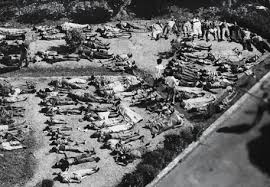
- 04 Dec 2024
In News:
Forty years after the Bhopal disaster on December 2-3, 1984, several hundred tonnes of toxic waste still remain around the ill-fated Union Carbide plant.
Overview of the incident:
The 1984 Bhopal disaster, one of the world’s worst industrial accidents, was caused by the release of methyl isocyanate (MIC) gas, which was a key component in the production of pesticides at the Union Carbide India Limited (UCIL) plant. However, the toxic legacy of the disaster extends far beyond MIC, with a range of other harmful substances lingering in the environment. These include:
- Methyl Isocyanate (MIC):Primary toxic agent: MIC is a highly toxic, volatile compound. Exposure can cause severe respiratory distress, eye irritation, pulmonary edema, and even death.
- Heavy Metals:The site of the plant is contaminated with various heavy metals, including:
- Mercury: Known to accumulate in the body and affect the nervous system, kidneys, and liver. Even small doses over time can lead to chronic health problems.
- Chromium: Exposure to high levels of chromium, particularly hexavalent chromium, is associated with lung cancer and damage to the respiratory system.
- Lead: A potent neurotoxin, lead can cause developmental delays, memory problems, and damage to the kidneys.
- Nickel: Can cause respiratory and lung cancers when inhaled in significant quantities.
- Copper: High levels of copper exposure can damage the liver and kidneys.
- Organic Compounds:Several organic chemicals were found at the site, including:
- Hexachlorobutadiene: A suspected carcinogen that can cause liver damage, kidney damage, and neurological issues upon exposure.
- Chloroform (Trichloromethane): Known for its effects on the central nervous system, exposure can lead to dizziness, loss of consciousness, and even death at high concentrations. It is also a possible carcinogen.
- Carbon Tetrachloride: A potent liver toxin, exposure can result in liver damage, cancer, and nervous system toxicity.
- Trichlorobenzene: These compounds are volatile and can spread through air and water, accumulating in fatty tissues and causing damage to organs like the liver and kidneys.
- Persistent Organic Pollutants (POPs):Some of the contaminants, particularly the organic compounds, are classified as persistent organic pollutants, which do not degrade easily in the environment. These can lead to:
- Cancer: Several of these compounds are carcinogenic.
- Neurological damage: Prolonged exposure can affect both the central and peripheral nervous systems.
- Reproductive and developmental disorders: Exposure has been linked to adverse effects on fertility and developmental health in humans.
- Environmental and Long-term Health Effects:
- Even decades later, contamination continues to affect the health of people living around the site, with high rates of cancers, birth defects, respiratory diseases, and other health issues. Water sources in the region remain unsafe due to heavy contamination with toxic chemicals. Persistent organic pollutants have been identified in local communities, indicating that the contamination continues to spread.
26 Rafale-Marine Jets
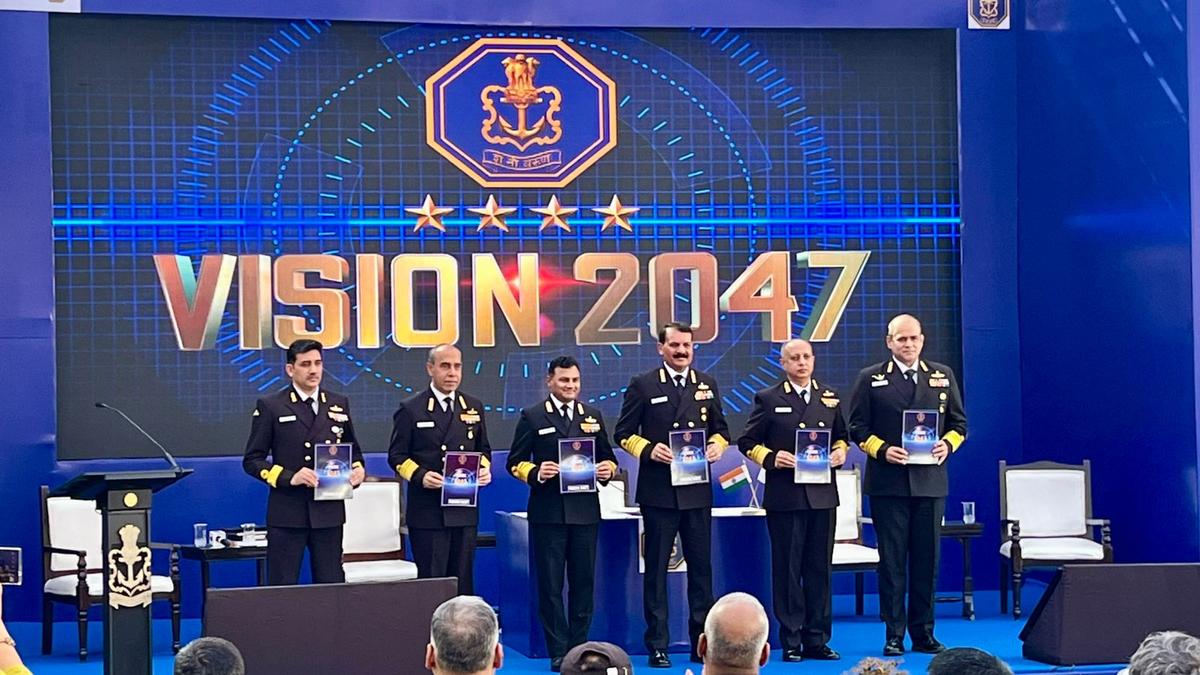
- 03 Dec 2024
In News:
- Deal for 26 Rafale-M jets nearing completion, with final formalities expected to be completed by January 2025.
- These jets are designed for naval operations and will be deployed on INS Vikrant and INS Vikramaditya.
- Rafale-M Features: Multi-role, advanced avionics, AESA radar, and armaments like Meteor, MICA, SCALP, EXOCET.
- Three Scorpene Submarines: Additional three Scorpene-class submarines to be procured from France.
- These are part of a repeat order to Mazagon Dock Shipbuilders Limited (MDL), with five of the earlier six already inducted into service.
Nuclear Capabilities:
- INS Arighaat: Successfully fired a Submarine-Launched Ballistic Missile (SLBM), marking a significant milestone for India's nuclear deterrence.
- Indigenous Nuclear Attack Submarine (SSN): India’s first indigenous SSN expected by 2036-37.
Strategic Maritime Engagement:
- Indian Ocean Region (IOR): Active monitoring of maritime activities, especially of China's PLA Navy and Chinese research vessels.
- Pakistan Navy Expansion: Acknowledged Pakistan’s efforts to become a 50-ship Navy, including the acquisition of 8 Chinese submarines. Indian Navy is adapting its plans to address this.
Nuclear Submarine Program (SSBN):
- INS Arihant: Conducted multiple deterrence patrols.
- INS Arighaat: Ongoing trials including the recent K4 SLBM test, with a range of 3,500 km.
Naval Vision 2047:
- Navy Chief released Vision 2047 document, outlining the future direction and growth of the Indian Navy.
Bilateral and Multilateral Engagements:
- Participation in various bilateral and multilateral exercises, including RIMPAC 2024 (Hawaii) and Russian Federation Navy’s Raising Day (St. Petersburg).
MahaKumbh Mela 2025
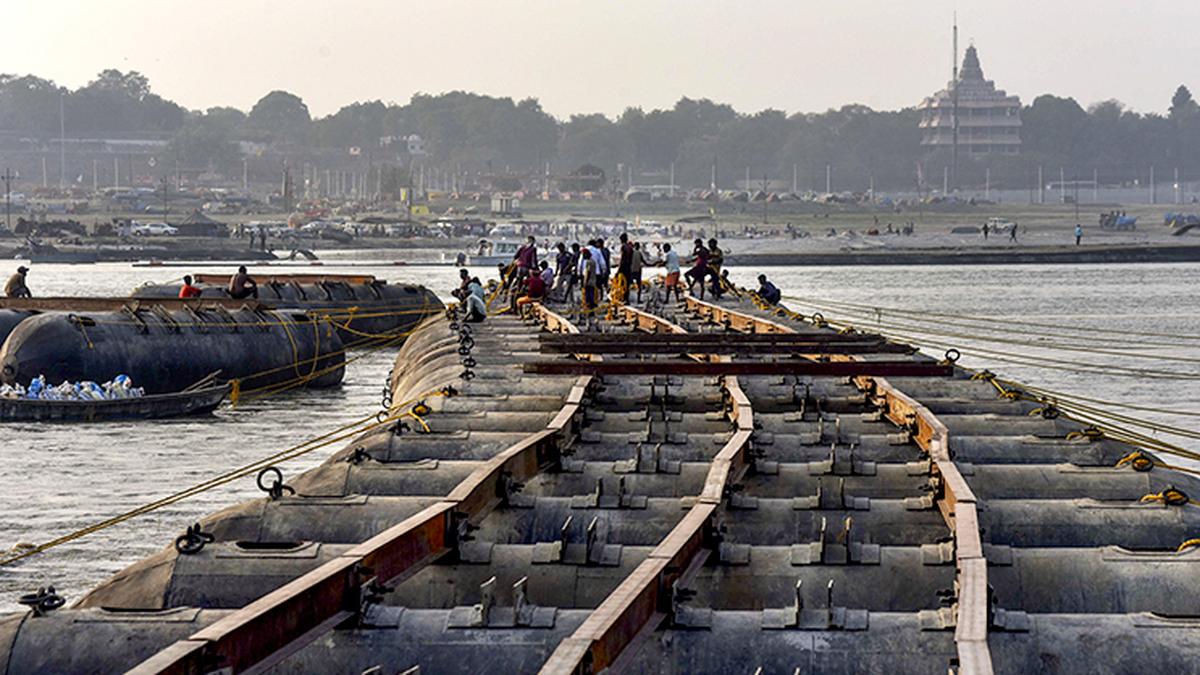
- 03 Dec 2024
In News:
- On December 1, 2024, the Uttar Pradesh government declared the MahaKumbh Mela area as a temporary district for four months.
- The new district will be known as the MahaKumbh Mela District, to streamline management for the 2025 MahaKumbh.
- Over 5,000 hectares of land will be part of this district, including 66 revenue villages from four tehsils: Sadar, Sorav, Phulpur, and Karchana.
Key Administrative Changes:
- Mela Adhikari (Kumbh Mela Officer) will act as the District Magistrate (DM) and will hold powers of Executive Magistrate, District Magistrate, and Additional District Magistrate.
- The Mela Adhikari will have authority under the Indian Civil Defense Code, 2023, and the Uttar Pradesh Revenue Code, 2006.
- The Mela Adhikari can appoint an Additional Collector for the district.
MahaKumbh Mela Overview:
- The Kumbh Mela is recognized by UNESCO as an Intangible Cultural Heritage of Humanity.
- It is the largest peaceful congregation of pilgrims, with participants bathing in sacred rivers at locations including Prayagraj, Haridwar, Ujjain, and Nashik.
- The PrayagrajKumbh takes place at the Sangam, the confluence of the Ganges, Yamuna, and the mythical Saraswati rivers.
- The event spans over a month and includes religious, cultural, and social activities, along with massive infrastructural setup including tented townships, civic facilities, and security measures.
KisanPehchaan Patra
- 02 Dec 2024
In News:
The Indian government is actively promoting the creation of digital identities for farmers through the KisanPehchaan Patra (Farmer ID). The initiative is an essential part of the Digital Agriculture Mission under the AgriStack initiative.
Key Details:
Objective:
- The main goal is to provide digital IDs linked to Aadhaar for farmers, capturing comprehensive agricultural data including land records, crop information, and ownership details.
- These digital identities are designed to enhance farmers' access to government schemes and digital agriculture services.
Farmer ID Creation Timeline:
- The government plans to create digital IDs for 11 crore farmers in phases:
- 6 crore farmers in FY 2024-25.
- 3 crore farmers in FY 2025-26.
- 2 crore farmers in FY 2026-27.
AgriStack Initiative:
- The AgriStack initiative aims to build a Digital Public Infrastructure (DPI) for the agriculture sector, which includes:
- Farmers' Registry.
- Geo-referenced village maps.
- Crop Sown Registry.
Implementation Strategy:
- Camp-mode approach: States have been instructed to organize field-level camps to ensure faster and inclusive registration of farmers.
- Financial Incentives:
- States will receive ?15,000 per camp for organizing these camps.
- Additionally, ?10 per Farmer ID issued.
- Funding is provided through the Pradhan Mantri KisanSamman Nidhi (PM-Kisan) scheme.
Benefits of Digital Farmer ID:
- Targeted Delivery of Benefits: Ensures subsidies and benefits reach legitimate farmers and eliminates duplication.
- Precision Agriculture: Supports data-driven policies for better crop planning, insurance, and market linkages.
- Financial Inclusion: Facilitates easy access to credit, loans, and crop insurance, empowering farmers financially.
- Better Monitoring: Helps in tracking the actual implementation of schemes and ensures that only eligible farmers benefit.
Progress in States:
- Advanced States: Gujarat, Madhya Pradesh, Maharashtra, and Uttar Pradesh have made significant progress in issuing digital Farmer IDs.
- Testing Phase: States like Assam, Chhattisgarh, and Odisha are still in the field-testing phase.
- Special Assistance Scheme: The Finance Ministry allocated ?5,000 crore in August 2024 to assist states in creating the Farmers' Registry, with funds available until March 2025.
Linkage with Land Records and Crop Data:
- The Farmer ID integrates with state land records and crop data, creating a dynamic and accurate database known as the Farmer’s Registry.
- This data helps in the development of better agricultural policies and decision-making.
Digital Agriculture Mission:
- The government approved a substantial outlay of ?2,817 crore for the Digital Agriculture Mission, which is intended to modernize agricultural practices and build robust digital infrastructure.
- The mission also includes the launch of the Digital Crop Estimation Survey (DGCES), which will help in crop estimation and better resource allocation.
National Policy on Female Labour Force Participation (FLFP)
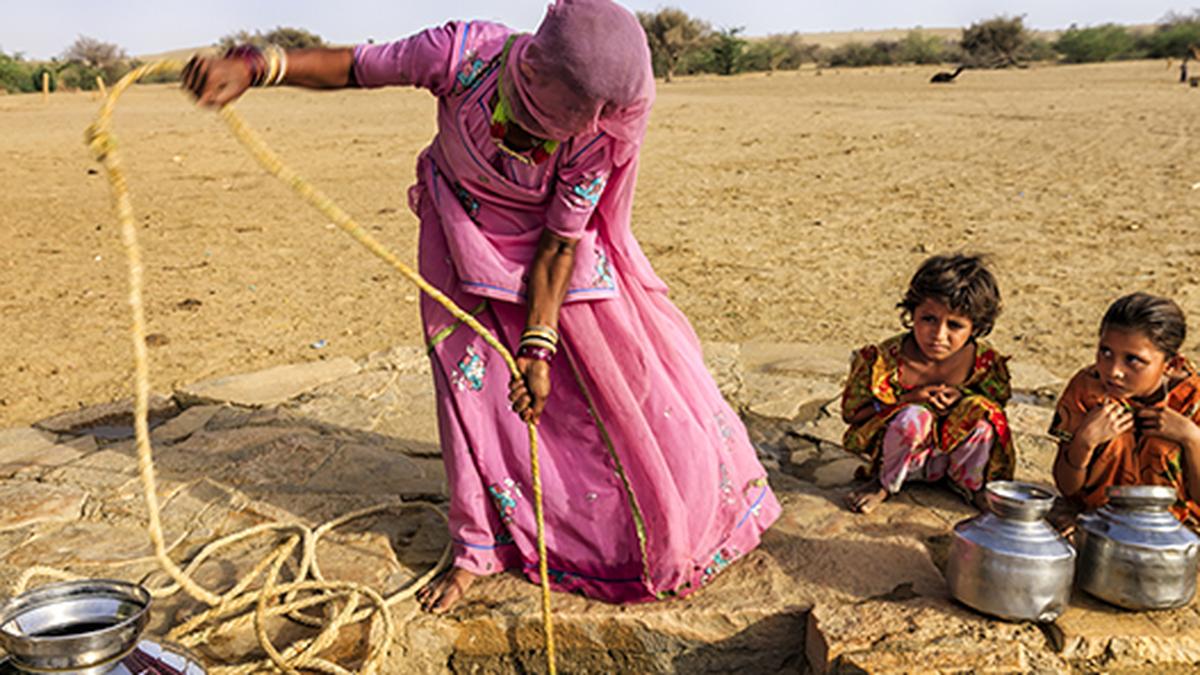
- 02 Dec 2024
In News:
- India is working on a national policy to enhance female labour force participation (FLFP), focusing on creating a supportive care economy structure.
- The policy is being developed by an inter-ministerial team involving the Ministries of Skill Development, Labour, Rural Development, and Women and Child Development.
- Goal: To reduce barriers for women, especially related to caregiving responsibilities, and increase their participation in the workforce.
Key Focus Areas:
- Care Economy: Involves both paid and unpaid caregiving services, such as childcare, eldercare, domestic work, and health services.
- The policy aims to formalize care work, addressing its undervaluation and encouraging women's workforce participation.
- Proposes a core skilling package for caregivers, particularly for childcare in rural and informal sectors.
- Childcare Facilities: Targeting women working under schemes like MGNREGS (Mahatma Gandhi National Rural Employment Guarantee Scheme).
Current Challenges:
- Post-marriage employment drop: Women face a significant decline in workforce participation after marriage, often due to caregiving roles.
- In India, 53% of women are outside the labour force, mostly due to unpaid domestic work, unlike only 1.1% of men.
- The gender divide in caregiving is stark: Women spend over 5 hours daily on unpaid domestic work (81% of females), compared to 12.4% of males.
Key Initiatives:
- Palna Scheme: Provides daycare through Anganwadi-cum-Crèche facilities for working parents, benefiting children aged 6 months to 6 years. 1,000 crèches are operational.
- Women’s Employment Data:
- In rural India, 36.6% of women participate in the workforce, compared to 23.8% in urban areas.
- Post-marriage, female employment drops by 12 percentage points, even without children.
- Improving Female Labour Force Participation (FLFP): Key to India's growth, as matching women’s workforce participation with men could boost GDP by 27% (IMF).
Barriers to Women’s Workforce Inclusion:
- Unpaid Care Work: Women's disproportionate share of household duties limits paid employment opportunities.
- Cultural Norms: Gender expectations restrict women’s access to employment, especially in rural areas.
- Educational Barriers: Limited access to education for girls restricts skill development, lowering job prospects.
- Health & Safety Issues: Health challenges and safety concerns at workplaces hinder women's workforce participation.
- Lack of Supportive Policies: Absence of parental leave and flexible work arrangements for women, especially in the informal sector.
Government Initiatives for Women’s Employment:
- BetiBachaoBetiPadhao: Promotes girl child education and empowerment.
- National Education Policy (NEP): Ensures gender equity in education.
- Maternity Benefit (Amendment) Act, 2017: Extends paid maternity leave to 26 weeks and mandates crèche facilities in large establishments.
- Labour Codes (2019-2020): Codifies labor laws to provide a framework for improving women’s workplace safety and employment opportunities.
Global Examples & Inspiration:
- Japan’s Womenomics: Aimed at increasing female participation, Japan's womenomics reforms have grown women’s labour force participation from 64.9% to 75.2% (2013-2023).
- Flexible Work Models: Countries like Netherlands encourage part-time and remote work, offering flexibility to manage work-life balance.
- Sweden’s Investment in ECCE: Investing 1% of GDP in Early Childhood Care and Education (ECCE) has significantly reduced women’s workforce exclusion.
Way Forward:
- National Women’s Urban Employment Guarantee Act (WUEGA): Promotes gender-balanced work environments and childcare facilities at work sites.
- Flexible Work Options: Encouraging remote work, parental leave, and childcare support will empower more women to balance caregiving and employment.
- Investment in the Care Economy: To reduce the care burden on women, substantial investment in ECCE and related sectors is essential to increase women’s participation and economic independence.
Shahi Jama Masjid in Sambhal
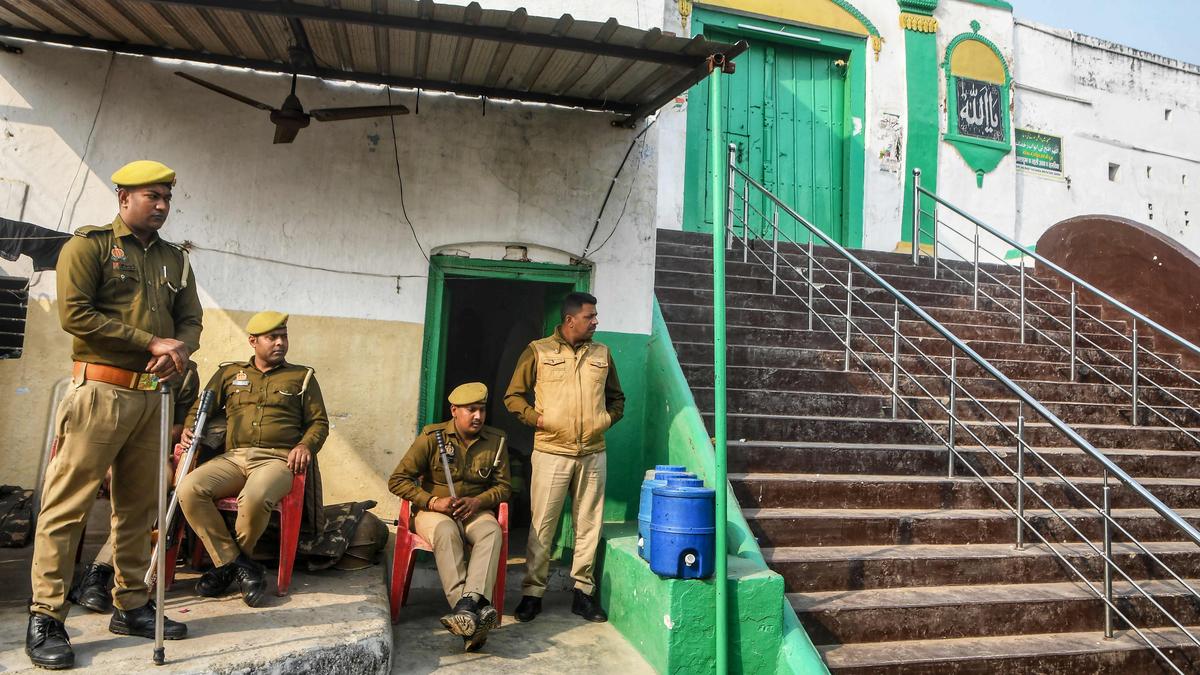
- 01 Dec 2024
In News:
The controversy surrounding the Shahi Jama Masjid in Sambhal, Uttar Pradesh, has intensified following claims that the mosque, built during the Mughal Emperor Babur's reign (1526–1530), was constructed over a Hindu temple, the Hari Har Mandir. This claim has led to legal battles and violent clashes, making it part of a broader series of disputes involving mosques built during the Mughal era, such as the Gyanvapi mosque in Varanasi and the Eidgah Masjid in Mathura.
Background and Legal Context:
The dispute began when a petition was filed in Sambhal's district court on November 19, 2024, claiming the Jama Masjid was built on the site of an ancient temple. The petitioners, led by Hari Shanker Jain, demanded a survey to ascertain the religious character of the site. This petition follows a pattern seen in similar cases in Varanasi, Mathura, and Dhar, where Hindu groups have raised similar claims about mosque sites. The court ordered a photographic and videographic survey of the mosque, which, initially carried out peacefully, later sparked violence on November 24 when the survey was accompanied by chanting crowds. This led to protests, stone pelting, and allegations of police firing, resulting in several deaths.
The Jama Masjid is a protected monument under the Ancient Monuments Preservation Act, 1904, and is listed as a Monument of National Importance by the Archaeological Survey of India (ASI). This gives the case legal and cultural sensitivity, as it involves both national heritage and religious sentiments.
Historical and Architectural Context:
The Shahi Jama Masjid in Sambhal was constructed by Mir Hindu Beg, a general under Babur, in the early 16th century. It is one of three mosques commissioned by Babur, alongside those in Panipat and Ayodhya. The mosque is noted for its architectural style, which includes a large square mihrab hall, a dome, and arches, constructed using stone masonry and plaster. Some historians argue that the mosque might be a Tughlaq-era structure modified during Babur's reign. Locally, Hindu tradition holds that the mosque incorporates elements of a Vishnu temple, believed to be the site of Kalki, the tenth avatar of Vishnu.
The Places of Worship Act, 1991:
The dispute has reignited debates about the Places of Worship (Special Provisions) Act, 1991, which mandates that the religious character of any place of worship as it existed on August 15, 1947, should be maintained, with the exception of the ongoing Babri Masjid dispute. The Act aims to prevent any further contests regarding religious sites, and Section 3 of the Act explicitly prohibits converting a place of worship into a site of a different religious denomination.
The petition filed in Sambhal seeks to alter the religious character of the mosque, directly contravening the Places of Worship Act. The petitioners have cited remarks by Supreme Court Justice D.Y. Chandrachud in 2022, suggesting that a survey to ascertain the religious character of a place might not violate the Act. This has led to petitions challenging the Act in the Supreme Court, including cases from Varanasi, Mathura, Dhar, and now Sambhal.
The Legal and Social Implications:
The ongoing dispute over the Shahi Jama Masjid highlights the tension between historical narratives, legal frameworks, and communal harmony. The Supreme Court has intervened in the matter, temporarily halting further proceedings in the trial court, urging that the mosque's management committee approach the Allahabad High Court. The Court emphasized the importance of maintaining peace and harmony and cautioned against any actions that could escalate tensions.
The case underscores the challenges of balancing India's rich historical heritage with its diverse religious communities. As the legal process unfolds, the outcome of the Sambhal dispute could set significant precedents for how similar cases are handled in the future.
Conclusion:
The Sambhal mosque dispute, much like the Gyanvapi and Ayodhya cases, brings to the forefront the complex intersections of history, religion, and law. It also raises critical questions about the application of the Places of Worship Act and its implications for preserving India's pluralistic society. The outcome of this case, alongside the pending petitions in other states, will be crucial in shaping the future of religious site disputes in India.
SASCI Scheme for Tourism Development
- 01 Dec 2024
In News:
Centre clears scheme for development of 40 tourist destinations across 23 States at a cost of ?3,295 crore.
Key Details:
- Focus Areas: The scheme encourages the development of lesser-known destinations such as Bateshwar (Uttar Pradesh), Ponda (Goa), Gandikota (Andhra Pradesh), and Porbandar (Gujarat) to reduce overcrowding at popular sites.
- Implementation Timeline: Projects must be completed within two years, with funding released in stages until March 2026.
- Key Features:
- Long-term interest-free loans for 50 years.
- States responsible for project execution and maintenance, often through public-private partnerships (PPP).
- The Ministry of Tourism will monitor progress, and 66% of the funds have already been released.
- Emphasis on sustainability and boosting local economies by creating jobs through tourism.
- States must provide land at no cost and ensure proper infrastructure like safety, connectivity, and utilities.
Selection Criteria for Projects:
- Consultation Process: Detailed regional consultations led to the selection of 40 projects from 87 proposals received by the Ministry of Tourism. West Bengal was the only state not submitting proposals.
- Evaluation Criteria: Projects were evaluated based on:
- Connectivity, tourism potential, and ecosystem.
- Financial viability and sustainability.
- Impact on local economy and job creation.
- Funding Pattern:
- A maximum of ?100 crore for each project, with higher funding considered for exceptional projects.
- Total funding capped at ?250 crore per state, allocated on a first-come, first-served basis.
Importance of the Scheme:
- Economic Growth & Employment: Projects are designed to stimulate local economies, create employment, and promote sustainable tourism.
- Global Branding: The scheme aims to brand and market tourist destinations on a global scale.
- Tourism Infrastructure Growth: It aims to improve the entire tourism value chain, including transportation, accommodation, activities, and services.
Tourism Sector Overview:
- Current Status:
- India ranks 39th among 119 countries in the Travel and Tourism Development Index (TTDI) 2024.
- Foreign Tourist Arrivals (FTAs) increased by 47.9% in 2023, with 9.52 million tourists.
- Tourism contributed 5% to India’s GDP in 2022-23 and created 76.17 million direct and indirect jobs.
- India earned ?2.3 lakh crore in foreign exchange in 2023 through tourism.
- Projected revenue from tourism to exceed $59 billion by 2028.
- Initiatives for Promotion:
- Swadesh Darshan Scheme: To develop theme-based circuits.
- Dekho Apna Desh Initiative (2020): Promotes domestic tourism.
- PRASHAD & HRIDAY Schemes: Focus on pilgrimage and heritage city development.
MGNREGA Job Card Deletions Issue:
- Context: A significant surge in deletions of job cards under MGNREGA (Mahatma Gandhi National Rural Employment Guarantee Act) raised concerns over transparency and workers’ rights.
- Reasons for Deletion:
- Permanent migration, duplicate cards, forged documents, and refusal to work.
- Aadhaar-based payment system (ABPS) implementation led to deletions for non-linked cards.
- Implications:
- Violation of workers’ legal right to employment, especially when deletions were made without due process.
- The "Not willing to work" designation undermines livelihood opportunities, especially in high unemployment rural areas.
- Recommendations for Reform:
- Strengthening verification processes and ensuring deletions follow due procedure.
- Empowering Gram Sabhas to review and approve deletions.
- Regular audits and better grievance redressal mechanisms.
Other Government Initiatives in Tourism:
- National Mission on Pilgrimage Rejuvenation and Spiritual, Heritage Augmentation Drive (PRASHAD): For holistic and sustainable development of pilgrimage tourism.
- Incredible India & E-Visa Initiatives: To attract more foreign tourists.
- Regional Connectivity Scheme (UDAN): Enhances air connectivity to remote tourist destinations.
- National Heritage City Development and Augmentation Yojana (HRIDAY): Preserves and rejuvenates heritage sites.
U.N. Peacebuilding Commission
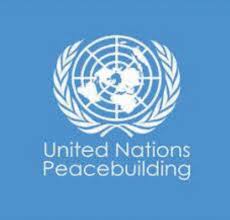
- 30 Nov 2024
In News:
India has been re-elected to the United Nations Peacebuilding Commission (PBC) for the term 2025–2026, continuing its strong commitment to global peace and stability.
UN Peacebuilding Commission (PBC)
It is an advisory body established by the UN General Assembly and UN Security Council in 2005. It is tasked with supporting peace efforts in conflict-affected countries by advising and recommending strategies for post-conflict recovery and long-term peacebuilding.
Composition of PBC:
- The PBC is composed of 31 member states, elected from the General Assembly, Security Council, and Economic and Social Council.
- It includes key financial and troop-contributing countries, which play a central role in shaping global peacebuilding initiatives.
Key Mandates of the PBC
- Coordination of Resources and Strategies:The Commission brings together all relevant actors to propose integrated strategies for post-conflict recovery and peacebuilding.
- Reconstruction and Development:It focuses on rebuilding conflict-affected countries through institution-building and supporting sustainable development efforts.
- Improving Coordination:The PBC ensures better coordination within and outside the UN, develops best practices, and secures predictable financing for early recovery initiatives.
- Sustaining Peace:The Commission promotes sustained international attention to peacebuilding efforts and offers political support to countries emerging from conflict, with their consent.
- Integrated Approach:The PBC advocates for an integrated approach that links security, development, and human rights as interrelated and mutually reinforcing.
- Bridging Role:It serves as a platform to connect UN bodies, Member States, national authorities, civil society, and other stakeholders, sharing good practices in peacebuilding.
India’s Contributions to UN Peacebuilding and Peacekeeping
India has been at the forefront of UN peacebuilding initiatives due to its long-standing commitment to international peace and stability.
- Largest Contributor of Personnel:India is one of the largest contributors of uniformed personnel to UN Peacekeeping. Currently, around 6,000 Indian military and police personnel are deployed across multiple missions in Abyei, Central African Republic, Cyprus, Democratic Republic of Congo, Lebanon, Middle East, Somalia, South Sudan, and Western Sahara.
- Sacrifices in Service:India holds the tragic distinction of having lost over 180 peacekeepers, the highest number from any troop-contributing nation. These sacrifices reflect India's enduring commitment to global peace.
- Financial Support:India contributes to the Peacebuilding Fund, the primary financial instrument for conflict prevention and peacebuilding, which supports countries transitioning from conflict to peace.
- Championing South-South Cooperation:India has actively promoted South-South cooperation, a model for post-conflict recovery that emphasizes shared learning and capacity-building among developing nations.
- Women in UN Peacekeeping:India has led efforts for gender parity in UN peacekeeping. In 2007, India became the first country to deploy an all-women contingent to a UN peacekeeping mission. It has since deployed Female Engagement Teams (FETs) and Female Formed Police Units (FFPUs) in Lebanon and the Democratic Republic of Congo.
- Training and Capacity Building:India has invested in capacity development for both the UN and host nations. The Centre for UN Peacekeeping (CUNPK) in New Delhi, established by the Indian Army, trains over 12,000 troops annually in peacekeeping operations. India also deploys Mobile Training Teams to share best practices with other countries.
India’s Pledges at the UN Peacekeeping Ministerial (2023)
At the UN Peacekeeping Ministerial held in Accra, Ghana (December 2023), India made significant pledges:
- To contribute an Infantry Battalion Group, along with various sub-groups and pre-deployment training courses, for the next two years.
- India’s ongoing commitment to strengthening peacekeeping efforts and supporting the UN’s peacebuilding agenda was reaffirmed.
Socialist and Secular in Preamble

- 27 Nov 2024
In News:
Supreme Court upholds ‘secular, socialist’ in Preamble of the Constitution.
Key Highlights of the Supreme Court Judgment
- Judgment Overview:
- Supreme Court's Ruling: The Court upheld the inclusion of the terms ‘socialist’ and ‘secular’ in the Preamble of the Indian Constitution through the 42nd Amendment Act of 1976.
- Challenge: Petitioners, including BJP leader Subramanian Swamy, challenged the retrospective application of these terms, arguing they were not part of the original Preamble adopted in 1949.
- Court's Explanation:
- Socialist: The term represents a welfare state aimed at reducing inequality and ensuring social, political, and economic justice, but does not prescribe a specific economic policy (left or right).
- Secular: Denotes a state that treats all religions equally, ensuring religious freedom and neutrality in religious matters. It is linked to Articles 14, 15, and 16, which ensure equality and non-discrimination.
- Retrospective Application:The Court affirmed that Parliament’s amendment power under Article 368 extends to the Preamble, and the retrospective application of the terms was valid.
- Constitution as a ‘Living Document’:The Court emphasized that the Constitution is adaptable to societal changes and evolving needs. The inclusion of 'secular' and 'socialist' reflects India’s evolving democratic and social framework.
- Interpretation of Secularism and Socialism:
- Secularism in India refers to the state's neutral stance towards all religions, promoting religious harmony.
- Socialism signifies India’s commitment to ensuring equality of opportunity and promoting welfare policies, such as social justice and economic welfare.
Constitutional and Legal Framework
- Article 368: Grants Parliament the authority to amend the Constitution, including the Preamble. The Court affirmed that this power is unquestionable.
- Kesavananda Bharati Case (1973): Established the ‘basic structure doctrine,’ which means certain fundamental features of the Constitution cannot be altered. The inclusion of ‘secular’ and ‘socialist’ is in line with this basic structure.
- S.R. Bommai Case (1994): Reinforced the secular nature of the Indian state.
Preamble to the Constitution
- Definition: The Preamble is an introductory statement that outlines the fundamental values and goals of the Indian Constitution.
- Key Objectives: Justice (social, economic, political), Liberty (thought, expression, belief), Equality (status and opportunity), and Fraternity (national unity and dignity).
- Terms in the Preamble:
- Sovereign: India's independence in all matters.
- Socialist: Commitment to social justice and welfare.
- Secular: Equal respect for all religions.
- Democratic: Governance by the people, through elected representatives.
- Republic: Head of state elected, not hereditary.
42nd Amendment Act, 1976:
- Context: Introduced during the Emergency under Indira Gandhi's government.
- Key Changes: Added 'socialist' and 'secular' to the Preamble, revised 'Unity of the Nation' to 'Unity and Integrity of the Nation.'
- Significance: Strengthened constitutional values like inclusivity, equality, and justice.
Socialist and Secular Initiatives by Government
- Socialist Programs:
- MGNREGA: Rural employment guarantee.
- PDS: Food security system.
- Right to Education (RTE): Free, compulsory education.
- Housing Schemes: Awas Yojana for the economically weaker sections.
- Secular Programs:
- Minority Welfare: Scholarships and skill development.
- Religious Protection Laws: Protection of places of worship.
- Communal Violence Laws: Special courts for violence-related cases.
- Constitutional Safeguards: Equal rights for all religions under Articles 25-28.
Significance of the Supreme Court Judgment
- Reaffirmation of Constitutional Values: The inclusion of ‘socialist’ and ‘secular’ reinforces India’s commitment to equality, justice, and democratic principles.
- Legitimacy of Amendments: Affirms Parliament's constitutional power to amend the Preamble.
- Evolving Interpretation: Recognizes that the Constitution must evolve in response to societal and political changes.
Narasapur Crochet Lace Craft

- 25 Nov 2024
In News:
The Narasapur crochet lace craft, which has been a significant part of the cultural and economic fabric of the Godavari region in Andhra Pradesh, has recently been granted the prestigious Geographical Indication (GI) tag. The GI tag, registered by the Department of Promotion of Industry and Internal Trade (DPIIT) on March 1, 2024, acknowledges that this unique craft is geographically linked to the West Godavari and Dr. B.R. Ambedkar Konaseema districts in the Godavari region.
Key Details:
- Historical Background:
- The origins of the Narasapur crochet lace craft date back to 1844, when Macrae and his wife from Scotland introduced the lace-making technique to local women while they were associated with a Christian missionary in Dummugudem (now in Telangana).
- Over time, the craft became a crucial part of the region’s heritage and survived significant historical events like the Indian famine of 1899 and the Great Depression of 1929.
- Craftsmanship:
- The crochet lace is produced using thin threads and delicate crochet needles of varying sizes, resulting in intricate designs.
- The products made include doilies, pillow covers, cushion covers, bedspreads, table runners, and tablecloths, among others. These items are often exported to international markets like the US, UK, and France.
- Economic and Social Impact:
- The craft is predominantly carried out by women artisans, with over 15,000 women involved in its production. The GI tag is expected to revitalize the industry, especially after its stagnation due to the COVID-19 pandemic and competition from machine-made lace from China.
- The craft is also an important part of the Alankriti Lace Manufacturing Mahila Mutual Aided Co-operative Societies’ Federation Limited, which supports local women artisans and has revived operations at the Alankriti Lace Park in Narasapur.
- GI Tag Benefits:
- The Geographical Indication tag serves to protect the authenticity of the lace products, boost demand, and ensure better market recognition.
- It provides legal protection to the traditional craft, preventing unauthorized use of the term "Narasapur lace" by others and promoting the region's cultural heritage and economic growth.
- Future Outlook:
- With the GI tag, there is hope for increased demand for Narasapur lace products both in domestic and global markets, thus offering a fresh avenue for artisans to revive and sustain the craft.
- Alankriti Federation and other stakeholders are optimistic that the GI tag will significantly revitalize the local economy and empower women in the region.
Breakthrough in Bacterial Computing
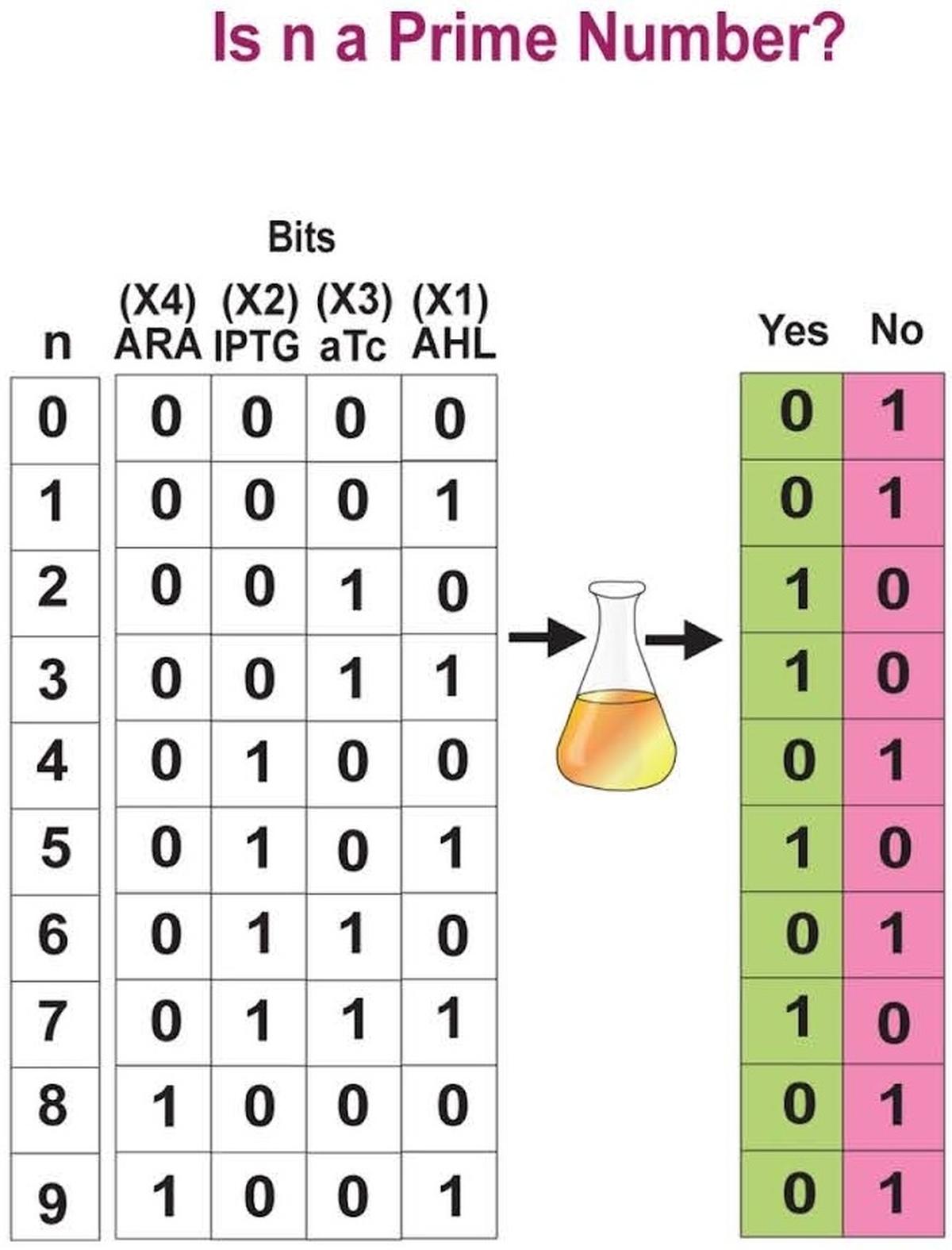
- 25 Nov 2024
In News:
Scientists at the Saha Institute of Nuclear Physics in Kolkatahave successfully engineered bacteria capable of solving mathematical problems, marking a major step forward in the field of synthetic biology and biocomputing. These engineered bacteria can function like artificial neural networks, performing tasks that were traditionally reserved for humans or conventional computers.
Key Highlights:
- Bacterial Computers:
- The research team introduced genetic circuits into bacteria, turning them into computational units capable of tasks like determining whether a number is prime or identifying vowels in an alphabet.
- These bacterial "computers" mimic artificial neural networks (ANNs), where each type of engineered bacterium (called a "bactoneuron") behaves like a node in a network, processing inputs to generate outputs.
- How it Works:
- The bacteria's genetic circuits are activated by chemical inducers, which represent binary 0s and 1s (the fundamental language of computing). The presence or absence of certain chemicals determines whether a bacterium expresses a specific fluorescent protein, representing the binary states.
- For example, when asked if a number between 0-9 is prime, the bacteria can express green fluorescent proteins (1) for "yes" or red fluorescent proteins (0) for "no", providing binary outputs that solve the problem.
- Complex Tasks:
- The team advanced to more complex tasks, such as asking the bacterial computers whether adding a number (like 2 + 3) results in a prime number or if a number's square can be expressed as the sum of factorials.
- In an even more complex test, the bacteria solved an optimization problem—calculating the maximum number of pieces a pie could be cut into with a given number of straight cuts. The bacteria’s fluorescent output represented binary numbers that were converted to decimal for the correct solution.
- Technical Details:
- The researchers used Escherichia coli (E. coli) bacteria, engineered with transcriptional genetic circuits, which recognize specific DNA sequences and trigger the expression of proteins based on the presence of chemical inducers.
- The system is similar to how ANNs work in traditional computing, where nodes (bactoneurons) take inputs, apply weights, and produce outputs based on activation functions.
- Implications and Future Prospects:
- Synthetic Biology & Biomanufacturing: This breakthrough could revolutionize industries such as pharmaceuticals and biomanufacturing by enabling biocomputers that perform specific tasks in a biological environment, potentially reducing reliance on silicon-based computers.
- Medical Applications: The ability of engineered bacteria to process data could lead to biocomputers capable of diagnosing diseases (such as cancer) at an early stage and even administering localized treatments.
- Understanding Intelligence: Bagh and his team hope to explore the biochemical nature of intelligence, pondering how intelligence could emerge from simple, single-celled organisms.
- Groundbreaking Research:
- The research, published in Nature Chemical Biology, has drawn significant attention in the synthetic biology community. Centre for Synthetic Biology highlighting the potential of bacteria programmed to solve complex problems.
This innovative work paves the way for future developments in biocomputing, where living organisms, instead of silicon chips, could be used to perform sophisticated calculations, offering new ways to think about computing, intelligence, and even the future of technology in medicine.
Access to Medicine Index Report 2024
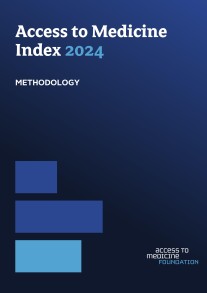
- 25 Nov 2024
In News:
- Recently, Access to Medicine Index Report 2024 was released by the Access to Medicine Foundation. The report evaluates 20 leading pharmaceutical companies on their efforts to expand access to medicines in low- and middle-income countries (LMICs).The biennial report has been published since 2008.
- Key Highlights:
- Key Areas of Evaluation
- Governance of Access: Companies’ leadership in addressing access issues.
- Research & Development (R&D): Focus on innovations for diseases prevalent in LMICs.
- Product Delivery: Efforts to ensure medicines and vaccines are accessible.
- Findings from the 2024 Report
- Gaps in Access for Low-Income Countries:
- Many pharmaceutical companies are adopting ‘inclusive business models,’ but outcomes are mixed, with transparent reporting still lacking.
- 61% of products lack specific access strategies for low-income countries.
- Exclusion from Clinical Trials:Only 43% of clinical trials take place in LMICs, despite these countries representing 80% of the global population.
- Limited Technology Transfers & Local Availability:
- Technology transfers and voluntary licensing are concentrated in countries like Brazil, China, and India.
- Sub-Saharan Africa (excluding South Africa) remains largely overlooked.
- Decline in R&D for Priority Diseases:
- Pharmaceutical companies are moving away from diseases like malaria, tuberculosis, and neglected tropical diseases, which disproportionately affect LMICs.
- Gaps in Access for Low-Income Countries:
- Key Issues in Accessing Medicines in LMICs
- Economic Barriers:
- High costs of essential medicines, including patented drugs, limit access for patients in LMICs with low purchasing power.
- Out-of-pocket expenditures lead to catastrophic financial consequences for families.
- Infrastructure Challenges:
- Poor transportation and cold chain infrastructure hamper the efficient distribution of medicines, especially in rural areas.
- Disruptions in supply chains (e.g., during pandemics) exacerbate medicine shortages.
- Regulatory Issues:Weak enforcement of regulatory frameworks results in the proliferation of substandard and counterfeit medicines, compromising treatment efficacy.
- Workforce Limitations:
- A shortage of trained healthcare professionals restricts appropriate prescription and management of medicines.
- Cultural beliefs and low health literacy further complicate adherence to treatments.
- Economic Barriers:
- Challenges Specific to LMICs
- Dual Burden of Diseases:
- LMICs face both infectious diseases and non-communicable diseases (NCDs), putting strain on fragile healthcare systems.
- 17 million people die from NCDs before age 70 annually, with 86% of these deaths occurring in LMICs.
- Need for Local Manufacturing:
- Strengthening local pharmaceutical manufacturing and distribution networks is crucial to ensure a reliable supply of essential medicines and reduce dependence on imports.
- Dual Burden of Diseases:
- Recommendations for Improving Access
- Companies should scale up efforts to bridge the health equity gap and use innovative approaches and local partnerships to improve access.
- Focus on increasing transparency in access reporting and addressing the lack of strategies for low-income countries.
- Pharmaceutical companies should refocus on diseases prevalent in LMICs, such as malaria and tuberculosis, and ensure that their R&D addresses the needs of these regions.
- Key Areas of Evaluation
Chagas Disease
- 24 Nov 2024
In News:
A recent study by Texas A&M University has uncovered a concerning new risk for dogs in Texas related to Chagas disease—the parasite Trypanosoma cruzi (T. cruzi), which causes the disease, can survive in dead kissing bugs (Triatominae). This discovery was published in the Journal of Medical Entomology in October 2024 and has raised alarms about how dead insects, which might be found in insecticide-treated dog kennels, could still pose a transmission risk for dogs.
Key Findings:
- Chagas Disease is primarily spread by kissing bugs, which carry T. cruzi in their gut. Dogs can contract the parasite by ingesting the bug's feces, especially when they lick their bite wounds.
- The study shows that even dead kissing bugs, which are often discarded in kennels, can still carry viable T. cruzi. This is particularly worrying in areas where insecticides are used to control the insects but dead bugs remain accessible to dogs.
- Researchers collected live and dead triatomines from six Texas kennels between June and October 2022, using both genetic testing and culture methods to assess whether the bugs were carrying live T. cruzi.
- 28% of the collected bugs tested positive for T. cruzi.
- A dead kissing bug (Paratriatomalecticularia) was found to still harbor live T. cruzi cultures, demonstrating that the parasite can survive even after the insect has died.
Transmission and Risks:
- Kissing bugs typically feed on the blood of animals like dogs, rodents, and raccoons, defecating near the bite site. If the dog licks the contaminated area, they can ingest the parasite-laden feces and become infected.
- The new discovery suggests that dead kissing bugs may pose a secondary transmission route for T. cruzi. Dogs that ingest these dead bugs, either in insecticide-treated areas or natural environments, could still contract the parasite.
- Researchers noted that dead bugs with intact gut contents showed a higher rate of infection than desiccated ones, which suggests that the condition of the bug after death impacts how long the parasite survives.
Implications for Management:
- The findings challenge current insecticide-based control methods. While insecticides kill the bugs, dead insects could still serve as a source of infection, necessitating new approaches for managing Chagas disease transmission in dog kennels.
- The study underscores the importance of regularly removing dead insects in kennels and reconsidering control strategies beyond just using insecticides.
About Chagas Disease:
- Chagas disease is caused by the Trypanosoma cruzi parasite, commonly found in the feces of kissing bugs. It can cause long-term heart and digestive issues if left untreated.
- The disease is common in parts of South America, Central America, and Mexico, but it has been increasingly reported in the southern United States.
- Treatment focuses on killing the parasite in the acute phase, but once it progresses to the chronic phase, treatment is aimed at managing symptoms.
Next Steps and Ongoing Research:
- The Texas A&M team plans to explore how long T. cruzi survives in dead triatomines and whether insecticides affect the parasite’s ability to persist. They are also looking into developing integrated pest management strategies for environments with high kissing bug activity.
- The study also forms part of a broader "One Health" approach, recognizing that both human and animal health are interconnected, and research on Chagas disease in animals can help inform public health strategies.
Imperial Eagle(Aquila heliaca)
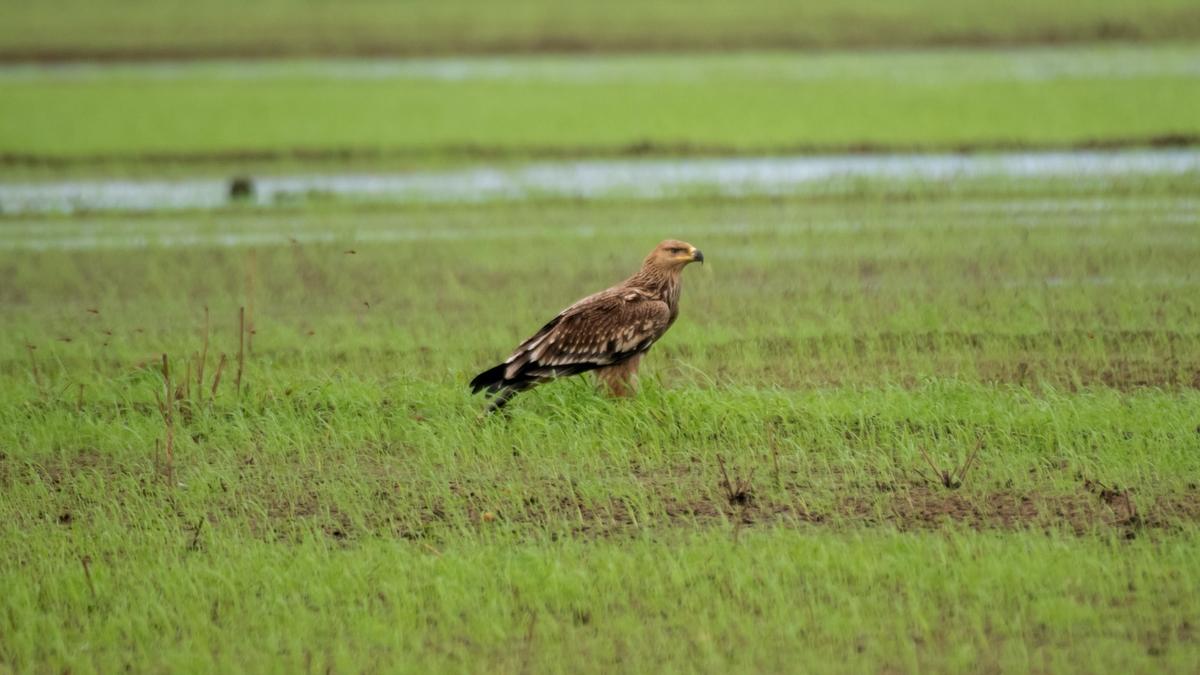
- 24 Nov 2024
In News:
- A rare Imperial Eagle (Aquila heliaca) was spotted in the PulluzhiKole wetlands. This marks a significant event as the species was last reported in Kannur in 2003.
Key Highlights:
- Habitat and Migration:
- The Imperial Eagle primarily breeds in southeastern Europe, west, and central Asia.
- During the winter months, it migrates to regions including northeastern Africa, West Asia, and parts of Southeast Asia.
- Conservation Status:The IUCN Red List lists the Imperial Eagle as a vulnerable species, indicating its potential risk of extinction, underscoring the need for its conservation efforts.
- Importance of Conservation:
- The Kole fields are a Ramsar-protected area, emphasizing their critical role in preserving migratory bird habitats.
- Ongoing conservation and observation efforts in these wetlands are essential for protecting the diverse bird species that use the area.
Features of the Imperial Eagle:
- Scientific Name: Aquila heliaca
- Physical Characteristics:
- Size: Length ranges from 68 to 90 cm, with a wingspan between 1.76 to 2.2 meters.
- Color: It has a pale golden crown and nape, with a grey base extending to the tail. Its wings feature prominent white "braces" on the scapulars.
- Sexual Dimorphism: Males are typically smaller than females.
- Habitat: Prefers old forests, mountainous regions, and riverside forests.
- Feeding: It has strong legs and curved talons for capturing and killing prey, and exceptional eyesight to spot prey from high altitudes.
- Conservation Efforts: Continued monitoring and protection of the Kole wetlands and other vital habitats are crucial for the survival of this vulnerable species and other at-risk birds.
Minke Whale
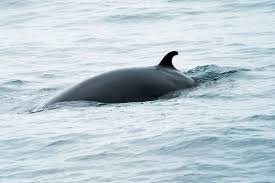
- 24 Nov 2024
In News:
Scientists have directly measured the hearing range of minke whales for the first time, finding that they can detect high-frequency sounds up to 90 kHz.
Key Highlights:
- Implication for Ocean Noise: The study suggests that baleen whales, including minke whales, may be more affected by anthropogenic ocean noise (e.g., naval sonar) than previously recognized, as their hearing range had been underestimated.
- Research Method: A novel catch-and-release technique was used to temporarily hold adolescent minke whales in Norway for auditory evoked potential (AEP) tests to measure their hearing sensitivity.
- Findings: Contrary to the belief that baleen whales are low-frequency specialists, minke whales can detect frequencies between 45 kHz to 90 kHz.
- Impact of Findings: The results could affect future regulations on ocean noise and its impact on marine mammals, as better hearing data is now available for baleen whales.
Minke Whale Overview:
- Family: Minke whales are members of the baleen or "great" whale family and are the smallest of the rorquals.
- Species: There are two recognized species:
- Common minke whale (Balaenoptera acutorostrata), found in various ocean basins.
- Antarctic minke whale (B. bonaerensis), found in the Southern Hemisphere.
- Subspecies:
- Dwarf minke whale: An unnamed subspecies of the common minke whale, mostly in the Southern Hemisphere.
- North Atlantic (B. a. acutorostrata) and North Pacific (B. a. scammoni) subspecies of common minke whales.
- Distribution: Minke whales are widely spread across tropical, temperate, and polar regions (65°S to 80°N), with common minke whales in all ocean basins and dwarf minke whales mostly in the Southern Hemisphere.
- Feeding Areas: They feed in cooler waters at higher latitudes and can be found both inshore and offshore.
- Conservation Status (IUCN):
- Common minke whale: Least Concern.
- Antarctic minke whale: Data Deficient.
Cicada
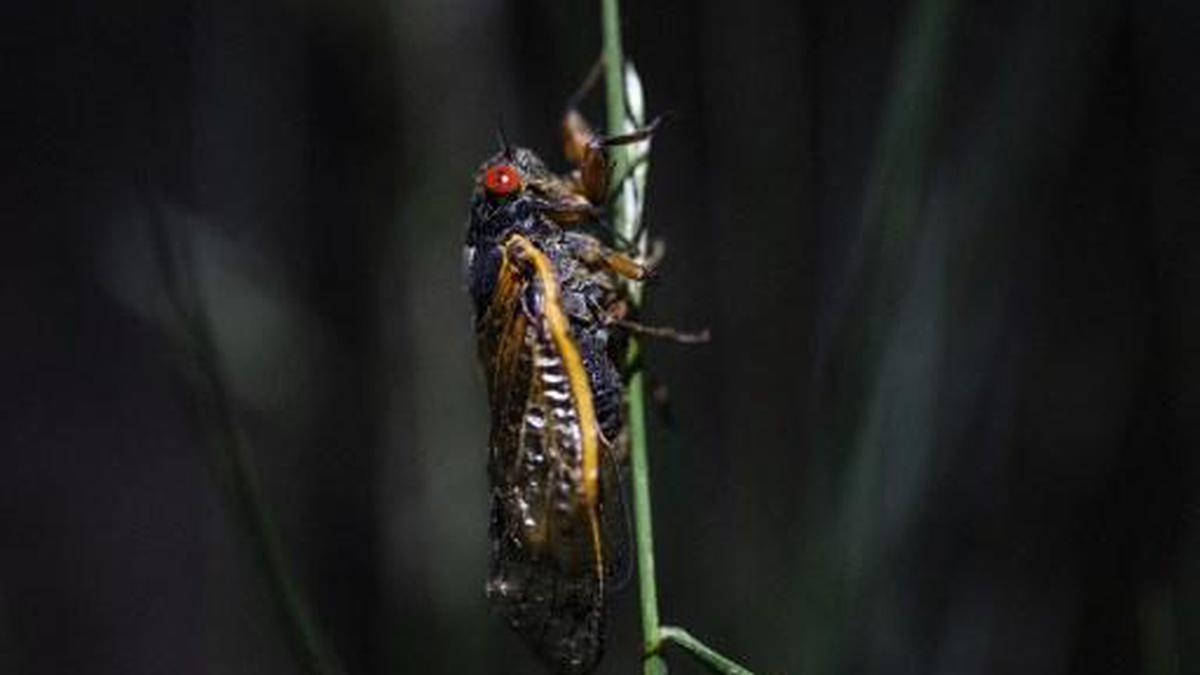
- 23 Nov 2024
In News:
North American cicadas have life cycles that last for prime numbers of years, putting pressure on the idea that humans created mathematics.
What are Cicadas?
- Classification: Cicadas are insects that belong to the order Hemiptera and the superfamily Cicadoidea.
- Physical Features: Hemipteran insects (also known as true bugs) have piercing-sucking mouthparts and two pairs of wings.
- Life Span: Cicadas spend the majority of their life underground, feeding on plant sap. Once they emerge from the soil, they have a short adult life span of about 2 to 4 weeks.
Habitat:
- Preferred Environment: Cicadas are typically found in natural forests with large trees and are considered canopy dwellers.
- Global Distribution: Cicadas are found on every continent except Antarctica. The highest genetic diversity of cicadas is found in India and Bangladesh, followed by China.
Cicada Emergence and Life Cycle:
- Life Cycle: Cicadas have a complex life cycle, involving long periods of underground development followed by brief adult emergence.
- Periodical Cicadas: There are species of cicadas that emerge in 13-year and 17-year cycles.
- Broods: Initially, 30 broods were categorized based on geography and emergence times, but currently, only about 15 broods remain active due to some broods becoming extinct.
- Unique Phenomenon: In April 2024, a rare event is expected where a trillion cicadas from two different broods will emerge simultaneously in the Midwest and Southeast regions of the United States.
Cicada's underground Development:
- Feeding on Sap: During their underground phase, cicadas feed on the sap of plants.
- Purpose of Long Development: Researchers believe the long development period helps cicadas evade above-ground predators by keeping them hidden in the soil.
Vulnerability after Emergence:
- Emergence Behavior: Once cicadas emerge, they construct a "cicada hut" to shed their nymphal skins, then climb onto nearby trees or vegetation.
- Predator Vulnerability: Adult cicadas are vulnerable to predators such as turtles and other forest creatures because they are clumsy and defenseless, making them easy prey for predators.
Significance of the 2024 Emergence:
- The coinciding emergence of cicadas from different broods (13-year and 17-year cycles) is a rare event that highlights the complexity and mathematical precision behind the cicada life cycle.
The science of plant communication

- 23 Nov 2024
In News:
More than any organism, plants understand the significance of communication the best.
Communication Through Chemical Warning (Volatile Organic Compounds - VOCs):
- Plants release volatile organic compounds (VOCs) when threatened, such as during herbivore grazing.
- VOCs act as distress signals, alerting neighboring plants to potential dangers.
- Neighboring plants respond by producing defensive compounds or toxins to deter herbivores.
- VOCs can travel through air and soil, enabling distant plants to prepare for threats, thereby enhancing survival across larger areas.
Wood Wide Web (Symbiotic Relationship with Mycorrhizal Fungi):
- Plants form a network with mycorrhizal fungi, connecting their roots in a symbiotic bond.
- This "Wood Wide Web" allows plants to communicate by sending chemical signals through their roots when under stress (e.g., pest attacks or drought).
- Fungi extend the root system and help share nutrients between plants, especially in times of distress.
- The network facilitates collective resilience and survival by ensuring nutrient sharing among plants.
Cooperative Behavior: Sharing Resources for Survival:
- Plants in close proximity, especially in dense forests, often share resources like water, nutrients, and light.
- When a plant detects a neighboring plant in distress, it prioritizes resource allocation to support its growth.
- This cooperative behavior promotes ecosystem stability and the overall health of forests.
- The mutual support system shows how cooperation enhances the survival of individual plants and the broader ecosystem.
Significance of Plant Communication in Ecosystem Health:
- Plants communicate through chemical signals, underground fungal networks, and cooperative behaviors.
- These interactions foster resilience, ensuring the survival of both individual plants and entire ecosystems.
- The silent communication among plants contributes to a dynamic, cooperative environment that thrives on mutual support.
Rare Leucistic Peacock
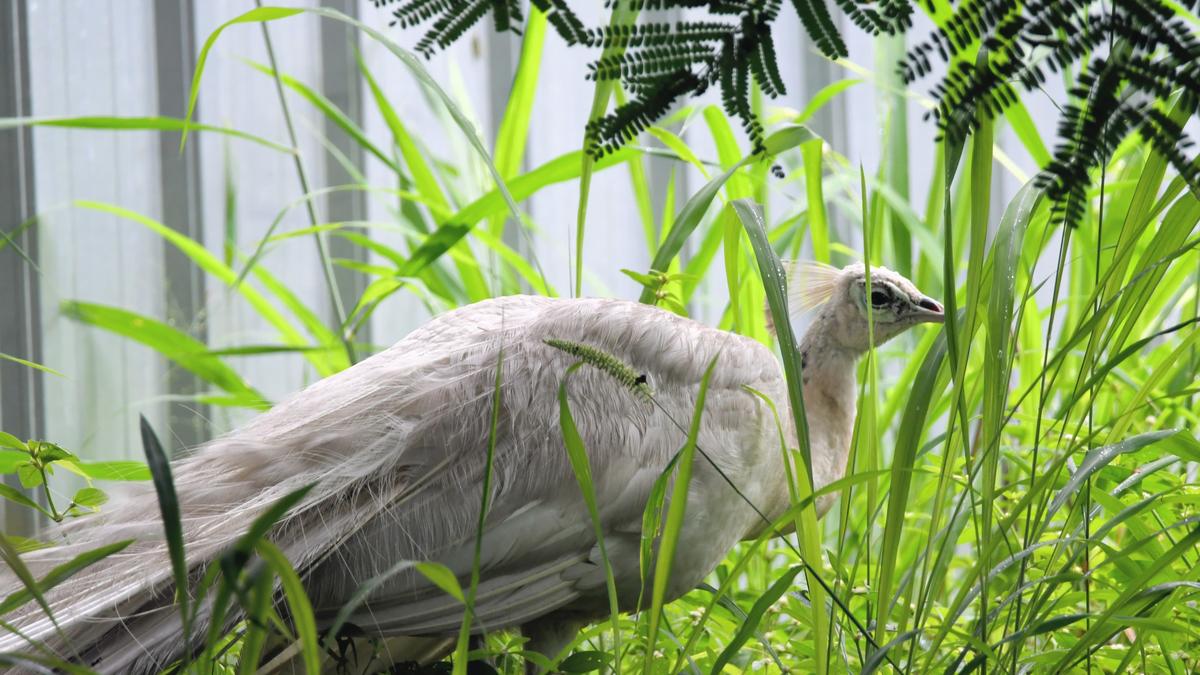
- 22 Nov 2024
In News:
Tamil Nadu Forest Department staff and members of a non-governmental organisation rescued a rare peacock with white feathers, caused by a genetic condition called leucism, in Coimbatore.
Key Highlights:
Incident Details:
- Species: Indian peacock (Pavocristatus), known for its beautiful plumage.
- Condition: The peacock was rescued due to a leg injury and its rare white plumage.
- Cause of White Plumage: The bird's white feathers are caused by leucism, a genetic condition that reduces pigmentation in feathers while leaving eye color unaffected.
Expert Insights:
- Leucism: It causes partial loss of pigmentation in animals. A leucistic animal retains normal eye color but has pale or white coloration.
- Distinction from Albinism: Unlike albinism, which results in a complete lack of melanin and often causes red or pink eyes, leucistic animals retain normal eye pigmentation.
- Identification of Leucism in Peacock: The bird’s dark eyes and pink bill and feet confirmed it as fully leucistic.
Peacock Species:
- Indian Peacock (Pavocristatus): The National Bird of India, native to India and Sri Lanka. It belongs to the Phasianidae family, which also includes pheasants, quails, and jungle fowl.
- Green Peacock (Pavomuticus): Found from Myanmar to Java.
Conservation Status:
- IUCN Status: Listed as Least Concern.
- Wildlife Protection Act, 1972: The Indian peacock is listed under Schedule I, offering it the highest level of legal protection in India.
Climate Change Performance (CCPI 2025)
- 22 Nov 2024
In News:
Recently, the Climate Change Performance Index (CCPI 2025) report was released at the annual UN climate conference in Baku.
Key Highlights:
- It is published by think tanks German watch, New Climate Institute, and Climate Action Network International.It was first published in 2005.
- It tracks the progress of the world’s largest emitters in terms of emissions, renewables, and climate policy.
India's Ranking in Climate Change Performance (CCPI 2025)
- India's Rank: 10th (Dropped two places from the previous year).
- Key Factors for India's High Rank:
- Low per capita emissions: 2.9 tons of CO2 equivalent (global average: 6.6 tons).
- Rapid deployment of renewables: India is a leader in solar energy projects, including large-scale solar and rooftop solar schemes.
- Renewable energy targets: Aims for 500 GW of renewable energy capacity by 2030.
- Energy efficiency standards: Introduced, but coverage remains inadequate.
- Electric vehicle (EV) deployment: Significant progress, especially in two-wheelers.
- Challenges for India:
- Heavy reliance on coal: India remains one of the top 10 countries with the largest developed coal reserves.
- Growth-oriented approach: Economic growth and energy demand continue to drive climate action, with limited change in climate policy expected.
- Future Pledges:
- Net-zero emissions by 2070.
- Global leadership in green energy.
CCPI 2025 Rankings Overview
Rank
Country
Key Points
1-3
Empty
No country performed well enough to achieve a "very high" rating.
4
Denmark
Leading climate actions but ranks 4th technically.
5
Netherlands
Strong climate performance, follows Denmark.
6
U.K.
Notable improvement due to coal phase-out and halting new fossil fuel licenses.
10
India
High performer, despite challenges like reliance on coal.
55
China
Largest emitter, heavily reliant on coal, ranks 55th despite promising plans.
57
U.S.
Second-largest emitter, ranks 57th with insufficient climate targets.
59
Argentina
Major climate policy setbacks, including potential exit from Paris Agreement.
64-67
Iran, Saudi Arabia, UAE, Russia
Lowest-ranked, major oil and gas producers with weak climate policies.
General Findings of the Report
- CCPI Methodology: Assesses 63 countries (plus the EU) responsible for 90% of global emissions based on their emissions, renewable energy efforts, and climate policies.
- Global Trends:
- No country has been able to secure a "very high" rating across all categories.
- Denmark and Netherlands are among the top performers.
- The U.K. shows significant progress with its coal phase-out and fossil fuel policies.
UNICEF’s State of the World’s Children 2024 (SOWC-2024) Report
- 21 Nov 2024
In News:
The world is facing an unprecedented crisis with nearly half of all children – about 1 billion – living in countries that face a high risk of climate and environmental hazards, the UNICEF’s State of the World’s Children 2024 (SOWC-2024) report, said.
Key Highlights:
Environmental Hazards and Children’s Health:
- Children face an increasingly unpredictable and hazardous environment due to climate change, environmental crises, and frontier technologies.
- Nearly 1 billion children live in countries facing high risks from climate and environmental hazards.
- Children’s developing bodies are especially vulnerable to pollution, extreme weather, and environmental hazards.
- Air pollution, rising temperatures, and extreme weather events harm children's respiratory health, increase the spread of diseases like malaria and dengue, and impact food security and access.
Impact of Climate Change:
- Climate destabilization, biodiversity loss, and pollution are intensifying globally.
- Climate-related disasters (e.g., floods) affect water supplies, causing waterborne diseases, a leading cause of death in children under five.
- Extreme weather events, such as floods, can cause trauma, anxiety, and displacement for children.
- By the 2050s, more children will be exposed to extreme climate hazards compared to the 2000s.
- School closures, affecting 400 million children since 2022 due to extreme weather, disrupt education and hinder economic growth.
Projections for Child Survival and Life Expectancy:
- Newborn survival rates: Projected to rise by nearly 4 percentage points to over 98% globally by the 2050s.
- Probability of surviving to age 5: Expected to increase to 99.5%.
- Life expectancy: Expected to rise to 81 years for girls and 76 years for boys by the 2050s.
Child Population Trends by 2050:
- Global child population expected to stabilize at 2.3 billion by the 2050s.
- South Asia, Eastern/Southern Africa, and West/Central Africa will have the largest child populations, facing significant challenges in meeting children’s basic needs.
- These regions also face climate risks, inadequate digital infrastructure, and socio-economic challenges.
Technological Advancements:
- Artificial Intelligence (AI), neurotechnology, renewable energy, and vaccine breakthroughs could significantly improve childhood well-being.
- Digitalization: While it can empower children, it also exposes them to online risks, including sexual exploitation and abuse.
Socio-Economic Conditions and Inequality:
- 23% of children projected to live in low-income countries by 2050, a significant increase from 11% in the 2000s.
- GDP per capita in East Asia, Pacific, and South Asia expected to more than double from the 2020s to the 2050s.
- Growing inequalities between high- and low-income countries, particularly in terms of digital access and infrastructure.
Urbanization and Child Welfare:
- By the 2050s, nearly 60% of children globally will live in urban areas, up from 44% in the 2000s.
- Ensuring healthier and more secure urban environments is critical for improving future childhoods.
- Over 95% of people in high-income countries are connected to the internet, compared to just 26% in low-income countries, exacerbating inequalities.
Key Takeaways:
- Children are facing a more hazardous environment than ever before, influenced by climate change, technological developments, and demographic shifts.
- Proactive measures are needed to mitigate environmental risks, promote digital inclusion, and ensure equitable access to resources and opportunities for children globally.
High-Altitude Sickness
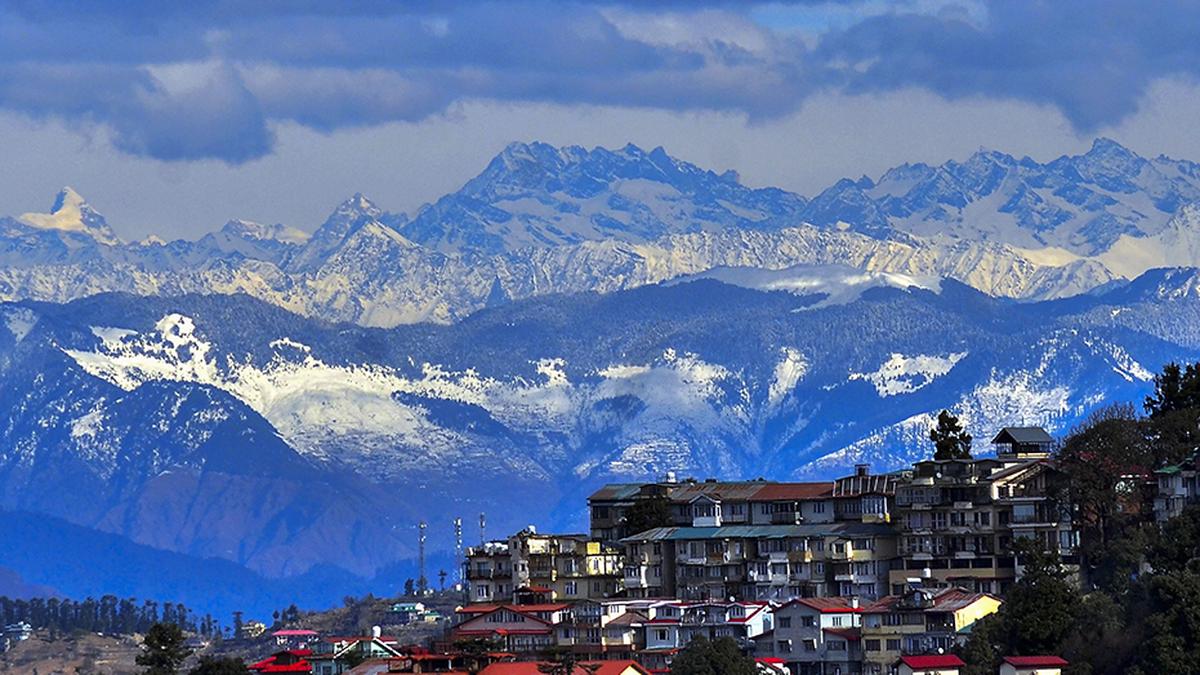
- 20 Nov 2024
In News:
In September, a trekker from Idukki, Kerala, died in Uttarakhand while attempting to scale Garur Peak due to respiratory failure. Every year, numerous tourists like this succumb to the effects of high-altitude sickness in the pristine but challenging inner Himalayas. These regions present hidden dangers due to their extreme altitudes, where thinner air and reduced oxygen can lead to potentially fatal conditions.
What is High-Altitude Sickness?
- Acute Mountain Sickness (AMS) occurs when the body struggles to acclimatize to high altitudes, typically above 8,000 feet (2,400 meters), where oxygen levels are lower.
- As altitude increases, oxygen levels decrease, leading to hypoxia (lack of oxygen). Early symptoms include:Headache, Nausea, Fatigue&Shortness of breath
- If untreated, AMS can develop into:
- High-altitude pulmonary edema (HAPE): Fluid accumulation in the lungs, leading to severe breathing problems.
- High-altitude cerebral edema (HACE): Fluid in the brain causing confusion, hallucinations, or coma.
- Both conditions are life-threatening and require immediate descent to lower altitudes.
Infrastructural Issues
- Many Himalayan regions lack adequate healthcare facilities beyond major towns like Shimla.
- Leh is an exception, with specialized facilities for high-altitude ailments, but most areas lack preventive health measures.
- Implementing health screenings at entry points to high-altitude zones (like Kinnaur or Lahaul-Spiti) could significantly improve prevention and response to AMS.
Mandatory Registration System for Tourists
- Tourist Registration: A system where tourists must register before entering remote mountain areas would allow authorities to monitor movements and provide timely medical assistance.
- Benefits:
- Quick emergency responses by having data on tourists' locations.
- Research support: Tracking demographic patterns and risk factors to better understand how altitude impacts different populations.
Early Intervention for High-Altitude Sickness
- Gradual Ascent: To allow the body to acclimatize, gradual ascent is crucial. Every 3-4 days, take a rest day and avoid increasing sleeping altitude by more than 500 meters/day.
- Medications: Doctors recommend:
- Acetazolamide to promote better oxygenation.
- Dexamethasone for reducing inflammation in severe cases.
- For those with a history of HAPE, Nifedipine may be used preventively.
- However, no medication guarantees immunity from AMS. Travelers with pre-existing conditions should consult a doctor before traveling.
Treatment Strategies
- Descent: The best treatment for AMS is to descend to lower altitudes (300-1,000 meters), where symptoms improve rapidly.
- Additional Measures: If available, supplemental oxygen or a portable hyperbaric chamber can help in emergencies.
- Medications like acetazolamide and dexamethasone can provide short-term relief but are not substitutes for descent.
Policy Recommendations
- Medical Infrastructure: Establish state-of-the-art medical facilities in high-altitude regions of the Himalayas.
- Research: Set up research centers to study high-altitude illnesses.
- Air-ambulance Services: Equip states with air-ambulance services for rapid medical evacuation in emergencies.
- Health and Safety Information: Provide accessible information on government websites and at check-in points to educate tourists on preventing and managing AMS.
Preventive Measures Before Scaling the Himalayas
- Acclimatization: Gradual ascent is essential for preventing AMS.
- Health Checks: Get a medical check-up to assess risk factors before travel.
- Medications: Consult a doctor for potential preventive medications.
- Hydration and Rest: Stay hydrated and take ample rest during the ascent.
- Monitor Symptoms: Be aware of early symptoms like headaches or nausea and stop ascending if they occur.
By addressing these measures, the risks associated with high-altitude sickness can be mitigated, improving safety for tourists and trekkers in the Himalayas.
Grand Commander of the Order of the Niger
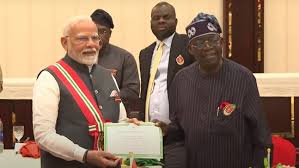
- 19 Nov 2024
In News:
PM Modi receives Nigeria’s second-highest national award.
Key Events and Achievements
- Award Conferred:
- Award Name: Grand Commander of the Order of the Niger (GCON).
- Significance: Nigeria’s second-highest national award, conferred on Prime Minister Narendra Modi.
- Historical Context: Modi becomes the second foreign dignitary to receive this award, after Queen Elizabeth in 1969.
Strategic and Developmental Ties Between India and Nigeria
- First Visit in 17 Years: Modi’s visit is the first by an Indian PM to Nigeria in 17 years, underscoring the significance of strengthening bilateral ties.
- Economic Cooperation:
- Over 200 Indian companies have invested around $27 billion in Nigeria across key sectors, making India a major economic partner.
- India has provided $100 million in development assistance through concessional loans and is actively involved in capacity-building training programs in Nigeria.
- MoUs Signed:
- Three Memoranda of Understanding (MoUs) were signed in the fields of:
- Cultural Exchange.
- Customs Cooperation.
- Survey Cooperation.
- Three Memoranda of Understanding (MoUs) were signed in the fields of:
- Relief Aid: Modi announced the dispatch of 20 tonnes of relief supplies to help Nigeria recover from the devastating floods that affected the country last month.
Diplomatic Discussions and Initiatives
- Strategic Partnership: Modi described the India-Nigeria partnership as one with immense potential in sectors like defence, energy, technology, trade, health, and education.
- Indian Expatriate Community: Modi acknowledged the 60,000-strong Indian diaspora in Nigeria, recognizing their role as a pillar of bilateral ties.
- Support for Africa:
- Modi highlighted India’s support for the African Union’s membership in the G20, an outcome of the India-hosted G20 summit in 2023.
- Nigeria’s Role: He noted Nigeria’s positive influence on Africa and its importance as a key partner in India’s Africa engagement.
Broader Implications for International Relations
- India-Nigeria Security Cooperation:
- The National Security Advisors (NSA) of India and Nigeria held in-depth discussions on counter-terrorism, extremism, and cybersecurity challenges.
- India and Nigeria are committed to jointly addressing global threats such as arms smuggling and international crime.
- India's Role as a Development Partner:
- India’s growing role as a development partner for African nations is becoming increasingly important, exemplified by Nigeria’s close ties with India.
- Global Diplomacy and Soft Power:
- Modi’s award and visit reflect India’s growing influence in Africa and its emphasis on fostering ties with resource-rich and strategically located nations like Nigeria.
- The Grand Commander of the Order of the Niger is also a reflection of the soft power India is wielding globally.
Key Facts about Nigeria:
- Location: Nigeria is located in West Africa, bordering Niger, Chad, Cameroon, and Benin, with access to the Atlantic Ocean.
- Significance:
- Known as the “Giant of Africa” due to its large population and economic power.
- It has the largest economy in Africa, largely driven by its oil reserves.
Graded Response Action Plan (GRAP-IV)
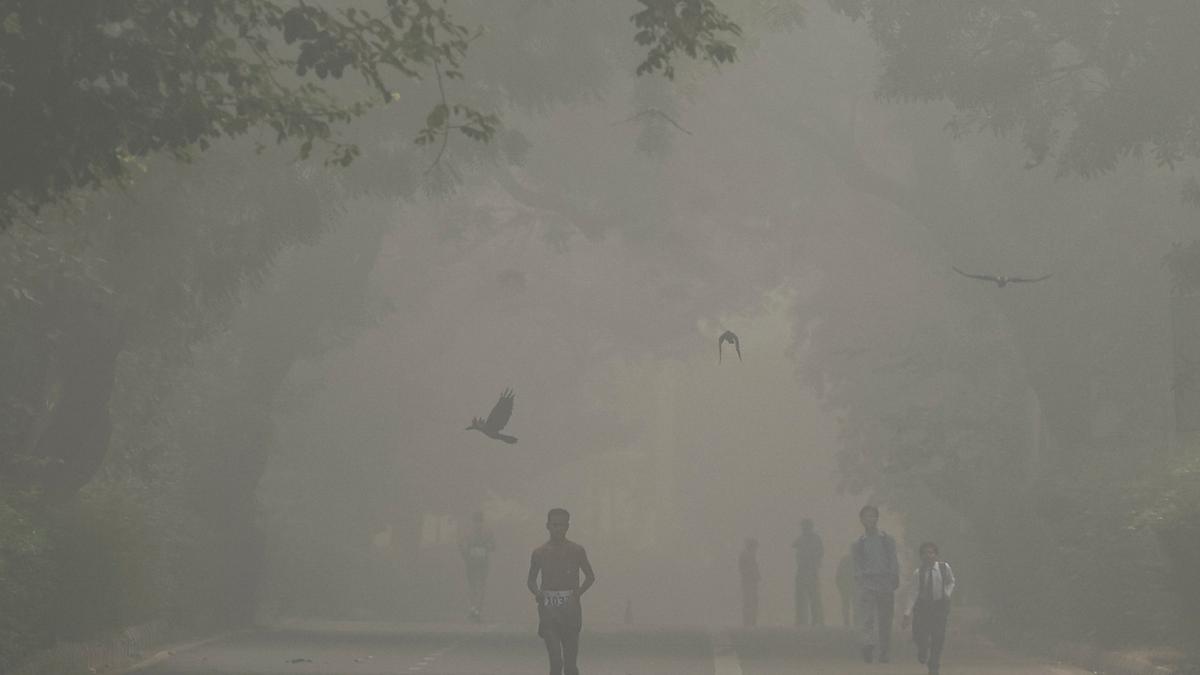
- 19 Nov 2024
In News:
As Delhi’s AQI worsened, the Commission for Air Quality Management issued the order to activate Stage-IV of the Graded Response Action Plan.
Restrictions Under GRAP-IV in Delhi-NCR
- Truck Movement:
- Banned except for essential goods and trucks using clean fuels (LNG, CNG, BS-VI diesel, or electric).
- Non-essential light commercial vehicles registered outside Delhi are also banned unless they are CNG or BS-VI diesel or electric vehicles (EVs).
- Delhi-registered BS-IV or older diesel vehicles (medium and heavy goods vehicles) are banned, except for those in essential services.
- Construction Activities:Suspension of all construction work, including public projects like highways, roads, flyovers, power lines, pipelines, etc.
- Schools and Work:
- Online classes for students of Classes 6 to 9 and Class 11.
- Work from home (WFH) recommendations for 50% office capacity in NCR.
- Central government employees may also be asked to work from home.
- Offline classes for Classes 10 and 12 continue, but schools for other classes must shift to online mode.
- Other Measures:
- State governments may impose additional measures such as:
- Closure of colleges.
- Odd-even vehicle scheme.
- Restrictions on non-essential commercial activities.
- State governments may impose additional measures such as:
About GRAP (Graded Response Action Plan)
- Purpose: A plan to reduce air pollution in the Delhi-NCR region based on AQI levels.
- Approved By: Supreme Court in 2016 (M.C. Mehta v. Union of India).
- Notified by MoEFCC: 2017.
- Implementation Authority: CAQM (Commission for Air Quality Management).
Stages of GRAP
GRAP is an incremental system, with measures activated as air quality deteriorates:
- Stage 1: Poor AQI (201-300) – Basic pollution control measures.
- Stage 2: Very Poor AQI (301-400) – Enhanced measures.
- Stage 3: Severe AQI (401-450) – Stricter actions like shutting down industries.
- Stage 4: Severe Plus AQI (Above 450) – Most stringent restrictions, as activated on November 18, 2024.
Air Quality Index (AQI)
- Introduced: 2014, by Central Pollution Control Board (CPCB).
- Categories:
- Good: 0-50
- Satisfactory: 51-100
- Moderately Polluted: 101-200
- Poor: 201-300
- Very Poor: 301-400
- Severe: 401-450
- Severe Plus: 451 and above (current status in Delhi).
- Pollutants Considered: PM10, PM2.5, NO?, SO?, CO, O?, NH?, and Pb.
- Measurement: 24-hour average values for PMs, and 8-hour averages for CO and O?.
Commission for Air Quality Management (CAQM)
- Established: Under the Commission for Air Quality Management in National Capital Region (NCR) Act, 2021.
- Mandate: To coordinate, research, and manage air quality issues in the NCR and adjoining areas.
- Composition: Includes government officials, technical experts, and NGO representatives.
- Jurisdiction: Covers Delhi and parts of Haryana, Uttar Pradesh, and Rajasthan.
Nepal-Bangladesh Power Transfer via India
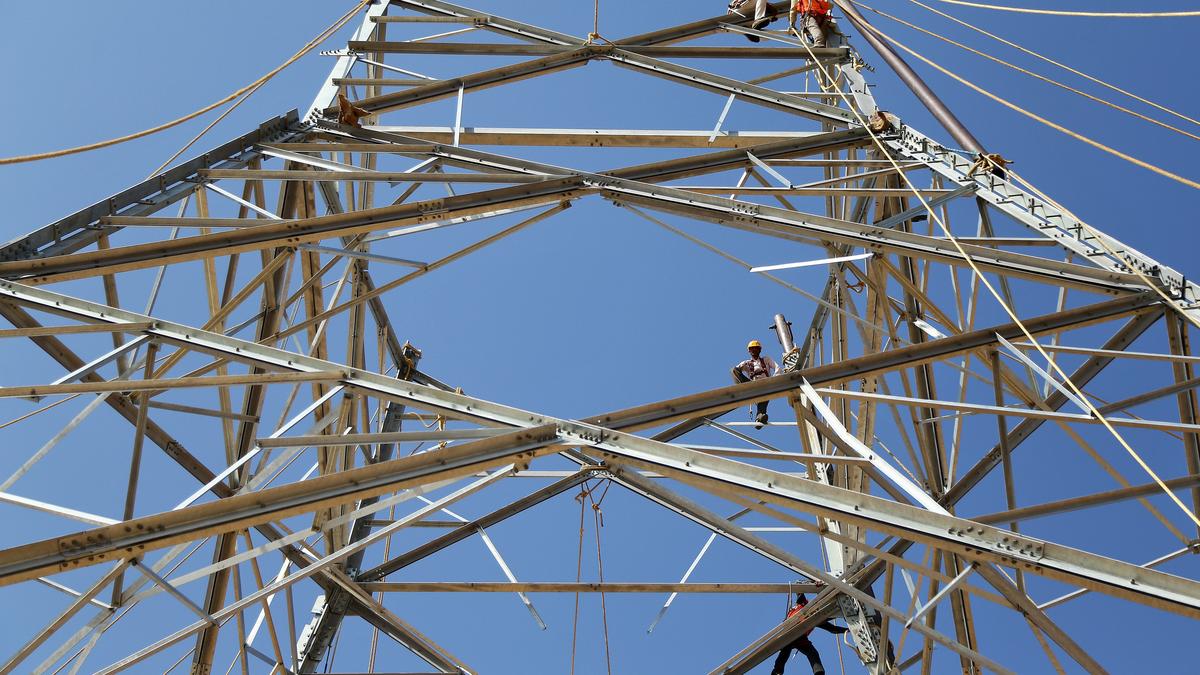
- 19 Nov 2024
In News:
Nepal starts exporting energy to Bangladesh with Indian grid support.
Significance of the Power Transfer:
- Energy Cooperation:
- A major step in regional energy cooperation among Nepal, India, and Bangladesh.
- Strengthens sub-regional connectivity in the power sector.
- Nepal’s Hydropower Potential:
- Nepal, a Himalayan nation, possesses untapped hydropower resources, and this agreement opens the door for future cross-border electricity cooperation.
- Nepal’s energy exports are a green energy initiative, supporting sustainable industrial growth in Bangladesh and regional prosperity.
- Electricity Crisis in Bangladesh:
- Bangladesh is facing an ongoing electricity shortage, worsened by the suspension of power supply from Adani’s Godda plant and the maintenance of the Payra thermal unit.
- The addition of 40 MW of Nepalese hydroelectric power aims to alleviate the energy shortfall in Bangladesh.
Tripartite Power Sales Agreement:
- Agreement Details:
- The agreement for power transfer was signed in October 2023 between:
- NTPC Vidyut Vyapar Nigam (NVVN) (India)
- Nepal Electricity Authority (NEA) (Nepal)
- Bangladesh Power Development Board (BPDB) (Bangladesh).
- Power Export: Nepal has started exporting 40 MW of electricity, which marks a significant milestone in trilateral power cooperation.
- The agreement for power transfer was signed in October 2023 between:
Key Entities Involved:
- NTPC Vidyut Vyapar Nigam (NVVN):
- A wholly owned subsidiary of NTPC Ltd. (National Thermal Power Corporation), created to facilitate power trading.
- NVVN is diversifying into renewables, e-mobility, and green fuel solutions.
- NTPC Ltd.:
- A Maharatna PSU under India’s Ministry of Power, established to develop power resources in India.
- Involved in large-scale power generation and clean energy initiatives
Guru Ghasidas-TamorPingla Tiger Reserve
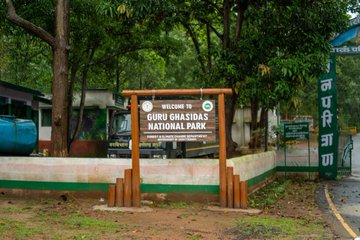
- 19 Nov 2024
In News:
The Guru Ghasidas-TamorPingla Tiger Reserve in Chhattisgarh has been officially notified as India's 56th tiger reserve, marking a significant milestone in the country's conservation efforts. Here's an overview of this new reserve:
Key Details:
- Location: The tiger reserve is located across the Manendragarh-Chirmiri-Bharatpur, Korea, Surajpur, and Balrampur districts of Chhattisgarh.
- Area: The reserve spans 2,829.38 square kilometers and includes both core and buffer zones.
- Core/critical habitat: 2,049.2 sq. km (includes the Guru Ghasidas National Park and TamorPingla Wildlife Sanctuary).
- Buffer zone: 780.15 sq. km.
- Rank: It is the third largest tiger reserve in India, after the Nagarjunasagar-Srisailam Tiger Reserve (Andhra Pradesh) and Manas Tiger Reserve (Assam).
Connectivity:
The reserve forms part of a landscape complex that extends over nearly 4,500 sq. km and is interconnected with other major tiger reserves:
- Sanjay Dubri Tiger Reserve (Madhya Pradesh) to the north.
- Bandhavgarh Tiger Reserve (Madhya Pradesh) to the west.
- Palamau Tiger Reserve (Jharkhand) to the east.
This connectivity supports greater wildlife movement, reducing the risk of inbreeding and strengthening the overall conservation efforts for the tiger population.
Biodiversity:
The Guru Ghasidas-TamorPingla Tiger Reserve is ecologically rich, harboring a wide array of species:
- 753 species have been documented, including:
- 230 bird species.
- 55 mammal species, including several threatened species such as tigers, leopards, sloth bears, and wolves.
- A variety of invertebrates, especially insects.
- The reserve's terrain includes dense forests, streams, rivers, and varied elevations, making it an ideal habitat for tigers and other wildlife.
Ecological Importance:
- Situated in the Chota Nagpur and Baghelkhand plateaus, the reserve has varied landscapes that contribute to its ecological diversity. The region's tropical climate and dense forests make it a critical habitat for tigers and other wildlife.
- The reserve's core area forms an important critical tiger habitat, providing a sanctuary for tigers to thrive with minimal human disturbance.
Conservation Impact:
With the addition of this tiger reserve, Chhattisgarh now boasts four tiger reserves, complementing the existing Udanti-Sitanadi, Achanakmar, and Indravati reserves. This bolsters the state's and the country's ongoing efforts to protect and conserve tigers, which are a keystone species in maintaining ecological balance.
Procedural Steps for Notification:
- Identification: The state government identifies a significant ecological area with potential for tiger conservation.
- NTCA Approval: After a thorough assessment, the National Tiger Conservation Authority (NTCA) evaluates and approves the proposal.
- State Notification: The state government officially notifies the area as a tiger reserve under the Wildlife Protection Act of 1972.
- Implementation: The state, with NTCA support, begins implementing conservation and management strategies.
Unified Complex Radio Antenna
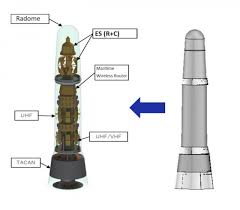
- 17 Nov 2024
In News:
- India and Japan recently signed a Memorandum of Implementation (MoI) to co-develop the UNICORN (Unified Complex Radio Antenna) mast for deployment on Indian Navy ships. This pact marks a significant milestone as it is India's first military technology transfer agreement with Japan.
- The deal follows a 2015 agreement on the transfer of defense equipment and technology, further strengthening defense ties between the two countries.
- The UNICORN mast is a cutting-edge communication and radar system designed to enhance the stealth characteristics of naval vessels. This agreement is seen as an important step towards deepening India-Japan defense cooperation.
What is UNICORN?
The UNICORN mast is an advanced, integrated antenna system that combines several communication and radar components into a single conical structure or radome (a radar-absorbing dome). It is designed to reduce the radar cross-section (RCS) of ships, improving their stealth capabilities.
Key features of the UNICORN mast include:
- Integration of multiple antennas: It consolidates various antennas used for tactical data links, communications, and navigation systems (e.g., TACAN - Tactical Air Navigation System).
- Stealth enhancement: By reducing the number of exposed components and consolidating them into a single radome, the mast significantly lowers the ship’s radar signature, making it harder to detect.
- Improved performance: The mast design minimizes mutual interference between antennas, enhances maintainability, and increases lightning resistance.
- Space efficiency: It saves valuable below-deck space and reduces ship-building time by integrating multiple systems into one mast.
The UNICORN system is currently deployed on Mogami-class frigates of the Japan Maritime Self-Defence Force.
India-Japan Defense Cooperation
- 2015 Defense Technology Transfer Agreement: This pact established a framework for defense cooperation between India and Japan, paving the way for joint projects like the UNICORN mast.
- Bilateral Military Exercises:
- Veer Guardian 2023: A bilateral exercise conducted between the Japan Air Self Defence Force (JASDF) and the Indian Air Force (IAF), which deepened defense interoperability between the two nations.
- Tarang Shakti 2024: The first multilateral air exercise hosted by the Indian Air Force, with Japanese fighter aircraft participating.
- Andaman and Nicobar Islands Development: Japan has also provided financial aid for infrastructure development in India’s strategically located Andaman and Nicobar Islands, contributing to enhancing India’s maritime security in the region.
Red-Headed Vulture
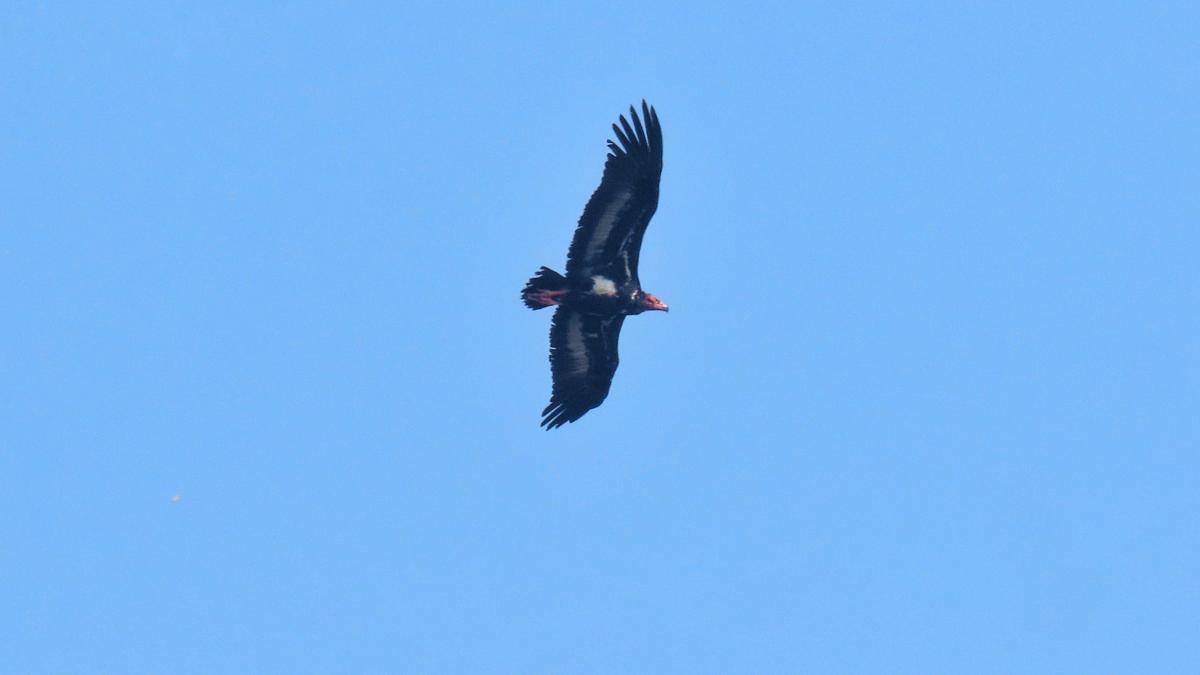
- 17 Nov 2024
In News:
- The Red-Headed Vulture, a critically endangered species, has been sighted for the first time in Kasaragod, Kerala, marking an important addition to the region’s avian biodiversity. This rare sighting occurred at Manhampothikunnu near Mavungal. Prior to this, the species was predominantly seen in the Wayanad region of Kerala.
- This discovery brings the total number of bird species recorded in Kasaragod to 407, showcasing the district's growing avian diversity.
About the Red-Headed Vulture:
- The Red-Headed Vulture (also known as the Asian King Vulture or Pondicherry Vulture) is one of the rarest and most critically endangered species of vultures in India. It is known for its distinctive scarlet red head and black body with a white patch on the abdomen.
- Physical Features: The bird is medium-sized, weighing around 5 kg, with a wingspan of up to 2.5 meters and a length of 80 cm. It is typically solitary, often found alone or with a mate.
- Distribution: Historically found in Central India, Nepal, Myanmar, Thailand, Vietnam, and parts of Kerala, Karnataka, and Tamil Nadu, the Red-Headed Vulture’s numbers have drastically declined in recent decades.
Conservation Status:
- IUCN Red List: The Red-Headed Vulture is classified as Critically Endangered.
- Wildlife Protection Act, 1972: It is listed under Schedule 1, offering it the highest level of legal protection.
- CITES: The species is also listed in Appendix II, indicating that it requires international conservation efforts to prevent it from becoming endangered.
Threats to Vultures:
- Diclofenac Poisoning: The significant decline in vulture populations in India, including the Red-Headed Vulture, is primarily due to the widespread use of diclofenac (a veterinary drug) to treat livestock. When vultures consume the carcasses of treated animals, they ingest the toxic drug, leading to kidney failure and death.
- Other threats include pesticide contamination, lead poisoning, habitat loss, and collisions with man-made structures like power lines and wind turbines.
Conservation Efforts in India:
- India has undertaken various efforts to protect vultures, including banning diclofenac in 2006 and expanding the ban to other harmful drugs like ketoprofen and aceclofenac in 2023.
- Vulture Conservation Breeding Centres (VCBCs): These centers are focused on captive breeding and reintroduction programs for vultures, helping to increase their populations. The Jatayu Conservation and Breeding Centre in Uttar Pradesh is one of the latest initiatives, set up to protect and rehabilitate vultures.
- Vulture Safe Zones have been created across India, providing safe habitats for vulture species to recover.
- Vulture Restaurant Initiative: In some regions, safe feeding centers (such as in Jharkhand) have been established, where vultures are provided uncontaminated carcasses, reducing their exposure to toxic substances.
- Legal Protection: Several species of vultures, including the Red-Headed Vulture, are protected under Schedule I of the Wildlife Protection Act, 1972, ensuring stringent legal measures against poaching and habitat destruction.
Global Conservation Efforts:
- India’s vulture conservation initiatives are part of a broader international effort under the SAVE (Saving Asia’s Vultures from Extinction) programme, which involves multiple regional and global organizations working to protect vulture species in South Asia.
TarunerSwapno Scheme

- 17 Nov 2024
In News:
Chief Minister Mamata Banerjee has ordered an inquiry after some intended beneficiaries of the ‘Taruner Swapna’ scheme, an initiative of the TMC government, alleged that they did not receive Rs 10,000 meant for the purchase of tablets (mobile device with a touchscreen display, rechargeable battery, and mobile operating system).
Overview:
- Aimed at bridging the digital divide by providing ?10,000 to Class 11 and 12 students in West Bengal for purchasing smartphones/tablets.
- In FY 2024-25, ?900 crore allocated for the scheme, targeting 16 lakh students.
- The main objective of the scheme is to provide scholarship to the students. So that the student can use their scholarship to buy a smartphone and tablet and can get education through online medium.
- This scheme will prove to be effective in making the future of the students bright and will also prove to be effective in strengthening them technically.
- Eligibility criteria for the scheme:
- Applicant must be a permanent resident of West Bengal State.
- The applicant should be a student.
- Students of 11th and 12th will be eligible for this scheme.
- The annual income of the family of the applicant student should not exceed Rs 2 lakh.
- Students with backlog are not eligible as this grant is for one-time only.
- This scheme will make the students technically strong and they will be able to improve their future with technology.
- Students of government/government-aided/sponsored schools and madrassas can avail assistance.
- TarunerSwapno Yojana will bridge the digital divide among students and facilitate modern education.
Europe’s Digital Euro

- 16 Nov 2024
In News:
The digital euro, a central bank digital currency (CBDC) being developed by the European Central Bank (ECB), aims to revolutionize Europe’s digital payment landscape. However, while the ECB has marketed it as a convenient, free, anonymous, and reliable alternative to existing cashless options like credit cards and mobile payment apps, the true purpose of the digital euro goes beyond these simplified claims.
Key Aspects of the Digital Euro
- Direct Issuance by the ECB: Unlike traditional digital payments that rely on intermediaries like banks or payment service providers, the digital euro is issued directly by the European Central Bank. This allows for peer-to-peer transactions without the need for third-party banks or payment gateways. It can be used for offline transactions, which is a major technical innovation that sets it apart from other digital currencies.
- A Digital Version of Cash: The digital euro is essentially a digital version of legal tender (cash), providing an alternative to cash in a world increasingly dominated by digital payments. Its key feature is direct payment between users, bypassing the traditional banking system. It aims to offer the same advantages as cash, such as anonymity, but with the convenience of digital transactions.
- Cost Reduction and Micro-Payments: The digital euro promises to lower transaction costs, especially for micro-payments that are currently prohibitively expensive using conventional bank transfers or digital services like PayPal. This cost efficiency is intended to enable new business models by lowering the friction in digital transactions, thus encouraging innovation in commerce.
The ECB’s Claims vs. the Real Motivation
While the ECB portrays the digital euro as a means to make payments easier, faster, and more secure, there is an underlying political and economic agenda that goes beyond improving consumer convenience.
- Sovereignty and Competition: One of the main drivers behind the digital euro is Europe’s desire to assert its digital sovereignty. The ECB positions the digital euro as a tool to strengthen the euro’s competitiveness against non-European payment providers, particularly those from the United States like PayPal, Apple Pay, and Google Pay. The EU is concerned that foreign companies may dominate the digital payment landscape, thereby reducing Europe's ability to control its own financial systems.
- This is a defensive measure to protect European financial interests. By creating a state-backed alternative to privately controlled digital payment systems, the EU aims to ensure that Europe does not become reliant on foreign corporations for essential services.
- Not About Citizens’ Convenience Alone: While the ECB frames the digital euro as a user-friendly solution for consumers, the real concern is about the control over digital currency. The digital euro offers a more centralized alternative compared to the decentralized nature of cryptocurrencies like Bitcoin. The ECB aims to harness the power of the state in regulating and controlling digital transactions, thus consolidating private property and ensuring the smooth functioning of Europe’s monetary policies.
- A Tool for Strengthening the Euro: The digital euro is also seen as part of Europe’s broader ambition to establish the euro as a dominant global currency. As the first fully-regulated digital currency issued by a central bank, it could position the euro to compete against other digital currencies, including the digital yuan or the U.S. dollar. The EU sees the digital euro as a way to expand its geopolitical influence by promoting its own currency as a global standard for digital payments.
Commemoration of Birsa Munda’s 150th Birth Anniversary
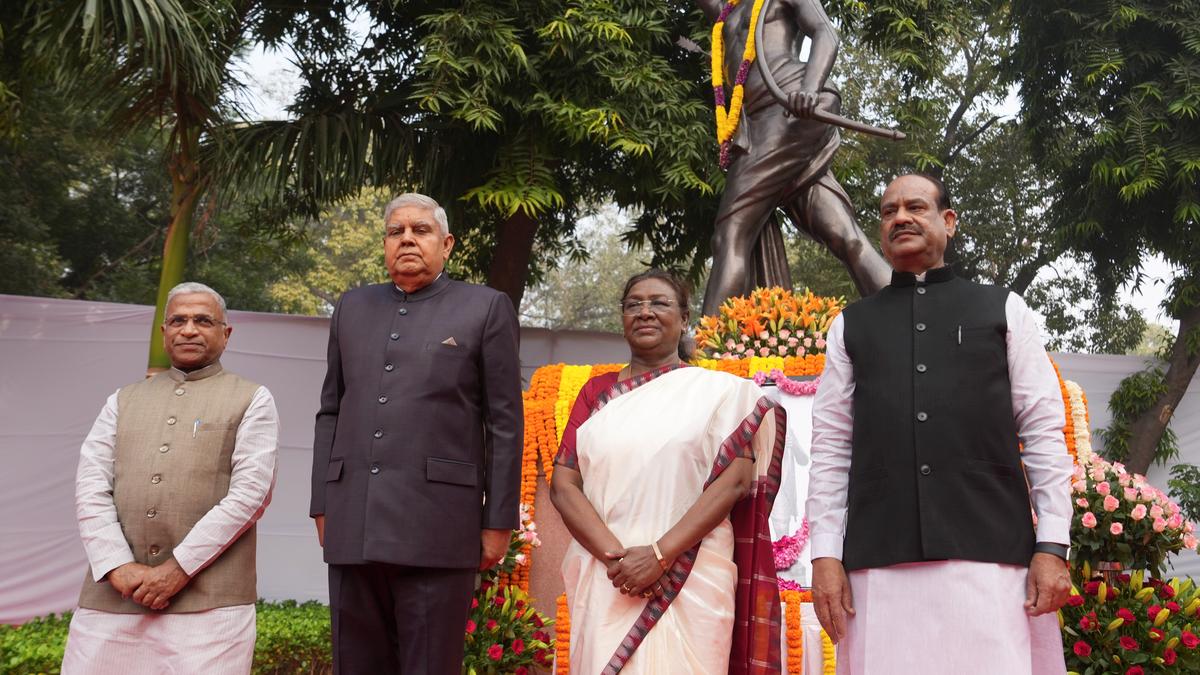
- 16 Nov 2024
In News:
On November 15, 2024, Prime Minister Narendra Modi launched a commemorative stamp and coin to mark the 150th birth anniversary of Birsa Munda, a prominent tribal freedom fighter and leader from Jharkhand.
Key Points about Birsa Munda:
- Iconic Tribal Leader: Birsa Munda, born in 1875, is often referred to as ‘Bhagwan’ (God) and ‘DhartiAaba’ (Father of the Earth) by the tribal communities. He is celebrated for his leadership in the fight against the exploitation of tribal people by both the British and non-tribal settlers.
- Ulgulan Movement: Birsa Munda led the Ulgulan (Great Tumult) against the alienation of land, forced labour, and the illegal appropriation of tribal land in the Chotanagpur Plateau. His efforts were critical in mobilizing tribal communities and challenging the colonial order.
- Religious and Social Reformer: He founded the Birsait faith, focusing on spiritual practices that emphasized prayer, worship of God, and abstaining from alcohol, fostering unity and resilience among tribal communities.
- Death and Legacy: Birsa Munda died in 1900 in British custody at the young age of 25. Despite his early death, his legacy lives on as a symbol of tribal pride and resistance.
- Janjatiya Gaurav Diwas: Since 2021, the Government of India observes November 15 as Janjatiya Gaurav Diwas (Tribal Pride Day) in honor of Birsa Munda's birth anniversary, recognizing the contributions of tribal communities and their role in India's history.
- Highlights of the 2024 Commemoration:
- Commemorative Stamp and Coin: To mark the 150th birth anniversary, the Prime Minister unveiled a commemorative stamp and coin in Bihar's Jamui district. This serves as a tribute to Munda's sacrifices for the country.
- Year-Long Celebrations: The 2024 event marks the beginning of year-long celebrations to commemorate Birsa Munda’s legacy, with a focus on tribal welfare and recognition of their historical contributions.
- Welfare Projects and Initiatives:
- Prime Minister Modi inaugurated and laid the foundation for tribal welfare projects worth over ?6,640 crore.
- The PM launched two tribal freedom fighter museums and tribal research institutes.
- 1.16 lakh homes were sanctioned under the Dharti Aba Janjati Gram Utkarsh Yojana.
- 25,000 homes for Particularly Vulnerable Tribal Groups (PVTGs) were approved under the Pradhan Mantri Janjati Adivasi Nyaya Maha Abhiyan (PM-JANMAN) scheme.
- The launch of 50 mobile medical units aims to improve healthcare access in tribal regions.
- 10 Eklavya Model Residential Schools (EMRS) were inaugurated to promote education for tribal students.
- DhartiAabaJanjatiya Gram Utkarsh Abhiyan:
- The DhartiAabaJanjatiya Gram Utkarsh Abhiyan aims to address gaps in social infrastructure, health, education, and livelihood in tribal-majority villages.
- The initiative is being implemented across 63,000 villages with the involvement of 17 ministries and departments.
- PM-JANMAN Scheme for PVTGs:
- Launched in November 2023, the PM-JANMAN initiative aims to uplift Particularly Vulnerable Tribal Groups (PVTGs) through various interventions like safe housing, clean drinking water, healthcare, education, and sustainable livelihoods. The scheme also supports Van Dhan Vikas Kendras for the trade of forest produce and solar-powered systems for households in tribal areas.
World Diabetes Day 2024
- 14 Nov 2024
In News:
- World Diabetes Day is observed on November 14th each year to raise awareness about diabetes, its prevention, and management.
- It was created by the International Diabetes Federation (IDF) and the World Health Organization (WHO).
- Significance: Commemorates the birthday of Sir Frederick Banting, who co-discovered insulin in 1922 alongside Charles Best.
- Theme (2024): "Access to Diabetes Care: Empowering Better Health for All".
History:
- Established in 1991 by the International Diabetes Federation (IDF) and World Health Organization (WHO).
- Recognized as a global observance by the UN in 2006.
- Activities: Awareness campaigns, health check-ups, educational seminars, and lighting of Blue Circle Monuments worldwide as a symbol of unity in the fight against diabetes.
Global Diabetes Data (2022):
- Total Diabetic Adults: 828 million globally.
- India's Share: 212 million (approximately 25% of global cases).
- Other Countries:
-
- China: 148 million.
- USA: 42 million.
- Pakistan: 36 million.
- Indonesia: 25 million.
- Brazil: 22 million.
Risk Factors for Diabetes:
- Global Factors: Obesity and poor diets are key contributors.
- India-Specific Factors: Dietary habits, lack of exercise, and socio-economic disparities contribute significantly to the high prevalence.
Untreated Cases:
- Global untreated cases (2022): 445 million (59% of diabetics globally).
- India untreated cases (2022): 133 million (64 million men, 69 million women).
- Complications: Untreated diabetes leads to severe health complications, including heart disease, kidney failure, and premature death.
Types of Diabetes:
- Diabetes Mellitus: The most common type of diabetes, characterized by issues with insulin production or its efficient use.
- Type 1 Diabetes (T1D):
- Autoimmune condition where the pancreas produces little or no insulin.
- Primarily affects children and young adults.
- Type 2 Diabetes (T2D):
- Insulin resistance combined with reduced insulin production.
- Often linked to lifestyle factors like obesity and physical inactivity.
- Gestational Diabetes:
- Occurs in pregnant women, leading to high blood sugar.
- Typically resolves after childbirth.
- Diabetes Insipidus:
- Imbalance of water regulation due to inadequate secretion or response to antidiuretic hormone (ADH).
- Leads to excessive urination and dehydration.
- Type 1 Diabetes (T1D):
Symptoms of Diabetes:
- Frequent urination.
- Excessive thirst and hunger.
- Unexplained weight loss.
- Blurred vision.
- Fatigue.
- Slow-healing wounds.
Role of Insulin in Managing Diabetes:
- Function of Insulin: A hormone produced by the pancreas that helps regulate blood glucose levels by facilitating glucose uptake into cells.
- In Type 1 Diabetes: Insulin injections or pumps are essential for survival.
- In Type 2 Diabetes: Insulin or oral medications may be prescribed alongside lifestyle modifications like diet and exercise.
Government Initiatives in India:
- National Programme for Prevention and Control of Cancer, Diabetes, Cardiovascular Diseases, and Stroke (NPCDCS): Focuses on awareness, early diagnosis, and management of diabetes.
- National Health Policy (2017): Aims to reduce premature deaths from non-communicable diseases by 25% by 2025.
- Ayushman Bharat – Health and Wellness Centres: Provides free screenings and consultations for diabetes and other non-communicable diseases.
- Eat Right Movement: Promotes healthier dietary habits to combat obesity and reduce diabetes risks.
- School Health Programs: Aims to educate children on healthy lifestyles to prevent the early onset of Type 2 diabetes.
Decline in African Elephant Population
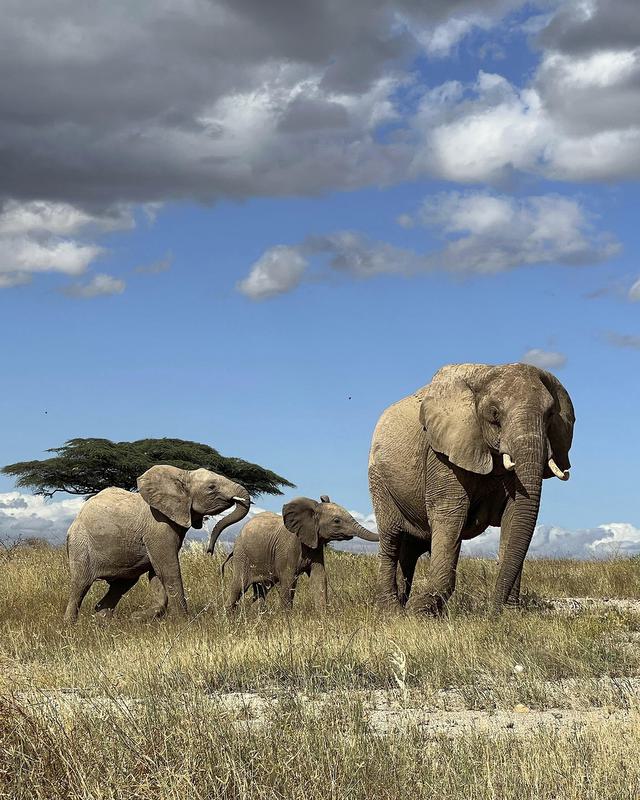
- 14 Nov 2024
In News:
- The population of African elephants has been declining rapidly, with data showing alarming drops across the African continent.
- Survey Period: The study covers population data from 475 sites in 37 countries over 52 years (1964-2016).
- Population Decrease:
- Savannah Elephants: A 70% decline on average across surveyed sites.
- Forest Elephants: A 90% decline on average across surveyed sites.
- Overall Impact: The study indicates a 77% average decline in elephant populations across both species.
Main Drivers of Decline
- Poaching: Illegal hunting for ivory and other body parts remains a major threat.
- Habitat Loss: Urbanization, agricultural expansion, and climate change are encroaching on the elephant’s natural habitats.
- Human-Elephant Conflict: Increased human settlements near elephant habitats lead to conflicts, further endangering elephant populations.
Species Overview
- Two Subspecies:
- Savannah Elephant (Loxodonta africana): Larger and more common, found in open savannas.
- Forest Elephant (Loxodonta cyclotis): Smaller and more elusive, found in dense rainforests.
- Conservation Status:
- Savannah Elephant: Endangered (IUCN).
- Forest Elephant: Critically Endangered (IUCN).
- CITES Listing: Both species are listed under CITES Appendix I, which bans international trade in endangered species.
Regional Impact
- Northern and Eastern Africa: These regions have seen drastic declines, particularly in the Sahel (Mali, Chad, Nigeria), where elephants have been extirpated (locally extinct) due to poaching and insufficient protection.
- Southern Africa: Positive Growth in some areas, particularly in Botswana, Zimbabwe, and Namibia, where elephant populations are growing due to strong conservation efforts.
Conservation Success
- Southern Africa: 42% of the surveyed sites showed increasing elephant populations, a testament to successful conservation strategies.
- Government and NGO Efforts: Successful population growth is often attributed to active management, including anti-poaching laws, protected areas, and conservation funding.
Elephant Behavior and Reproduction
- Social Structure: Elephants live in family units led by mature females, with strong social bonds.
- Low Sleep Time: Elephants sleep only 2 hours per day on average.
- Reproduction: They have a long gestation period of up to 2 years, and calves are cared for by mothers and allomothers (non-mother females).
Conservation Challenges
- Sustainability: Continued poaching and habitat destruction threaten to undo gains made in conservation.
- Fragmentation of Populations: With many elephants in isolated pockets, genetic diversity is declining, which could lead to long-term problems for species survival.
Jawaharlal Nehru Memorial Fund (JNMF)
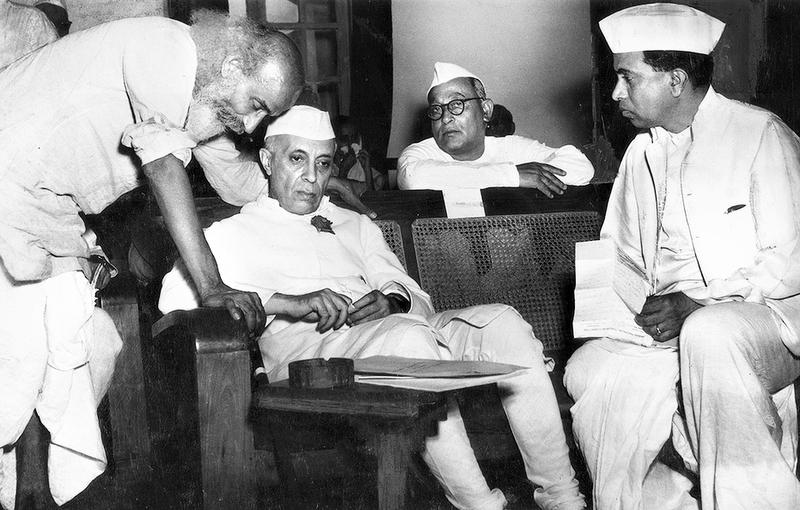
- 14 Nov 2024
In News:
Jawaharlal Nehru Memorial Fund to launch ‘Nehru Archive’ next year.
Nehru Archive Initiative
- Launch Date: The Nehru Archive will go online on November 14, 2025, coinciding with Jawaharlal Nehru's birth anniversary.
- Purpose: The archive will showcase less-known published and unpublished works of India’s first Prime Minister, Jawaharlal Nehru, including his speeches, letters to Chief Ministers, and other writings.
Archive Content
- Key Features:
- 100 volumes of The Selected Works of Jawaharlal Nehru.
- Letters to Chief Ministers (1947-1964), documenting Nehru's communication with state leadership.
- Nehru’s iconic books like:
-
-
- The Discovery of India
- Glimpses of World History
- Letters from a Father to His Daughter
- An Autobiography
- The Unity of India
- A Bunch of Old Letters
-
-
- Speeches from 1917 to 1964.
- Writings on Nehru by his contemporaries.
- Global archival material from international sources.
- Objective: The goal is to provide dynamic, continuously updated, open-ended access to Nehru’s work, making it the most important research source on Nehru.
Significance
- Educational and Intellectual Contribution: The archive will serve as a comprehensive, accessible source of information for students, scholars, and the general public to understand Nehru’s contributions to the making of modern India.
- Preservation of Legacy: It will preserve and promote Nehru’s intellectual legacy and his vision for India's development post-independence.
- Historical Importance: The archive will help contextualize Nehru’s leadership during critical periods of Indian history, including India’s independence, partition, and post-independence challenges.
Governance and Establishment of JNMF
- Founded: The Jawaharlal Nehru Memorial Fund (JNMF) was established in 1964 through a Deed of Declaration of Trust following a National Committee chaired by Dr. S. Radhakrishnan, then President of India.
- Purpose: To preserve and promote Nehru's legacy, especially his role in shaping modern India.
- Governance: The JNMF is governed by 14 trustees and is currently headed by Sonia Gandhi, the Chairperson of the Congress Parliamentary Party.
India’s Vision of ‘Adaptive Defence’
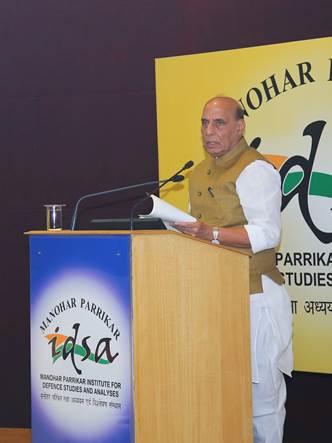
- 13 Nov 2024
In News:
- Defence Minister Shri Rajnath Singh introduced the concept of ‘Adaptive Defence’ at the inaugural Delhi Defence Dialogue (DDD).
- Adaptive Defence aims to prepare India's military for the rapidly changing landscape of modern warfare, with evolving threats and technologies shaping global security.
Key Aspects of Adaptive Defence:
- Strategic Approach:
- Adaptive Defence is an evolving strategy where military and defence systems continuously adjust to emerging threats, focusing on proactive preparedness rather than reactive responses.
- It is based on anticipating future threats, fostering flexibility, resilience, and agility in both strategic and tactical responses.
- Core Elements:
- Situational Awareness: The ability to understand and respond to dynamic, often unpredictable environments.
- Flexibility & Agility: At both the strategic and tactical levels to ensure swift and effective responses.
- Resilience: The capacity to recover and adapt quickly to unforeseen circumstances.
- Integration with Emerging Technologies: Emphasis on adopting cutting-edge technologies like AI, drones, and cybersecurity to stay ahead of adversaries.
The Changing Nature of Warfare:
- Grey Zone & Hybrid Warfare:
- Modern conflicts now often occur in the grey zone and involve hybrid warfare, blending traditional and non-traditional threats like cyber-attacks, terrorism, and psychological warfare.
- These new threats demand continuous adaptation in strategies, doctrines, and military operations.
- Technological Transformation:
- Drones and swarm technologies are reshaping warfare. India aspires to become a global hub for drones, leveraging these technologies for both economic and military growth.
- The increasing significance of Artificial Intelligence (AI), cyber capabilities, and quantum technologies in defence highlights the need for international collaboration in research and innovation.
- Psychological Warfare:
- The rise of information overload and psychological warfare challenges traditional defence paradigms. Manipulation of information to influence public opinion and disrupt decision-making processes is now a key threat.
Government Initiatives for Adaptive Defence:
- Institutional Strengthening:
- Establishment of the Chief of Defence Staff (CDS) and initiatives to enhance jointness among the three armed services (Army, Navy, Air Force) to create a unified strategic force.
- Reform of training curricula and emphasis on integrated operations to ensure readiness for new-age warfare.
- Focus on Self-Reliance:
- Strengthening the indigenous defence sector through initiatives like Make in India and the Aatmanirbhar Bharat campaign.
- Increasing foreign direct investment (FDI) in defence and promoting defence exports, with India currently exporting to over 100 nations.
- Drone Hub Vision:
- India aims to become the world’s drone hub, supporting R&D and fostering innovation to develop reliable certification mechanisms and enhance Indian intellectual property in the drone sector.
- Programs like iDEX (Innovations for Defence Excellence) and ADITI are rewarding innovation and driving India's defence sector towards greater self-sufficiency.
- Technology and Innovation:
- Focus on cybersecurity, AI, and quantum technologies to develop solutions that address both national and global security challenges.
- India is also working on Theaterisation, integrating the three services into a unified force structure for enhanced coordination and joint operations.
- Defence Acquisition and Export:
- Introduction of the Defence Acquisition Procedure 2020, establishment of Defence Industrial Corridors in Uttar Pradesh and Tamil Nadu, and a Positive Indigenisation List to boost self-reliance.
- India is actively increasing defence exports, aiming for Rs 50,000 crore worth of exports by 2029, with key export destinations including the USA, France, and Armenia.
Strategic Vision for the Future:
- Collaborative Approach:
- Given the interconnectedness of global security, the defence minister emphasized the importance of a collaborative approach in dealing with transnational threats.
- Cross-border issues, cyberspace threats, and the potential of quantum and nanotechnologies demand the sharing of knowledge and strategies across borders.
- Joint Military Vision:
- Jointness in defence strategy should go beyond national borders and should involve international cooperation in response to global security challenges.
- The need for interconnected solutions in the face of transnational threats underscores the importance of multilateral cooperation.
Sudden Resurgence of H5N1 in Cambodia
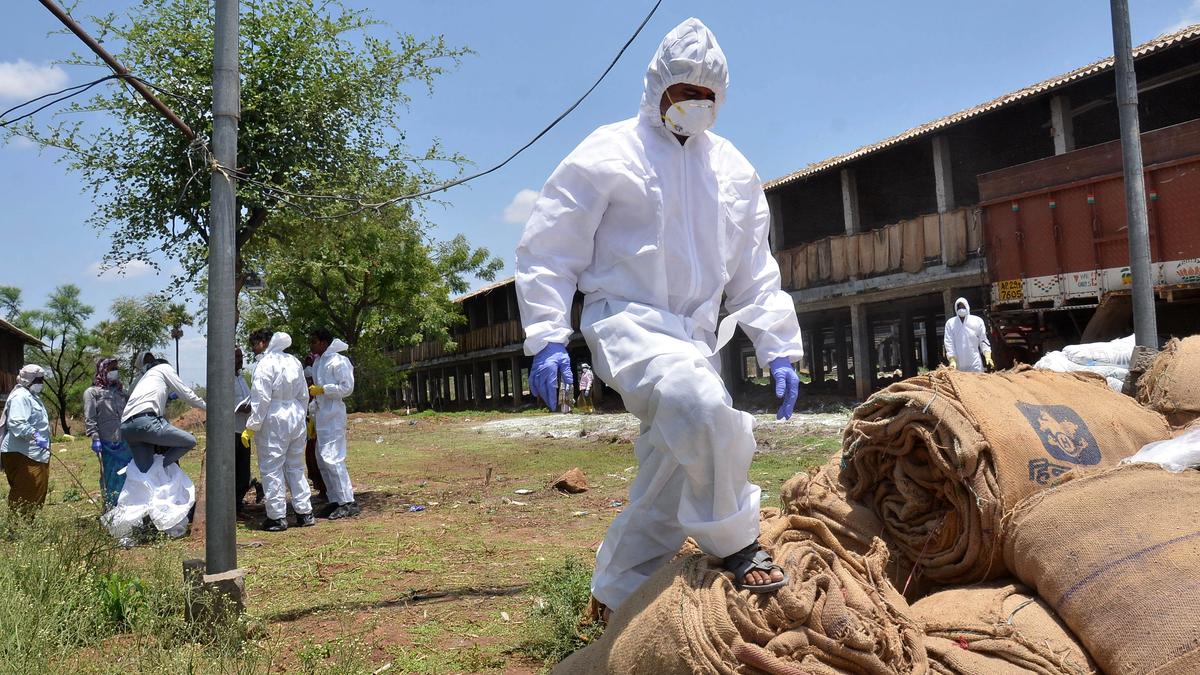
- 13 Nov 2024
In News:
- Cambodia saw a resurgence of H5N1 avian influenza cases after over 10 years of no human infections.
- From February 2023 to August 2024, 16 human cases were reported, with 3 deaths caused by the A/H5 clade 2.3.2.1c virus.
- Notably, 14 of these cases were caused by a novel reassortant virus, involving a mixture of clade 2.3.2.1c and clade 2.3.4.4b gene segments.
Key Points:
- Reassortment of the Virus:
- The reassortment between clades 2.3.2.1c (Southeast Asia) and 2.3.4.4b (global spread) has created a new strain.
- This reassortant virus is responsible for the second wave of infections in humans, starting in October 2023.
- Zoonotic Transmission:
- Investigations confirmed that direct contact with sick poultry or bird droppings was the primary source of human infections.
- There have been no reported cases of human-to-human transmission.
- The novel reassortant virus appears to have replaced the 2.3.2.1c strain in Cambodian poultry.
- Geographic Spread and Spillovers:
- Clade 2.3.2.1c was first reported in Cambodian poultry in March 2014. It continued to circulate in both poultry and wild birds.
- Clade 2.3.4.4b viruses began circulating in Cambodian live bird markets by 2021, co-existing with clade 2.3.2.1c.
- There were two key spillovers to humans:
- The first spillover in February 2023, associated with clade 2.3.2.1c, involved two related individuals, with one death.
- The second spillover, beginning in October 2023, involved the novel reassortant virus.
- Genetic Analysis and Mutation Concerns:
- Genetic sequencing showed significant changes in the hemagglutinin (HA) gene of viruses from human cases, indicating a shift from older local strains to newer sublineages.
- The PB2 627K mutation in the novel reassortant is concerning, as it is linked to increased mammalian adaptation and the potential for airborne transmission, particularly in mammals like ferrets.
- This mutation raises concerns about the virus’s ability to adapt to humans or other mammals.
- Environmental and Epidemiological Factors:
- The reassortment is believed to have been facilitated by:
- High-density poultry farming.
- Wild bird migration.
- Cross-border poultry trade in Southeast Asia.
- These factors heighten the risk of zoonotic transmission, emphasizing the need for continued vigilance in the region.
- The reassortment is believed to have been facilitated by:
- Surveillance and Response:
- One Health investigations linked human cases to infected poultry, highlighting the importance of rapid response through whole genome sequencing.
- The ongoing surveillance is critical, as the novel reassortant strain has already replaced clade 2.3.2.1c in Cambodian poultry.
- Public Health Recommendations:
- There is an urgent need to strengthen sustained surveillance of avian influenza in both poultry and wild birds, particularly in Southeast Asia.
- Public health strategies should focus on:
- Reducing human exposure to infected poultry.
- Promoting safe poultry handling practices.
- Encouraging early healthcare-seeking behavior in individuals with potential symptoms.
Accessibility for Disabled Persons
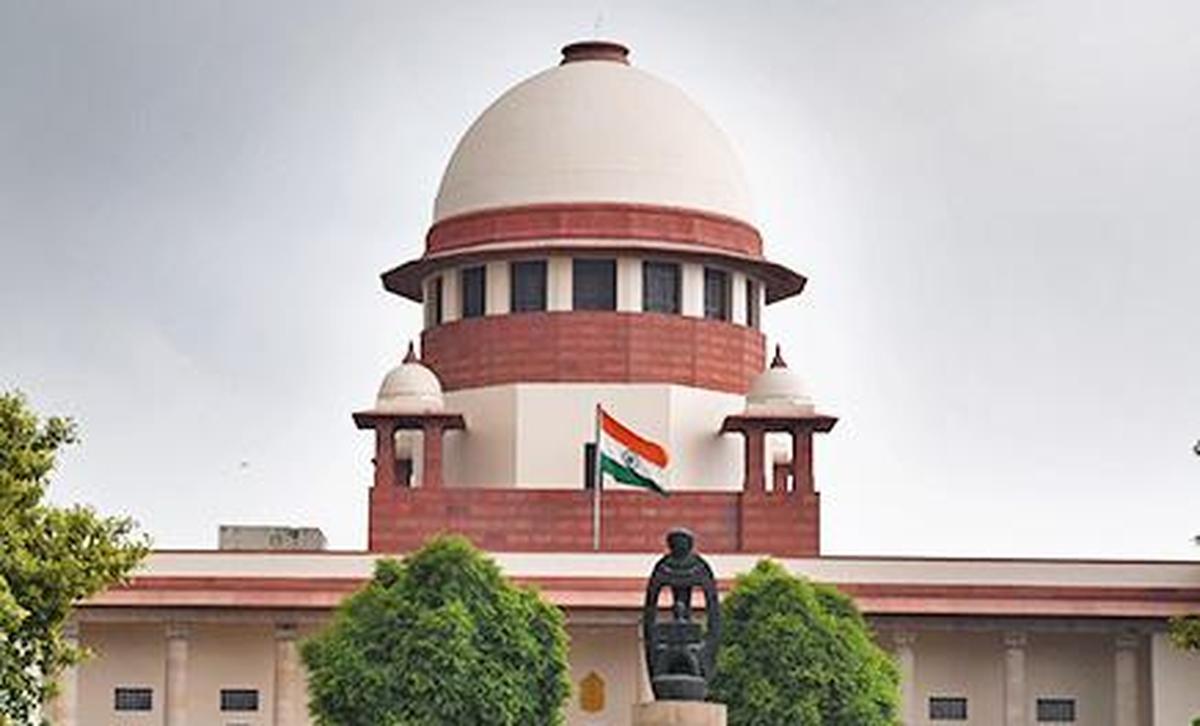
- 13 Nov 2024
In News:
Recently, the Supreme Court of India delivered a significant ruling affirming that the right of persons with disabilities (PwDs) to access environments, services, and opportunities is a fundamental human right. The judgment was made in the case of RajiveRaturi vs. Union of India &Ors. and is based on a report submitted by the Centre for Disability Studies (CDS) at NALSAR University of Law.
Key Points of the Judgment:
- Social Model of Disability:
- The Court upheld the social model of disability, which focuses on societal changes to ensure the full inclusion and participation of PwDs.
- The model emphasizes removing social barriers and creating an inclusive environment that accommodates all disabilities.
- Challenges Faced by PwDs: The ruling highlighted various challenges faced by PwDs, as identified in the CDS NALSAR report:
- Accessibility Barriers: Significant gaps exist in accessibility measures across public spaces such as courts, prisons, schools, and public transport.
- Intersectionality & Compounded Discrimination: PwDs often face multiple layers of discrimination, such as caste, gender, and socio-economic status, which compound their marginalization.
- Inconsistent Legal Framework: The RPwD Act (2016) mandates mandatory compliance for accessibility standards, but Rule 15 under RPwD Rules (2017) only offers self-regulatory guidelines, which the Court found insufficient.
- Court's Analysis of Rule 15:
- The Court declared Rule 15(1) of the RPwD Rules, 2017, as ultra vires, meaning it is inconsistent with the mandatory compliance intended by the RPwD Act.
- The Court stressed the need for stronger legal and regulatory enforcement to ensure access for PwDs.
- Principles of Accessibility: The Court outlined several essential principles for achieving accessibility:
- Universal Design: Environments and services should be universally accessible to all, including PwDs.
- Comprehensive Inclusion: All types of disabilities, both visible and invisible, should be addressed.
- Assistive Technology Integration: Using technology to support PwDs in daily activities.
- Stakeholder Consultation: PwDs and disability advocacy groups must be consulted in planning and designing accessible spaces.
- Two-Pronged Approach:
- The Court recommended a two-pronged approach:
- Ensure accessibility in existing infrastructure: Modify and update current institutions and services to become accessible.
- Design future infrastructure with accessibility in mind: Plan and build new spaces and services that are inclusive from the start.
- The Court recommended a two-pronged approach:
Legal and Policy Framework:
- Rights of Persons with Disabilities (RPwD) Act, 2016:
- The RPwD Act mandates various accessibility standards and provisions to protect and promote the rights of PwDs, in alignment with India’s obligations under the United Nations Convention on the Rights of Persons with Disabilities (UNCRPD), which India ratified in 2007.
- The Act defines a person with a benchmark disability as someone with at least 40% of a specified disability.
- International Obligations:
- The ruling reaffirmed the importance of Article 9 of the UNCRPD, which emphasizes the right of PwDs to access the physical environment, transport, and information and communication technologies.
- Government Initiatives: The judgment highlights several initiatives aimed at improving accessibility:
- Accessible India Campaign (Sugamya Bharat Abhiyan): A nationwide effort to make public spaces and services accessible to PwDs.
- Assistance for Aids and Appliances: Government schemes to provide PwDs with necessary aids and appliances.
- Unique Disability Identification Portal: A platform for PwDs to register and obtain a disability certificate.
Notable Judicial Precedents:
The Court referred to several previous rulings that recognized the right to accessibility:
- State of Himachal Pradesh v. Umed Ram Sharma (1986): The Court included the right to accessibility under the Right to Life (Article 21) of the Constitution.
- Disabled Rights Group v. Union of India (2017): The Court directed that educational institutions ensure reserved seats for PwDs.
RNA Editing

- 09 Nov 2024
In News:
Wave Life Sciences became the first biotechnology company to treat a genetic condition by editing RNA at the clinical level.
- What is RNA Editing?
- Definition: RNA editing is the modification of messenger RNA (mRNA) after it’s synthesized from DNA but before it is translated into proteins.
- Process: mRNA consists of exons (coding regions) and introns (non-coding regions). Exons code for proteins, while introns are removed before protein synthesis.
- Types of RNA Modifications:
- Addition: Insertion of a nucleotide.
- Deletion: Removal of a nucleotide.
- Substitution: Replacement of one nucleotide with another.
- Mechanism of RNA Editing:
- Involves Adenosine Deaminase Acting on RNA (ADAR) enzymes.
- ADAR enzymes modify adenosine to inosine, which is recognized as guanosine, allowing mRNA to be corrected.
- Guide RNA (gRNA) directs ADAR enzymes to the specific mRNA region for editing.
- Clinical Use of RNA Editing:
- Wave Life Sciences used RNA editing to treat α-1 antitrypsin deficiency (AATD), a genetic disorder.
- Other potential applications include treating diseases such as Huntington’s disease, Duchenne muscular dystrophy, Parkinson’s disease, obesity, and neurological disorders.
- Challenges in RNA Editing:
- Temporary Effects: RNA editing provides temporary changes, requiring repeated treatments for sustained effects.
- Delivery Issues: Current delivery methods, like lipid nanoparticles and adeno-associated virus vectors, have limitations in carrying large molecules.
- Specificity: ADARs may cause unintended changes in non-target regions of mRNA, leading to potential side effects.
- Comparison: RNA Editing vs. DNA Editing:
- Safety: RNA editing causes temporary changes and presents fewer risks than DNA editing, which makes permanent alterations to the genome.
- Immune Response: RNA editing uses enzymes naturally found in the body (ADAR), which reduces the risk of immune reactions, unlike DNA editing tools like CRISPR-Cas9 that can trigger immune responses.
- Significance of RNA:
- Structure: RNA is a nucleic acid, similar to DNA but typically single-stranded. It consists of a backbone of ribose sugars and phosphate groups, with bases adenine (A), uracil (U), cytosine (C), and guanine (G).
- Types of RNA:
- Messenger RNA (mRNA): Carries genetic information from DNA to ribosomes for protein synthesis.
- Ribosomal RNA (rRNA): Forms the core of the ribosome and catalyzes protein synthesis.
- Transfer RNA (tRNA): Transfers amino acids to ribosomes during protein synthesis.
- Regulatory RNAs: Regulate gene expression.
- α-1 Antitrypsin Deficiency (AATD):
- A genetic disorder where the protein α-1 antitrypsin accumulates in the liver, damaging both the liver and lungs.
- Treatments include weekly intravenous therapy or, in severe cases, liver transplants.
- RNA editing offers a potential new treatment approach.
- Global Impact:
- RNA editing is still in its early stages but shows promise for treating a wide range of genetic and chronic conditions.
- Ongoing research and clinical trials suggest RNA editing could become a key part of future gene-editing therapies.
Global Education Monitoring Report 2024
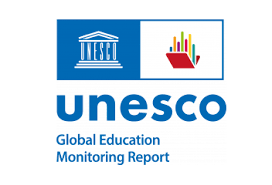
- 09 Nov 2024
In News:
- Released at the Global Education Meeting, hosted in Fortaleza by Brazil, the G20 President.
- Highlights progress and challenges in global education, with a focus on leadership, financing, and access.
Key Observations:
Leaders as Agents of Change:
- Education leadership is defined as social influence towards achieving common educational goals.
- Education leaders must:
- Define clear purposes and influence change.
- Balance learning outcomes with equity, quality, and inclusion.
Funding Deficits:
- 4 out of 10 countries spend less than 4% of their GDP on education.
Out-of-School Children:
- 251 million children and youth globally remain out of school, with only a 1% reduction since 2015.
Regional Disparities in Education Access:
- Central and Southern Asia show significant progress, but countries like Afghanistan, Bangladesh, India, and Pakistan still have large out-of-school populations.
Recommendations:
- Leadership Development: Empower school principals with the autonomy to manage schools effectively.
- Capacity Building for System Leaders: Strengthen the ability of education officials to act as system leaders.
- Climate Change Education: Introduce climate change topics in early education across subjects, not limited to science.
India’s Educational Initiatives:
- National Education Policy (NEP) 2020: Focuses on developing school leadership through training and workshops for principals.
- NISHTHA Program: Aims to improve leadership and management competencies of school heads and teachers.
Current Educational Landscape:
- Since 2015, 110 million children have entered school, and 40 million more complete secondary education.
- However, 33% of children in low-income countries remain out of school, compared to only 3% in high-income countries.
- Sub-Saharan Africa houses more than half of the global out-of-school youth.
Challenges in Education Financing:
- UNESCO–World Bank report highlights that 40% of countries allocate less than 15% of their public expenditure to education.
- Countries investing less than 4% of GDP in education face significant resource shortages.
- Low-income countries spend an average of $55 per learner, while high-income countries spend $8,543 per learner.
Need for Innovative Financing Mechanisms:
- Debt-for-Education Swaps: Proposes converting unsustainable debt into funding for education, leveraging past successful initiatives.
- Multilateral Platforms: Suggested to facilitate global negotiations for converting debt into educational investments, involving entities like UNESCO and the G20.
International Cooperation and Solidarity:
- Decline in Education Assistance: Official development assistance for education has decreased from 9.3% in 2019 to 7.6% in 2022.
- Strengthening Partnerships: The need for enhanced global cooperation to fill the educational financing gap and ensure equitable access to quality education.
PM-Vidyalaxmi Scheme
- 07 Nov 2024
In News:
- The Union Cabinet, chaired by Prime Minister Narendra Modi, approved the PM Vidyalaxmi scheme to provide financial assistance to meritorious students for higher education.
- Objective: The scheme aims to ensure that financial constraints do not hinder students from pursuing quality higher education.
Key Features of the scheme:
- Eligibility:
- Students admitted to top 860 Quality Higher Education Institutions (QHEIs) are eligible.
- Includes both government and private institutions, as per the NIRF (National Institutional Ranking Framework) rankings.
- Loan Provision:
- Collateral-free and guarantor-free education loans for tuition fees and other course-related expenses.
- Loans up to ?7.5 lakhs will have a 75% credit guarantee from the government to encourage banks to offer loans.
- Interest Subvention:
- For students with an annual family income of up to ?8 lakhs (and not eligible for other scholarships or schemes), a 3% interest subvention will be provided on loans up to ?10 lakhs.
- This subvention applies during the moratorium period (when repayment is deferred).
- Preference for interest subvention is given to students in technical/professional courses and those from government institutions.
- Target Beneficiaries:
- Around 22 lakh students are expected to benefit from the scheme annually.
- The government has allocated ?3,600 crore for the period 2024-2025 to 2030-2031, with 7 lakh fresh students anticipated to receive the benefit each year.
- Digital Process:
- A unified “PM-Vidyalaxmi” portal will allow students to apply for loans and interest subvention in a simplified, transparent, and digital manner.
- Payment Method:
- Interest subvention will be paid via E-vouchers or Central Bank Digital Currency (CBDC) wallets.
Loan Product Features
- Collateral-free & Guarantor-free: Loans will be accessible without the need for collateral or a guarantor.
- Loan Coverage:
- The scheme will cover full tuition fees and other related expenses.
- Eligibility Criteria:
- Students enrolled in NIRF top 100 HEIs, state institutions ranked 101-200, and central government institutions are eligible.
- The list of eligible institutions will be updated annually based on the latest NIRF rankings.
Government's Commitment
- The scheme is a part of the National Education Policy 2020’s vision to enhance access to quality education through financial support.
- Additional Support:
- It complements the existing Central Sector Interest Subsidy (CSIS) and Credit Guarantee Fund Scheme for Education Loans (CGFSEL) under PM-USP.
- The CSIS scheme provides full interest subvention for students with an annual family income of up to ?4.5 lakhs, pursuing technical/professional courses.
India-Algeria Strengthen Defence Ties

- 06 Nov 2024
In News:
- The Chief of Defence Staff (CDS) of India recently visited Algeria, culminating in the signing of a significant Memorandum of Understanding (MoU) on defence cooperation.
- Objective: The MoU aims to strengthen the strategic and military ties between India and Algeria.
Recent Developments in India-Algeria Relations
- Important Visit: The CDS’s visit coincided with Algeria’s 70th anniversary of its revolution, celebrated on November 1st, with military parades and ceremonies highlighting Algeria’s historical and political legacy.
- Defence Cooperation:
- India re-established its defence wing in Algeria, and Algeria reciprocated by considering the establishment of its defence wing in India.
- India emphasized its role as a “Vishwa Bandhu” (global partner) and offered to share defence expertise and experiences with Algeria.
- Strategic Discussion: The MoU aims to enhance mutual understanding, laying the foundation for long-term defence collaboration across multiple sectors, including manufacturing under India’s 'Make in India' and 'Make for the World' initiatives.
- Global Peace Support: CDS reiterated India’s commitment to peaceful conflict resolution and expressed support for Algeria’s defence interests.
Significant Areas of India-Algeria Relationship
- Diplomatic Relations:
- India and Algeria established diplomatic ties in July 1962, the same year Algeria gained independence from French colonial rule.
- India supported Algeria's liberation movement and both countries have maintained close ties as part of the Non-Aligned Movement.
- Bilateral Trade:
- Trade peaked at USD 2.9 billion in 2018 but dropped to USD 1.5 billion by 2021 due to COVID-19 and Algeria’s import restrictions.
- Trade rebounded in 2022, increasing by 24% to USD 2.1 billion.
- Exports from India (2023-24): Rice, pharmaceuticals, granite.
- Imports from Algeria: Petroleum oils, LNG, calcium phosphates.
- Bilateral Agreements:
- 2015 MoU: Between All India Radio (AIR) and Algerian National Radio for cooperation in broadcasting.
- 2018 Space Cooperation Agreement: Focuses on satellite technology for applications like crop forecasting and disaster management.
- Visa Waiver Agreement (2021): Diplomatic and official passport holders are exempt from visa requirements.
- Cultural Engagement:
- International Day of Yoga (2024): Celebrated in Algeria at the Jardin d’Essai du Hamma, attracting over 300 participants.
- Space Cooperation:
- The 2018 India-Algeria Space Cooperation Agreement focuses on joint space science, technology, and applications.
- India has launched four Algerian satellites (2016), and the 2022 Joint Committee Meeting expanded satellite capacity building efforts.
- Algeria’s space agency has engaged with ISRO on satellite applications like crop forecasting and disaster management.
- Indian Community in Algeria:
- Approximately 3,800 Indians live in Algeria, working in various sectors, including technical and semi-skilled roles.
- The community includes 13 Overseas Citizens of India (OCI), 10 Persons of Indian Origin (PIOs), and 15 Indian students.
LignoSat
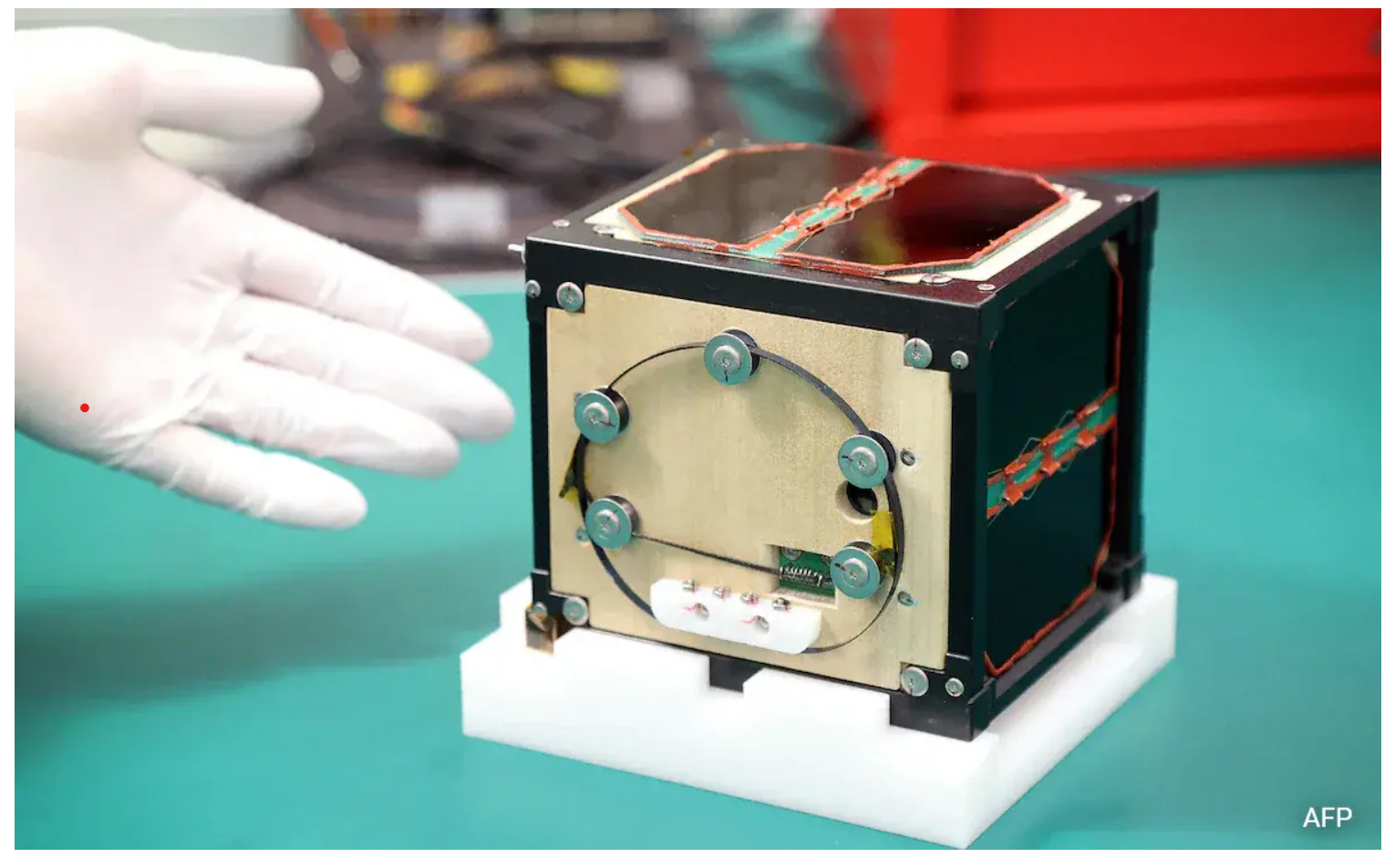
- 04 Nov 2024
In News:
The world's first wooden satellite, LignoSat, is set to launch from the Kennedy Space Center aboard a SpaceX rocket. This pioneering satellite is a collaborative effort between Kyoto University and Sumitomo Forestry Co., marking a significant step towards exploring more sustainable materials in space exploration.
Key Highlights:
- Purpose:The primary goal of LignoSat is to test the viability of using wood in space technology, with a focus on the eco-friendliness and cost-effectiveness of using renewable materials in satellite construction. The satellite will be tested aboard the International Space Station (ISS) to assess its durability, strength, and ability to withstand extreme space conditions.
- Material:The satellite is crafted from magnolia wood, chosen for its durability and adaptability. Magnolia was selected for its strength, making it a suitable candidate to endure the harsh conditions of space travel and the intense environmental factors faced in space exploration.
- Mission Details:Once launched, LignoSat will be sent to the ISS, where it will be released from the Japanese Experiment Module (Kibo). Researchers will collect data on the satellite’s performance, examining its ability to handle the challenges of space, including temperature fluctuations and physical strain.
- Environmental Benefits:One of the key advantages of wooden satellites is their environmental impact. Traditional metal satellites, when re-entering the Earth's atmosphere, can generate metal particles that contribute to air pollution. In contrast, wooden satellites like LignoSat are designed to be eco-friendly during reentry. Wood is a natural material that burns up more cleanly during reentry, reducing the potential for harmful atmospheric pollution.
Tumaini Festival
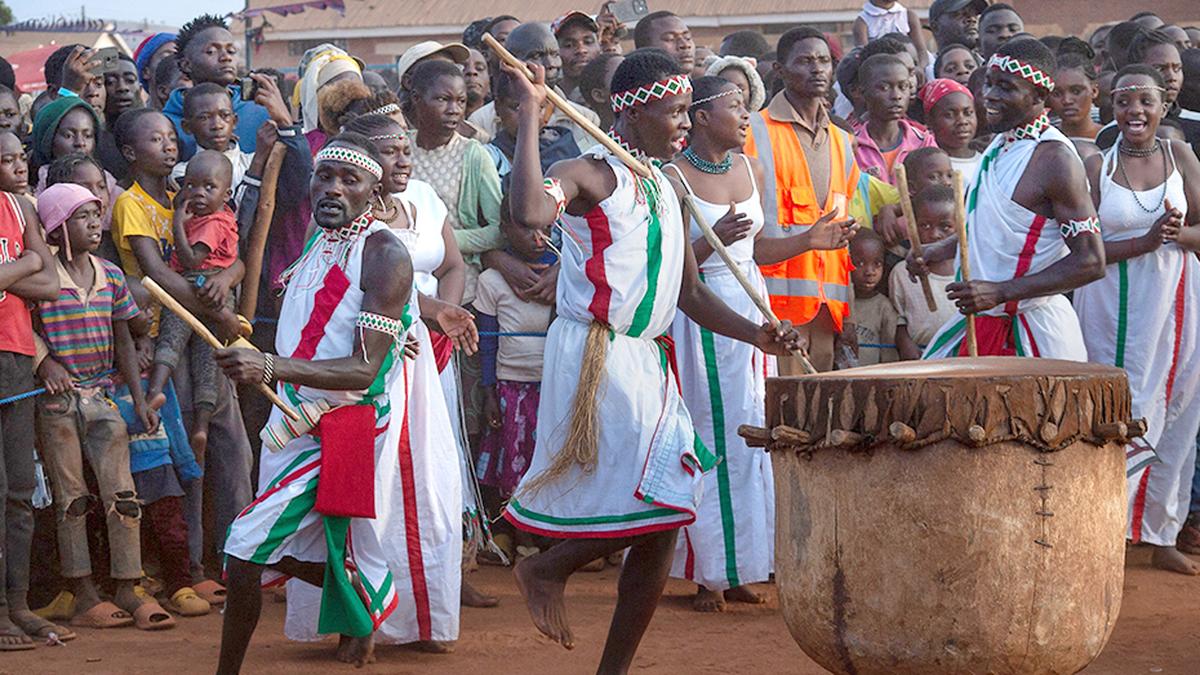
- 04 Nov 2024
In News:
- The Tumaini Festival is held annually in the Dzaleka Refugee Camp in Malawi, one of the world’s few music festivals hosted within a refugee camp. It brings together refugees and locals for cultural exchange, showcasing music, art, and crafts.
- Dates: The festival runs from Thursday to Saturday each year, typically in November.
- Founded: In 2014 by Congolese poet Menes La Plume.
Festival Highlights:
- The festival features performances from a diverse range of artists, including refugees and local Malawians, as well as artists from South Africa, Zimbabwe, and beyond.
- In 2024, performances included Jetu, a 72-year-old singer, and Vankson Boy V, a Congolese refugee, alongside other acts like Maveriq Mavo from South Africa.
- The festival aims to:
- Celebrate cultural exchange and community solidarity between refugees and locals.
- Humanize the refugee experience by allowing refugees and locals to share common experiences and celebrate cultural diversity.
- Challenge stereotypes by showing refugees as people with the same aspirations, talents, and desires as locals.
Significance of Dzaleka Refugee Camp:
- Location: Situated near Lilongwe, Malawi, Dzaleka was originally a prison before becoming a refugee camp in 1994.
- Capacity: Initially designed for 10,000 refugees, the camp now hosts over 60,000 individuals from countries like Democratic Republic of Congo (DRC), Rwanda, Burundi, Ethiopia, and Somalia.
- Role: Dzaleka has evolved into a hub for humanitarian aid, cultural exchange, and empowerment of its residents.
First Science Result from India's Aditya-L1 Mission
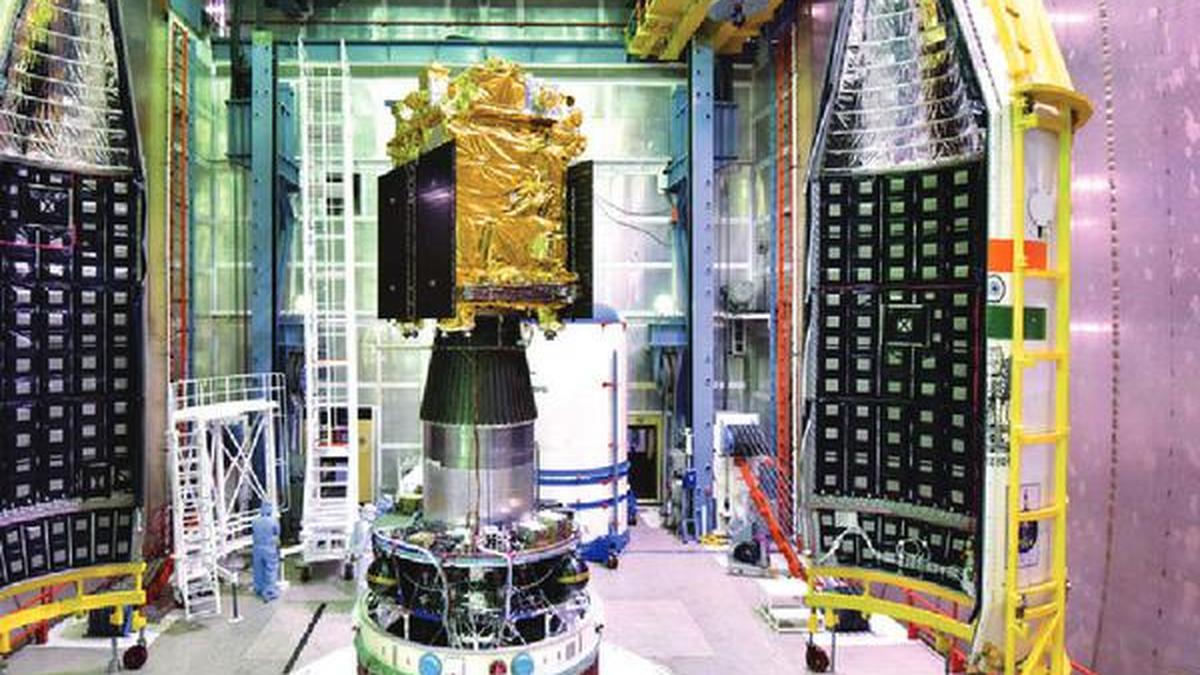
- 04 Nov 2024
In News:
- The Aditya-L1 mission, launched by the Indian Space Research Organisation (ISRO) on September 2, 2023, is India's first dedicated scientific mission to study the Sun.
- Primary Payload: The Visible Emission Line Coronagraph (VELC), developed by the Indian Institute of Astrophysics (IIAp), Bengaluru, is the spacecraft's main instrument.
Key Highlights:
- First Science Outcome:The first scientific result from the mission, involving VELC, has been released. It successfully estimated the onset time of a coronal mass ejection (CME) that occurred on July 16, 2023.
- CMEs are massive solar eruptions that can disrupt electronics in satellites and communications on Earth.
- Key Findings:
- VELC's Role: The VELC payload was crucial in observing the CME close to the solar surface, providing a detailed understanding of its onset.
- CMEs are typically observed in visible light after they have traveled far from the Sun. However, VELC’s unique spectroscopic observations allowed scientists to study the CME much closer to the Sun's surface.
- Publication:The results will be published in the Astrophysical Journal Letters.
- Future Significance:
- As the Sun approaches the maximum phase of its current solar cycle (No. 25), CMEs are expected to become more frequent. Continuous monitoring with VELC will provide valuable data for understanding these events.
- Monitoring the thermodynamic properties of CMEs near the Sun is essential to understand their source regions and behavior.
- Mission Details:
- The spacecraft is in a halo orbit around the Lagrange Point 1 (L1), about 1.5 million kilometers from Earth.
- Mission Lifetime: 5 years.
First in the World Challenge
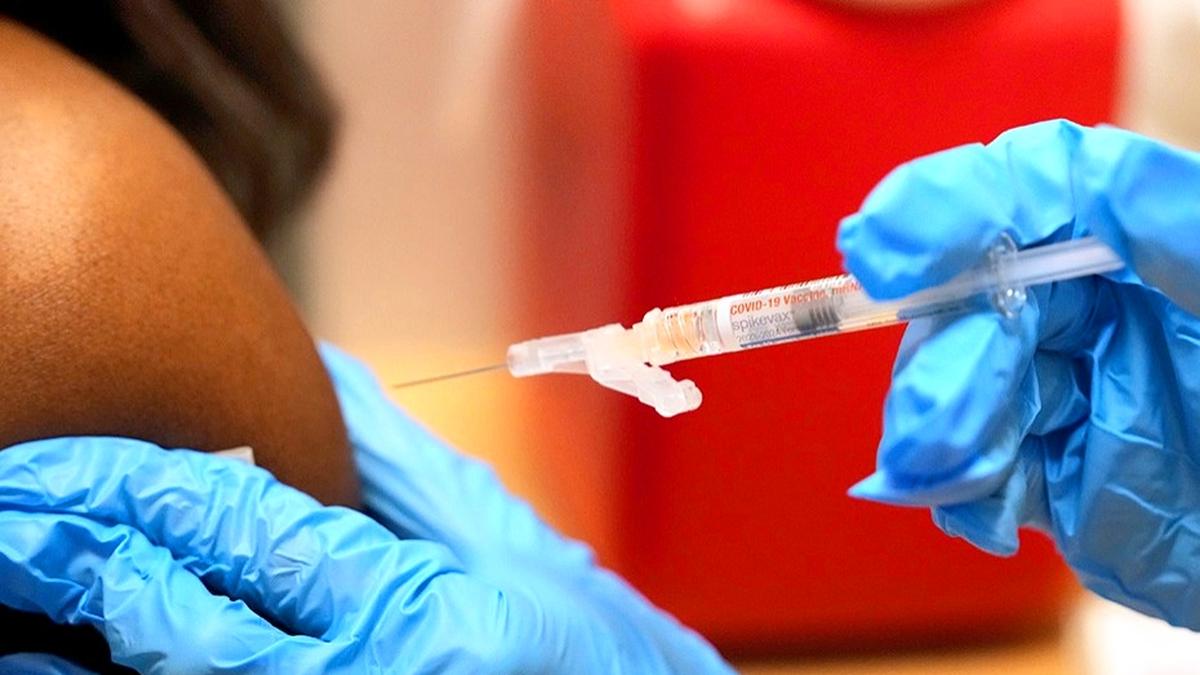
- 03 Nov 2024
In News:
ICMR announces ‘First in the World Challenge’ to encourage scientists to find innovative ideas to tackle health issues.
Key Highlights:
- Objective:
- Encourage bold, out-of-the-box ideas for solving difficult health problems.
- Aim to foster novel and groundbreaking biomedical innovations (vaccines, drugs, diagnostics, interventions, etc.).
- Target projects that are “first of their kind” and have never been tried or tested globally.
- Key Features of the Initiative:
- Focus on Groundbreaking Innovations:
- Emphasis on high-risk, high-reward ideas with potential for significant global health impact.
- Excludes proposals aiming for incremental knowledge or process innovation.
- Scope of Research:
- Breakthroughs in biomedical and health technologies such as:
- Vaccines
- Drugs/Therapeutics
- Diagnostics
- Interventions
- Breakthroughs in biomedical and health technologies such as:
- Focus on Groundbreaking Innovations:
- Funding & Support:
- Provides funding for projects at various stages, from proof-of-concept to prototype development and final product.
- Support for projects that have the potential to lead to “first-of-its-kind” biomedical innovations.
- Application Process:
- Open to individual researchers or teams (from single or multiple institutions).
- Teams must designate a Principal Investigator responsible for the project’s technical, administrative, and financial aspects.
- Selection Criteria:
- A selection committee will be formed with:
- Experts, innovators, policymakers, and distinguished scientists with an outstanding research record.
- Proposals evaluated based on originality, impact potential, and innovation.
- A selection committee will be formed with:
About the Indian Council of Medical Research (ICMR)
- History:Founded in 1911 as the Indian Research Fund Association (IRFA), renamed ICMR in 1949.
- Role & Mandate:
- Ministry of Health and Family Welfare, Government of India.
- Formulates, coordinates, and promotes biomedical research in India.
- Focus on improving public health and addressing national health challenges.
- Vision:“Translating Research into Action for Improving the Health of the Population.”
Asset Recovery Interagency Network–Asia Pacific (ARIN-AP)
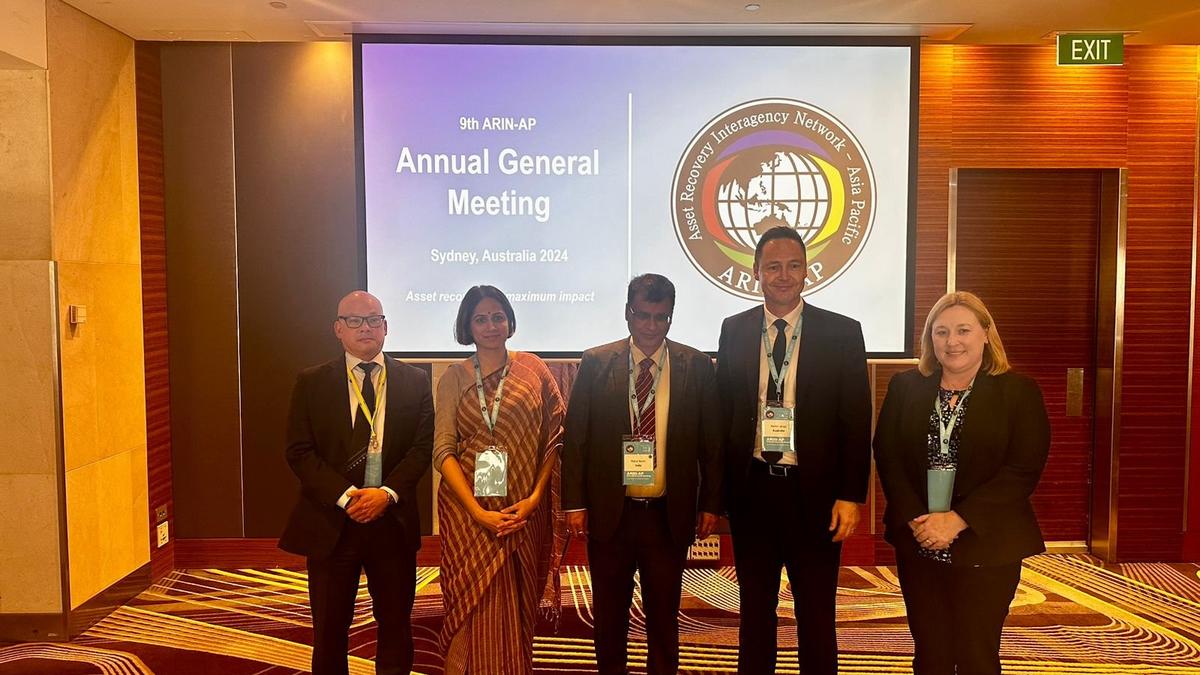
- 02 Nov 2024
In News:
- India, represented by the Directorate of Enforcement (ED), has joined the Steering Committee of the Asset Recovery Interagency Network-Asia Pacific (ARIN-AP).
- Leadership Role: India will assume the presidency of ARIN-AP and host the Annual General Meeting (AGM) in 2026, providing a platform for global cooperation in asset recovery and tackling economic crimes.
ARIN-AP Overview:
- Establishment: ARIN-AP is a multi-agency network formed to address the proceeds of crime across the Asia-Pacific region.
- Network Goals: Its mission is to facilitate cross-border collaboration in the areas of asset tracing, freezing, and confiscation.
- Membership: ARIN-AP includes 28 member jurisdictions and 9 observers, and operates as a key component of the Global CARIN Network (Camden Asset Recovery Inter-Agency Network).
- Functioning: ARIN-AP operates through a network of contact points that enable intelligence exchange among member agencies, promoting effective communication and coordination for asset recovery.
Significance of ARIN-AP's Work:
- Combating Economic Crimes: ARIN-AP enhances the efforts of law enforcement agencies in tracing and recovering assets linked to criminal activities, including both movable and immovable assets.
- Informal Exchange of Intelligence: The network allows for the informal exchange of intelligence between agencies, which often accelerates the identification and recovery of proceeds of crime. This can later lead to formal actions through bilateral or multilateral agreements.
- Global Impact: With over 100 jurisdictions in the broader CARIN Network, ARIN-AP plays a key role in global efforts to combat fugitive economic offenders and illicit financial flows.
India’s Contribution and Alignment with G-20 Priorities:
- India’s Leadership: India’s presidency in ARIN-AP will enhance its leadership in asset recovery, facilitating closer cooperation with regional and international law enforcement agencies.
- G-20 Alignment: This role aligns with India’s priorities under the G-20 framework, particularly focusing on the Nine-Point Agenda aimed at tackling fugitive economic offenders and improving asset recovery mechanisms.
Melanistic Tigers
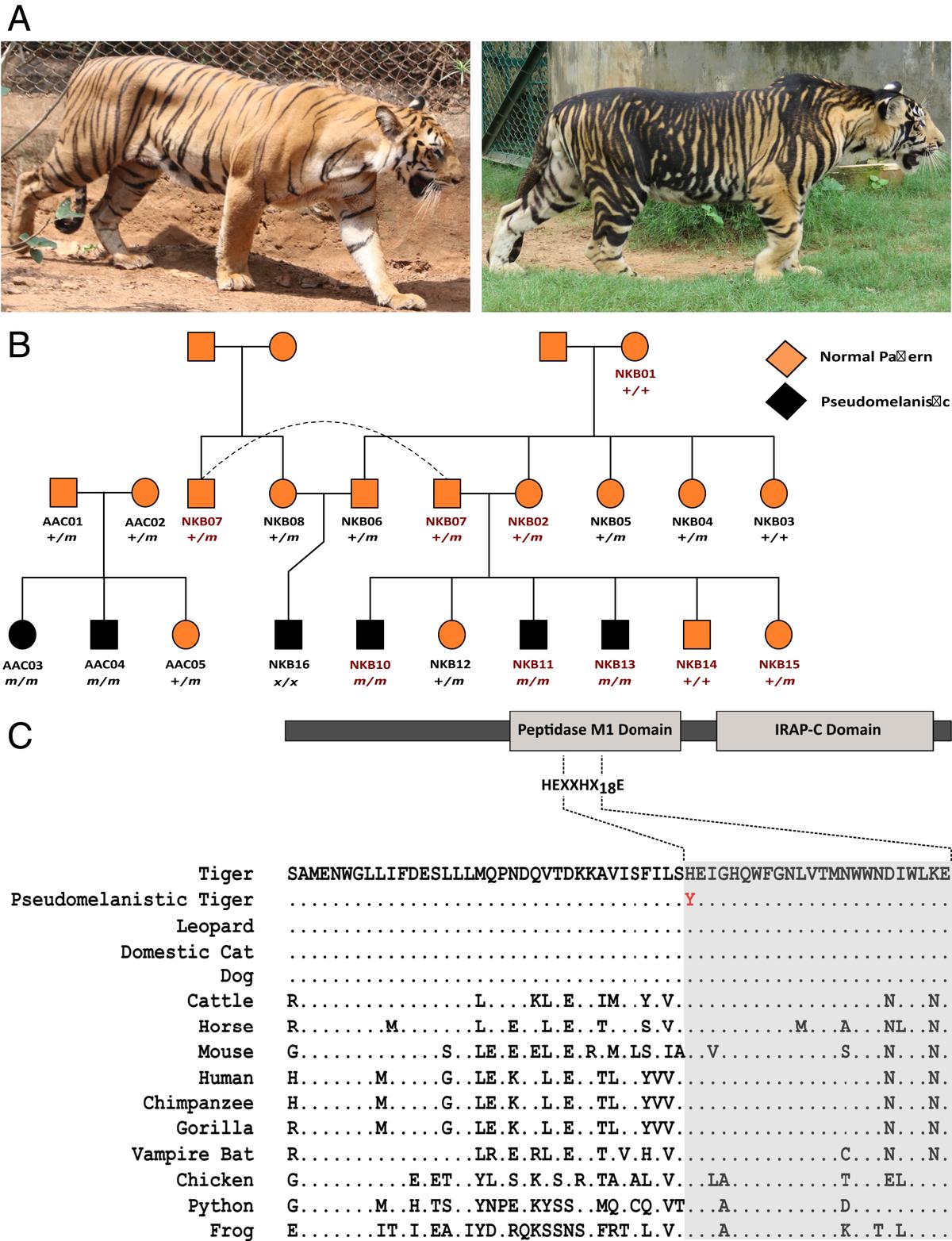
- 01 Nov 2024
In News:
- Odisha government relocated a tigress from Maharashtra’s Tadoba-Andhari Tiger Reserve to Similipal Tiger Reserve, Odisha, to address inbreeding issues among the tiger population.
- The tigress is part of a genetic diversification plan to remedy the increasing number of pseudo-melanistic tigers in the region.
Pseudo-melanistic Tigers:
- Pseudo-melanistic tigers, often referred to as "black tigers," exhibit a darker coat with broader, more prominent stripes.
- The mutation leads to the appearance of a mostly black fur, with occasional white-orange stripes.
Genetic Basis:
- This coloration is due to a mutation in the Taqpep gene, which causes the widening and darkening of stripes on the tiger's coat.
- The mutation is linked to genetic drift and inbreeding within the isolated Similipal population.
Historical Context:
- These tigers were once considered mythical until the 1700s, with sightings only being documented in the 1990s and 2017-18.
- The first confirmed genetic evidence of the black tiger appeared when a cub was born in captivity at Oklahoma City Zoo in the 1970s.
Distribution and Prevalence:
- Pseudo-melanistic tigers are predominantly found in Similipal Tiger Reserve, with 27 out of 30 tigers in Odisha exhibiting the trait.
- Other instances of such tigers exist in captivity, such as in Nandankanan Zoological Park (Bhubaneswar) and Arignar Anna Zoological Park (Chennai), both tracing ancestry to Similipal.
Genetic Studies:
- A 2021 study by the National Centre for Biological Sciences (NCBS) linked the Taqpep gene mutation to the unique appearance of these tigers.
- The mutation causes a missense change in the gene, replacing Cytosine with Thymine (C1360T), altering the tiger’s coat pattern.
High Frequency of Mutation in Similipal:
- Genetic analyses indicate a high frequency of the Taqpep gene mutation in Similipal tigers, with a 60% chance that a tiger born there will carry the mutated gene.
- Inbreeding and genetic isolation have contributed to this phenomenon, as Similipal’s tiger population is geographically cut off from other populations.
Report of The Lancet Countdown on Health and Climate Change, 2024
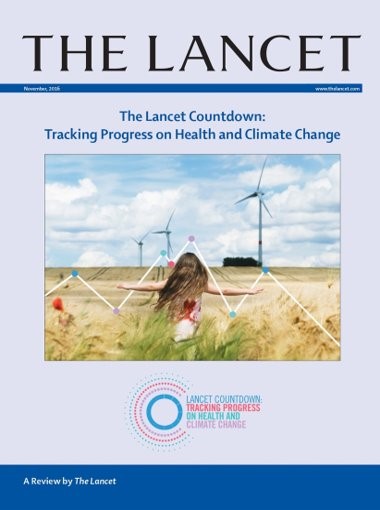
- 30 Oct 2024
In News:
The 2024 edition of The Lancet Countdown on Health and Climate Change presents critical insights into the intersection of health and climate change.
Key Findings from the 2024 Report
- Air Pollution and Mortality in India:
- In 2021, air pollution was responsible for 1.6 million deaths in India.
- Fossil fuels (coal and liquid gas) were identified as major contributors, accounting for 38% of these deaths.
- India was ranked as the second-highest emitter of PM2.5 globally in 2022, contributing 15.8% of consumption-based and 16.9% of production-based PM2.5 emissions.
- Impact of Heat Stress:
- In 2023, India experienced 2400 hours (or 100 days) of moderate to high heat stress, particularly during light outdoor activities like walking.
- Heatwaves have become more frequent, with adults over 65 years experiencing 8.4 heatwave days per year, a 58% increase from 1990-1999.
- This increased heat exposure has led to a loss of 181 billion labor hours globally, translating into an economic loss of approximately $141 billion.
- Global and National Trends in Air Pollution:
- PM2.5 is particularly hazardous because it is fine enough to enter the lungs and bloodstream, leading to severe health risks like respiratory and cardiovascular diseases.
- Nitrogen Dioxide (NO?), Sulphur Dioxide (SO?), Carbon Monoxide (CO), and Ozone (O?) were identified as other pollutants contributing to poor air quality in India.
- Health Impact of Extreme Weather:
- The 2023 heatwave was one of the hottest years on record, exacerbating health risks worldwide, especially for the elderly.
- Droughts and heatwaves also contributed to a rise in food insecurity, affecting millions globally.
- Disease Transmission and Climate Change:
- Dengue transmission potential rose by 85% from 1951-1960 to 2014-2023.
- Coastal areas suitable for the spread of Vibrio pathogens, which cause cholera, expanded by 23%, affecting over 210 million people.
- Health Effects of Fossil Fuel Pollution:
- Continued reliance on fossil fuels worsens air quality, leading to health problems such as respiratory diseases, cardiovascular issues, and adverse pregnancy outcomes.
Government Efforts to Tackle Air Pollution in India
- National Clean Air Programme (NCAP):
- NCAP is a national strategy to reduce air pollution across India, with specific action plans for 131 non-attainment cities. The initiative is supported through various central government schemes such as:
- Swachh Bharat Mission (Urban)
- Atal Mission for Rejuvenation and Urban Transformation (AMRUT)
- Smart City Mission
- Faster Adoption and Manufacturing of Hybrid and Electric Vehicles (FAME-II)
- NCAP is a national strategy to reduce air pollution across India, with specific action plans for 131 non-attainment cities. The initiative is supported through various central government schemes such as:
- Bharat Stage VI (BS-VI) Emission Norms:
- BS-VI standards aim to significantly reduce vehicular pollution, lowering permissible limits for NOx and particulate matter (PM) emissions from vehicles.
- System of Air Quality and Weather Forecasting and Research (SAFAR):
- SAFAR measures air quality and provides forecasts for metropolitan cities based on real-time data, helping authorities take preventive actions.
- Promotion of Renewable Energy:
- India achieved a record 11% of electricity from renewable energy in 2022. However, 71% of India’s electricity still comes from coal, underscoring the need for a faster transition to cleaner energy sources.
CRS Mobile App

- 30 Oct 2024
In News:
- Recently, the Union Home Minister Amit Shah launched the Civil Registration System (CRS) mobile app.
- The app aims to integrate technology with governance by making the registration of births and deaths more accessible, seamless, and hassle-free.
Key Features of the App:
- Anytime, Anywhere Registration: Citizens can register births and deaths from anywhere and at any time, in their State’s official language.
- The app is designed to significantly reduce the time required for registration, making it more efficient and convenient for users.
Legal and Policy Background:
- The Registration of Births and Deaths (Amendment) Act, 2023 mandates that all births and deaths in India, occurring from October 1, 2023, must be digitally registered through the Centre’s portal: dc.crsorgi.gov.in.
- This move is part of the broader effort to digitize civil records and create a centralized database.
Benefits of Digital Registration:
- Digital Birth Certificates: The new system will issue digital birth certificates which will serve as a single document to prove the date of birth for various services, such as:
- Admission to educational institutions
- Applying for government jobs
- Marriage registration
- Centralized Database: The integration of birth and death data into a centralized database will help update critical records such as:
- National Population Register (NPR)
- Ration cards
- Property registration
- Electoral rolls
National Population Register (NPR) Integration:
- The data collected through the CRS app will assist in updating the National Population Register (NPR), which was first collected in 2010 and updated in 2015 through door-to-door enumeration.
- The NPR serves as the first step toward the creation of the National Register of Citizens (NRC) under the Citizenship Act, aimed at identifying Indian citizens.
Belt and Road Initiative (BRI)
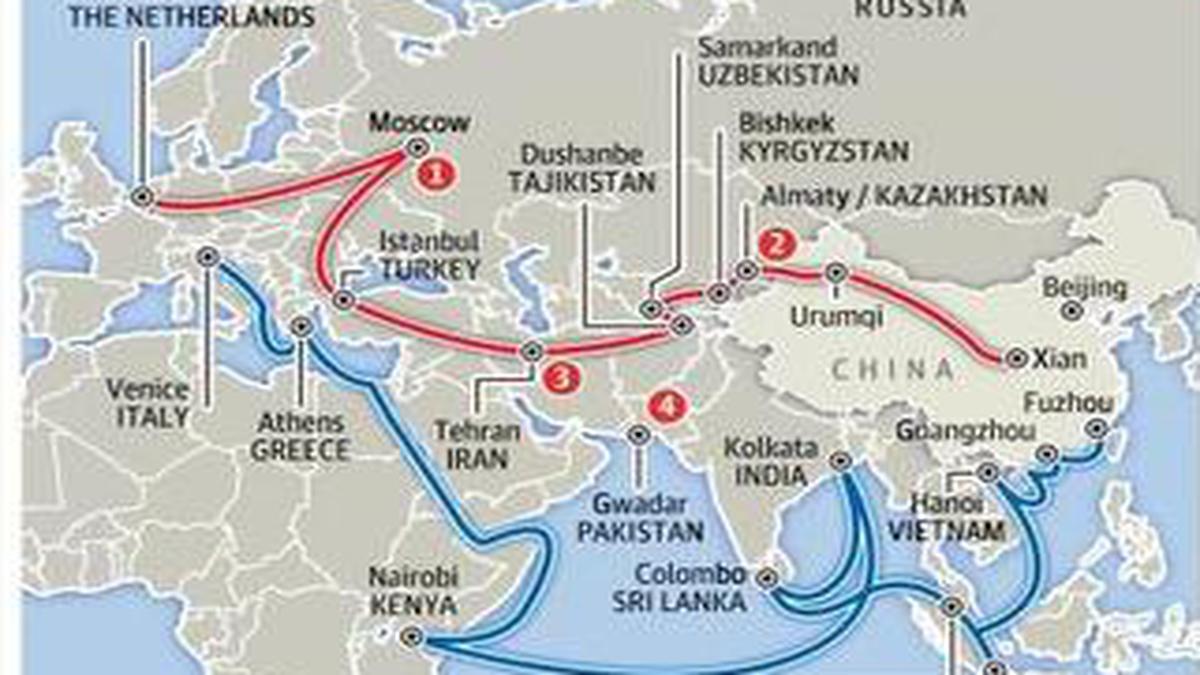
- 30 Oct 2024
In News:
- Brazilhas opted not to join China’s Belt and Road Initiative (BRI), becoming the second BRICS country after India to reject the multi-billion-dollar infrastructure project.
- Brazil prefers to explore alternative ways to collaborate with Chinese investors without signing a formal treaty, aiming to avoid the perceived risks of the BRI.
BRICS and India’s Role:
- Brazil’s decision follows India’s long-standing opposition to the BRI, particularly due to the China-Pakistan Economic Corridor (CPEC) passing through Pakistan-occupied Kashmir, which India views as a violation of its sovereignty.
- India has consistently argued that BRI projects should adhere to international norms, good governance, and transparency, emphasizing that such initiatives should be financially sustainable and not lead to debt traps.
Brazil’s Broader Economic Strategy:
- Brazil aims to balance its relationship with China, which is a major economic partner, but without being bound by the BRI. This decision reflects broader concerns within Brazil about the long-term financial sustainability of BRI projects, especially after witnessing debt crises in other countries like Sri Lanka.
Global Context and the BRI's Impact:
- The BRI, launched by China in 2013, spans several infrastructure sectors and has expanded globally, but it has faced criticism for its potential to trap smaller nations in unsustainable debt.
- India and Brazil’s resistance to the BRI highlights growing skepticism among emerging economies about the long-term implications of joining China's flagship project.
New Space Missions and Developments
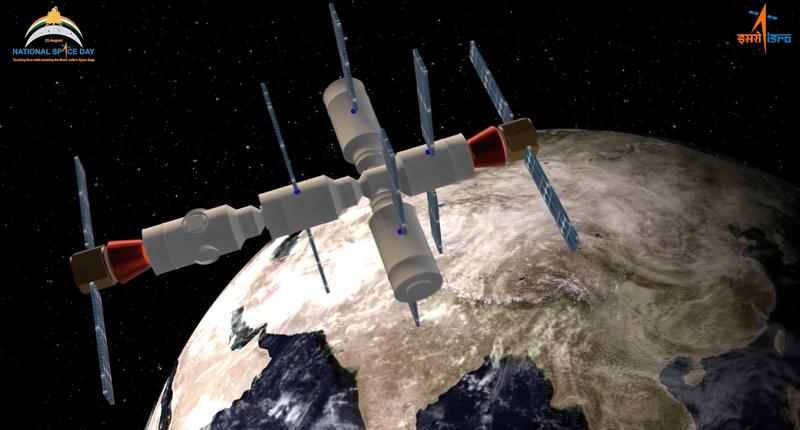
- 28 Oct 2024
In News:
The Space Commission also approved a joint moon mission with Japan called the Lunar Polar Exploration Mission. For LUPEX, ISRO is developing a different moon lander than the one it used for Chandrayaan-3
New Space Missions and Developments
- Chandrayaan-4 (Moon Mission):
- Type: Sample-return mission.
- Launch: Expected by 2027.
- Cost: ?2,104 crore.
- Objective: Sample collection of moon soil and rock to return to Earth.
- Mission Details: Two LVM-3 launch vehicles will launch components that will dock in Earth orbit before heading to the moon. The samples will be sent back using a bespoke canister.
- Lunar Polar Exploration Mission (LUPEX):
- Collaboration: Joint mission with Japan.
- Objective: Exploration of lunar poles with a new lander design, intended for potential crewed missions in future.
- Venus Orbiter Mission:
- Launch Window: March 2028.
- Cost: ?1,236 crore.
- Objective: Study Venus' surface and atmosphere to understand planetary evolution in the Solar System.
- Next Generation Launch Vehicle (NGLV):
- Development Budget: ?8,240 crore for first three development flights.
- Objective: A new launcher developed with private sector collaboration for future space missions.
Cabinet Approvals for Space Initiatives
- Human Spaceflight Programme (Gaganyaan):
- Four new missions under Gaganyaan, including an uncrewed Gaganyaan flight.
- Focus on developing technologies for India’s first space station, Bharatiya Antariksh Station (BAS), planned by 2028.
- Space-Based Surveillance (SBS) Missions:
- Phase 3: Approval for building 21 ISRO satellites, with 31 additional satellites by private companies.
- Total Cost: ?26,968 crore.
- Development of a Third Launch Pad:
- To support the NGLV and additional space missions at Sriharikota.
Upcoming Satellite Missions
- NISAR (NASA-ISRO Synthetic Aperture Radar):
- Launch: Early 2025 on a GSAT launch vehicle.
- Purpose: Earth observation using advanced radar technology.
- Issue: Protective coating added due to high temperatures during testing.
- Proba-3 (European Space Agency):
- Launch: November 29, 2024, aboard PSLV-XL.
- Objective: Study the Sun’s corona using two satellites in formation, mimicking an eclipse to capture unique solar data.
Private Sector Involvement
- Manastu Space & Dhruva Space:
- Collaboration: Testing green propulsion technology for the LEAP-3 mission.
- Technology: Hydrogen-peroxide-based green propulsion system.
- Launch: LEAP-3 mission in 2025.
- Bellatrix Aerospace:
- Project: Prototype satellite for ultra-low earth orbit at 200 km altitude.
- Ananth Technologies:
- Achievement: First private company to assemble, integrate, and test Space Docking Experiment (SpaDEx) satellites for ISRO.
Space Science and Research Updates
- Chandrayaan-3:
- Findings: The crater where Chandrayaan-3 landed is older than the South Pole-Aitken Basin (4.2-4.3 billion years old).
- Data Source: Optical High-Resolution Camera (Chandrayaan-2) and Pragyaan rover (Chandrayaan-3).
- Astrosat (India’s First Space Observatory):
- Mission Life: Expected to last two more years (originally planned for 5 years).
- Significance: Contributed to over 400 published papers based on multi-wavelength space observatory data.
ISRO-DBT Agreement for Biotechnology Experiments in Space
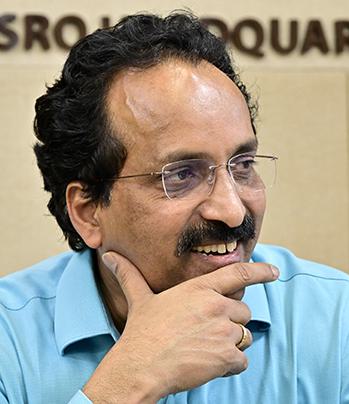
- 27 Oct 2024
In News:
- The Indian Space Research Organisation (ISRO) and the Department of Biotechnology (DBT) have signed an agreement to conduct biotechnology experiments on the upcoming Bharatiya Antariksh Station (BAS).
- Timeline for BAS:
- The BAS is expected to be operational from 2028-2035, with the initial module launches slated for 2028 and full expansion by 2035.
- It will be located at an altitude of 400 km above Earth and will support 15–20-day missions in space.
Focus Areas of Research
- Health Impact:
- Weightlessness & Muscle Health: Studying the effects of zero-gravity on muscle loss during space missions.
- Radiation Effects: Investigating how space radiation impacts astronaut health over long durations.
- Bio-Manufacturing:
- Algae Studies: Exploring algae for potential use in nutrient-rich, long-lasting food sources and biofuel production.
- Food Preservation: Identifying algae varieties that can help preserve food for longer periods in space.
- Integration with Gaganyaan Mission:
- Experiments may also be conducted during uncrewed test flights for the Gaganyaan mission (India’s first crewed mission to space, scheduled for 2025-2026).
BioE3 (Biotechnology for Economy, Environment and Employment) Policy
- Objective: The BioE3 policy aims to boost bio-manufacturing in India, which is projected to contribute $300 billion to the Indian economy by 2030.
- Key Focus Areas:
- High-Value Bio-Based Products: Promotes the development of bio-based chemicals, biopolymers, enzymes, and smart proteins.
- Climate-Resilient Agriculture & Carbon Capture: Aims to strengthen agricultural practices to withstand climate change and promote carbon capture technologies.
- Healthcare & Nutrition: Focuses on advancements in biotherapeutics, functional foods, and regenerative medicine.
- Marine & Space Biotechnology: Encourages research in space and marine biotechnology for new applications.
- Innovation & Entrepreneurship: Supports R&D-driven entrepreneurship through the establishment of bio-manufacturing hubs, bio-AI centers, and biofoundries.
- Employment Growth: Aims to create skilled jobs in the growing bioeconomy, promoting green growth and sustainable industries.
Bharatiya Antariksh Station (BAS) Overview
- Structure: The station will consist of:
- Command Module
- Habitat Module
- Propulsion Systems
- Docking Ports
- Objective: To support long-term research in space life sciences and bio-manufacturing, with a focus on human health, food sustainability, and biotechnology innovations.
National Mission for Manuscripts (NMM)
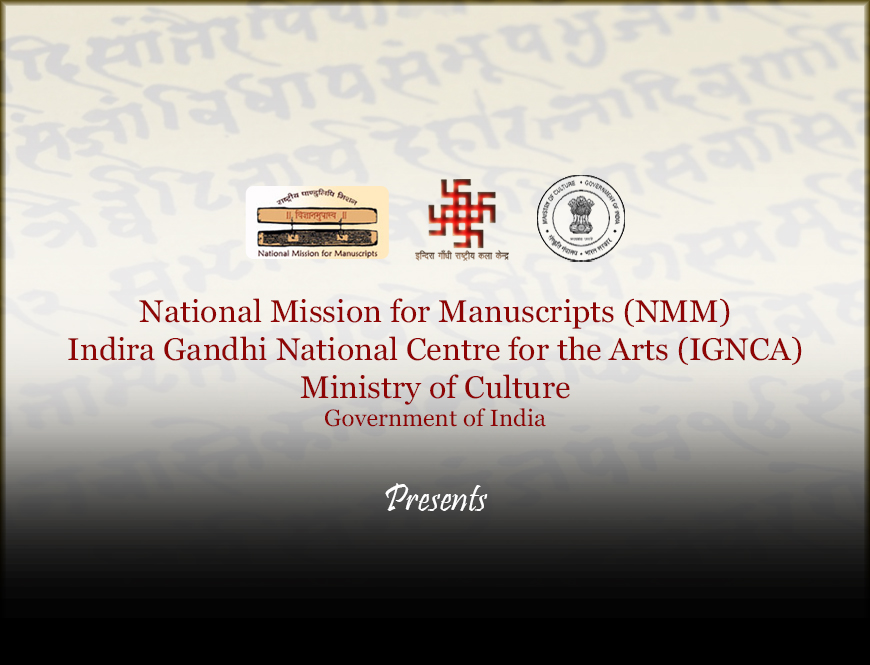
- 26 Oct 2024
In News:
- The Union Ministry of Culture plans to revive and relaunch the National Mission for Manuscripts (NMM) to enhance the preservation and accessibility of India’s ancient texts.
- The mission’s objective is to document, conserve, digitize, and disseminate India’s rich manuscript heritage, ensuring their protection and public access.
Formation of a New Autonomous Body:
- The National Mission for Manuscripts (NMM) is likely to be restructured into an autonomous body called the National Manuscripts Authority, which will be under the Ministry of Tourism and Culture.
- The new body will address the challenges and gaps in manuscript preservation and management, offering more focused and flexible governance.
Background and Achievements:
- Established in 2003, the NMM has been part of the Indira Gandhi National Centre for Arts (IGNCA).
- Key achievements:
- 52 lakh manuscripts have had metadata prepared.
- Over 3 lakh manuscripts have been digitized, though only one-third have been uploaded for public access.
- Preventive and curative conservation of over 9 crore folios of manuscripts has been undertaken over the last 21 years.
- The NMM has set up 100 Manuscripts Resource Centres and Manuscripts Conservation Centres across India.
Current Challenges and Gaps:
- Data Uploading and Access:
- Of the 130,000 digitized manuscripts, only 70,000 are accessible online due to the absence of a comprehensive access policy.
- A significant portion (around 80%) of manuscripts areprivately owned, restricting public access and usage.
- Digitization Mismatch:
- There have been concerns about discrepancies between the digitized data and the original manuscripts, which requires correction to ensure authenticity and accuracy.
- Lack of Comprehensive Access Policy:
- Limited public access to manuscripts due to policy restrictions hinders further research and public engagement with this rich heritage.
Scope and Future of NMM:
- India's Manuscript Heritage: India is believed to have around 10 million manuscripts, spread across various regions, languages, scripts, and topics.
- Digitization and Accessibility: Moving forward, the key challenge will be ensuring that a larger proportion of the manuscripts are digitized, uploaded, and made publicly available, particularly from private collections.
- The establishment of the National Manuscripts Authority is expected to streamline efforts and enhance coordination between government bodies, private institutions, and scholars.
Precision Medicine, Biobanks, and Regulatory Challenges in India

- 26 Oct 2024
In News:
Precision medicine is bringing in a new era of personalised healthcare. The field began to take concrete shape when scientists were wrapping up the Human Genome Project.
Introduction to Precision Medicine:
- Precision Medicine is a novel approach to healthcare that tailors treatments and preventive strategies based on an individual’s genetics, environment, and lifestyle, instead of using a one-size-fits-all approach.
- It leverages technologies like genomics, gene editing (CRISPR), and mRNA therapeutics to address various diseases such as cancer, chronic diseases, and genetic disorders.
- Recent breakthroughs include gene therapy for restoring vision and stem cell transplants for reversing diabetes, demonstrating the transformative potential of precision medicine.
Role of Biobanks in Precision Medicine:
- Biobanks are repositories storing biological samples (blood, DNA, tissues) along with associated health data. These samples are crucial for research and development of personalized treatments.
- Large and diverse biobanks are essential for ensuring that precision medicine benefits a wide demographic, as data from homogenous groups could limit the applicability of findings.
- Recent studies using biobank data have led to breakthroughs, such as identifying rare genetic disorders and developing organoid models for high-throughput drug screening.
Precision Medicine and Biobanks in India:
- Market Growth: India’s precision medicine market is growing at a CAGR of 16%, expected to surpass USD 5 billion by 2030, contributing 36% to the national bioeconomy.
- Policy Framework: The government’s BioE3 policy aims to promote biomanufacturing, with a focus on precision therapeutics and related technologies like gene editing and cancer immunotherapy.
- Biobank Initiatives:
- Genome India Programme: Completed sequencing of 10,000 genomes from 99 ethnic groups, aimed at identifying treatments for rare genetic diseases.
- Phenome India Project: Focused on collecting 10,000 samples for improving prediction models for cardio-metabolic diseases.
- Paediatric Rare Genetic Disorders (PRaGeD) Mission: Aiming to identify genes that could help develop targeted therapies for genetic diseases in children.
Regulatory and Ethical Challenges in Biobanking:
- India’s biobanking regulations are inconsistent, hindering the full potential of precision medicine. Unlike countries like the U.K., U.S., and Japan, which have comprehensive laws addressing issues like informed consent, data protection, and privacy, India lacks a cohesive regulatory framework.
- Informed Consent Issues: In India, participants provide samples without full knowledge of how their data will be used, who will have access to it, and for how long it will be stored. This lack of transparency undermines public trust in biobank research.
- Ethical Concerns: Without a clear regulatory framework, there is a risk of misuse of biological samples, such as non-consensual data sharing and sample mishandling.
- International Implications: The absence of robust laws allows foreign pharmaceutical companies to access Indian biobank data and samples without ensuring that the Indian population benefits from the resulting research or profits.
Global Comparison of Biobank Regulations:
- International Standards: Countries like the U.K., U.S., and Japan have established comprehensive biobank regulations, addressing:
- Informed consent for sample collection and data usage.
- Privacy protection and secure storage of genetic information.
- Withdrawal rights for participants at any stage of research.
- India’s biobank regulations lack clear provisions for data protection and participant rights, limiting the effectiveness of research and undermining public confidence in biobanks.
Introduction to Innovative Cancer Detection Technique
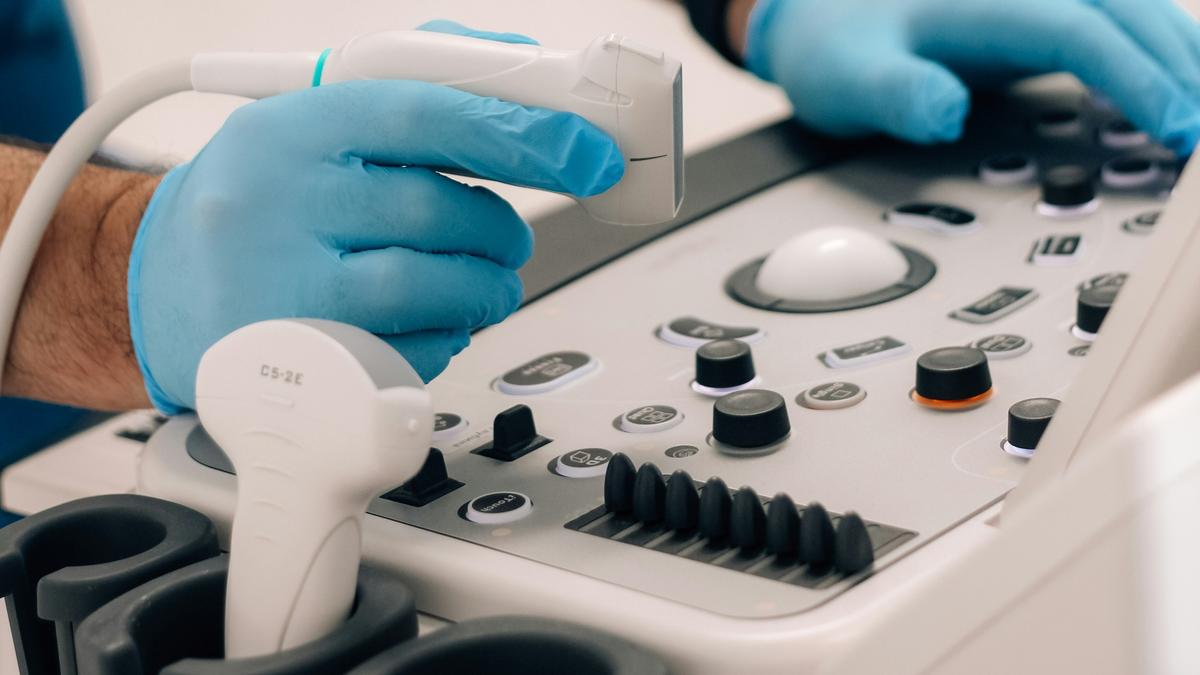
- 25 Oct 2024
In News:
- Scientists have developed an ultrasound-based technique for detecting cancer, aiming to replace traditional biopsies, which are invasive and painful.
- Promising Alternative: The method uses high-energy ultrasound to release biomarkers (RNA, DNA, and proteins) from cancerous tissue into the bloodstream, allowing for early cancer detection with minimal discomfort.
- Presented at Acoustical Society Conference: The technique was discussed at the joint meeting of the Acoustical Society of America and Canadian Acoustical Association in May 2024.
Traditional Cancer Detection vs. New Ultrasound Approach
- Current Gold Standard - Biopsy: Traditionally, cancer is diagnosed using biopsies, where a tissue sample is extracted using a needle from suspected cancerous areas. Although effective, biopsies are invasive, painful, and carry some risks.
- Ultrasound as a Non-Invasive Alternative: The new method involves using high-frequency ultrasound waves to break off cancerous tissue into droplets, which are then released into the bloodstream. The biomarkers in the droplets can be analyzed for cancerous mutations.
- Enhanced Sensitivity: This ultrasound-based technique increases the levels of genetic and vesicle biomarkers in blood samples by over 100 times, enabling the detection of cancers and specific mutations that are otherwise undetectable in blood.
Key Findings of the Research
- Single Cancer Cell Detection: The technique allows for the detection of a single cancer cell in blood samples. It works by passing ultrasound waves through isolated blood samples, which break apart circulating cancer cells, releasing biomarkers into the blood.
- Cost-Effective: Traditional methods for detecting circulating cancer cells are costly (e.g., the ‘CellSearch’ test costs $10,000). In contrast, this ultrasound method can detect cancer with a much lower cost, around $100 (?8,400).
- Potential for Early Diagnosis: The research shows promise for detecting cancer at an early stage, even before symptoms appear, using blood samples.
Challenges and Next Steps
- Need for Large-Scale Clinical Trials: While the technique shows potential, large cohort studies involving diverse patient groups across different geographies and ethnicities are needed to validate the approach.
- Long-Term Study for Effectiveness: Further research is required to ensure the accuracy and reliability of the technique across various cancer types and to determine the ideal biomarker thresholds for early detection.
- Regulatory Approval and Commercialization: If the clinical trials yield positive results, the method could be commercially available in approximately five years, following regulatory approval.
Understanding Cancer and Its Types
- Cancer Definition: Cancer refers to the uncontrolled growth of abnormal cells that can form tumors and spread to other parts of the body.
- Types of Cancer:
- Carcinoma: Cancer originating in epithelial cells (e.g., breast, lung, prostate cancer).
- Sarcoma: Affects connective tissues like bones and muscles.
- Leukemia: Affects blood-forming tissues, leading to abnormal white blood cell production.
- Lymphoma: Begins in immune cells, including Hodgkin and non-Hodgkin lymphoma.
- Melanoma: Cancer of pigment-producing skin cells.
- Key Differences Between Normal and Cancer Cells:
- Cancer cells grow uncontrollably and evade immune detection.
- Cancerous cells accumulate chromosomal abnormalities, unlike normal cells, which follow regulated growth patterns.
Chenchu Tribe
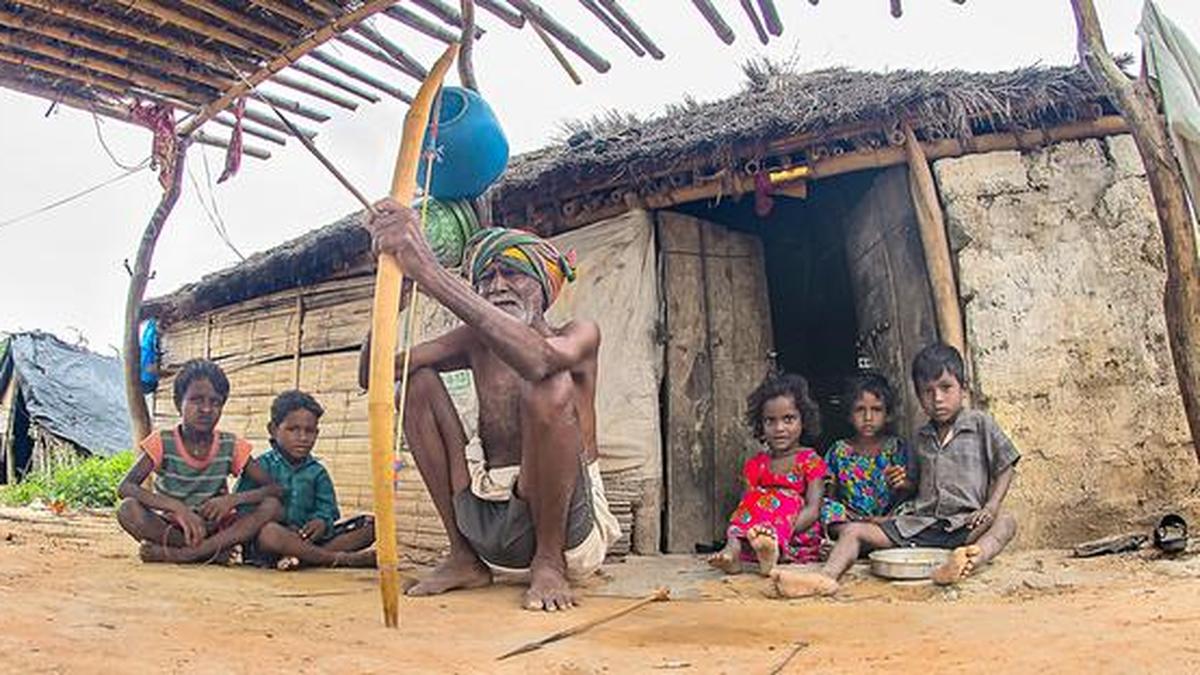
- 25 Oct 2024
In News:
The Chenchus of Penukumadugu have lived in the dense Nallamala forests for centuries, their existence intertwined with the wilderness around them. However, their inability to keep up with the relentless pace of modernisation has led to dwindling work opportunities under the MGNREGA.
Chenchu Tribe Overview
- Location: Primarily in the dense Nallamala forests, Andhra Pradesh (AP).
- Tradition: Historically hunter-gatherers, now relying on subsistence farming.
- Vulnerable Status: Classified as one of the 12 Particularly Vulnerable Tribal Groups (PVTGs) in Andhra Pradesh due to low literacy, stagnant population growth, and limited access to development.
- Livelihood: Dependent on forest resources (Non-Timber Forest Produce - NTFP) and agricultural labor.
Impact of MGNREGS (Mahatma Gandhi National Rural Employment Guarantee Scheme)
- MGNREGS Chenchu Special Project: Launched in 2009 to address specific needs of the Chenchus, such as physical strength, food insecurities, and cultural practices.
- Before Discontinuation: Provided 180 days of work per person annually, which helped Chenchus access regular income, improving food security and living conditions.
- Post-Discontinuation (2022):
- The project was integrated into a nationwide MGNREGS framework, reducing workdays to the standard 100 days per household.
- Consequences: Many Chenchus stopped engaging with MGNREGS due to bureaucratic hurdles (Aadhaar and bank linkage), reduced job days, and irregular wage payments.
- Only 1,500 out of 4,000 enrolled households currently participate in MGNREGS work.
Key Issues Post-MGNREGS Reform
- Aadhaar & Bank Account Challenges:
- Lack of literacy and digital skills makes the Aadhaar-based system intimidating.
- Many Chenchus are excluded from PDS and health benefits due to missing or unlinked Aadhaar cards.
- Absence of mobile phones and access to banks makes wage disbursement difficult.
- Irregular Payments & Trust Issues:
- The shift to bank payments has created trust issues, as many Chenchus are illiterate and cannot verify wage deposits.
- Distance from banks (up to 30 km) adds to the difficulty in accessing payments.
Forest Rights and Wildlife Conservation
- Forest Dependency: The Chenchus continue to depend on the forest for food and livelihood, but increasing restrictions due to wildlife conservation (e.g., Nagarjuna-Srisailam Tiger Reserve) have further curtailed their access to forest produce.
- Forest Rights Act (FRA): Many Chenchus have land pattas under the FRA but lack resources or support to utilize their land effectively due to the discontinuation of MGNREGS.
Government and Policy Response
- PVTG Initiatives: Various government initiatives like PM PVTG Mission, Viksit Bharat Sankalp Yatra, and Janjatiya Gaurav Divas aim to uplift PVTGs, but their impact remains limited without proper implementation of specialized support programs like the MGNREGS Chenchu Special Project.
IMF's World Economic Outlook (WEO)
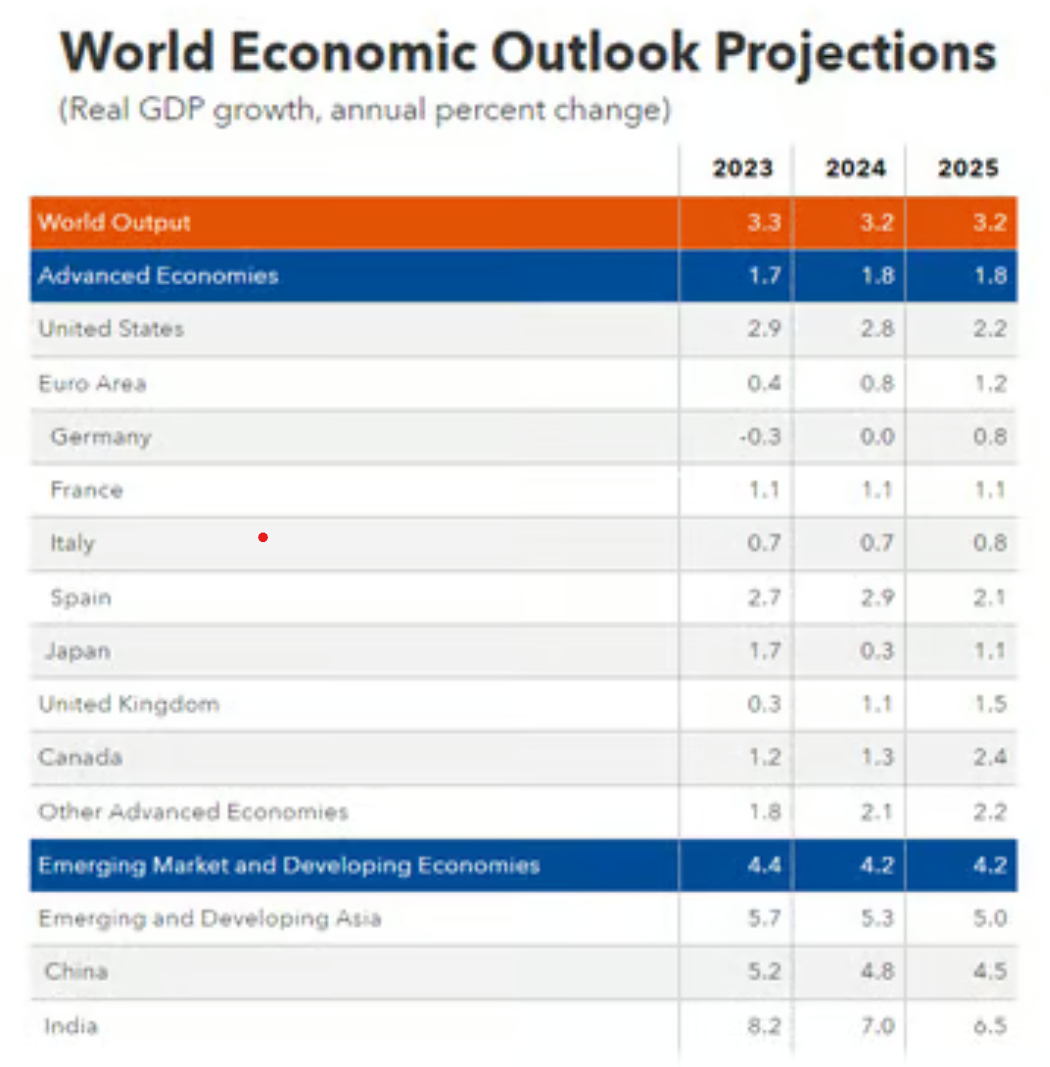
- 24 Oct 2024
In News:
- The International Monetary Fund (IMF) has maintained India’s GDP growth forecast at 7% for FY2024, marking a moderation from 8.2% in 2023.
- FY2025 Projection: Growth is expected to slow further to 6.5% in FY2025.
- India’s growth is expected to be stronger than most other large economies, yet the downward revision reflects challenges in the global economy and moderation in domestic economic momentum.
Global Economic Growth Projections:
- Global Growth (2024-2025): Global growth is projected at 3.2% in 2024 and 2025, which is stable but modest. This growth rate is largely unchanged from previous IMF forecasts.
- Long-Term Outlook: The IMF's long-term projection for global growth is 3.1%, which is considered subpar compared to pre-pandemic growth rates, signaling a potential era of low growth.
Key Risks and Uncertainties:
- The IMF highlights several downside risks to global growth, including:
-
- Monetary tightening: Central banks' high-interest rate policies to combat inflation could have long-term negative effects on economic growth and financial stability.
- Geopolitical Tensions: Ongoing conflicts, such as the Russia-Ukraine war, could disrupt global supply chains and trade, exacerbating inflation and slowing growth.
- China’s Economic Slowdown: China, the world’s second-largest economy, is facing a slower growth trajectory, especially in its real estate sector, which is dragging down its overall growth.
- Structural Challenges: The aging population and weak productivity are long-term growth inhibitors in many advanced economies, adding uncertainty to future growth prospects.
-
- Inflation and Monetary Policy:
- The IMF's inflation forecast shows global inflation cooling:
- 2023: Global inflation is expected to reach 6.7%.
- 2024: It is forecast to fall to 5.8%, with advanced economies expected to return to inflation targets sooner than emerging markets.
- 2025: A further decline to 4.3%.
- The primary driver of disinflation is not interest rate hikes but the unwinding of pandemic-related shocks, supply chain improvements, and the gradual return of labor supply.
- Monetary Policy: Central banks are likely to ease policies once inflation nears target levels, but risks of further commodity price spikes or geopolitical tensions could delay this.
- The IMF's inflation forecast shows global inflation cooling:
US and Europe Growth:
- Emerging Markets and Developing Economies:
- Growth Outlook: The IMF forecasts growth in emerging markets and developing economies at 4.2% for 2024 and 2025, with a slight moderation to 3.9% by 2026.
- Emerging Asia: Growth in emerging Asia (led by India and China) is expected to slow, from 5.7% in 2023 to 5% in 2025.
- India’s Relative Strength: India’s growth continues to outperform many emerging economies, though the slowdown from 8.2% in 2023 to 7% in 2024 reflects global economic headwinds.
- Income Inequality Risks:
- The IMF warns that low growth over an extended period (4+ years) could exacerbate income inequality within countries, as sluggish growth affects job creation and wage growth.
- Countries with slow economic recovery are likely to see a widening gap between rich and poor, undermining social cohesion and stability.
Cyberfraud Losses and Economic Impact

- 24 Oct 2024
In News:
- ?1.2 lakh crore is the projected financial loss due to cyber frauds in India over the next year (2024), according to the Indian Cyber Crime Coordination Centre (I4C) under the Union Home Ministry.
- This could amount to 0.7% of India’s GDP.
- Mule Accounts:
- Mule accounts are a significant contributor to cyber frauds. These accounts are used to facilitate money laundering and illegal transactions.
- On average, around 4,000 mule accounts are identified daily by I4C.
- Mule accounts typically facilitate the transfer of funds out of India, often through cryptocurrency transactions.
- Sources of Cyber Scams:
- A majority of frauds are linked to Chinese entities or China-based operations, with about half of the cybercrime complaints originating from China.
- Other major hubs for cyber frauds include Cambodia, Myanmar, and Laos, which house call-centre-like scam compounds.
- Azerbaijan has also been identified as a new hotspot for such scams.
- International Dimension:
- Fraudulent withdrawals have been reported from ATMs in Dubai, Hong Kong, Bangkok, and Russia using mule accounts.
- The international nature of these scams often involves routing stolen funds through various countries, using methods like cryptocurrency exchanges.
- Cybercrime and Terror Financing:
- Cyber scams have potential ramifications beyond financial losses; they can be used for terror financing and money laundering.
- Cryptocurrency is a common medium for laundering money, with an example cited of ?5.5 crore laundered through 350 transactions in a short span.
- ATM Hotspots and Fraudulent Withdrawals:
- 18 ATM hotspots have been identified across India where fraudulent withdrawals occur.
- Fraudsters exploit these locations to withdraw money, often using mule bank accounts and cross-border ATM networks.
- Government Response:
- The Ministry of Home Affairs (MHA) is working to combat these frauds by convening meetings with the Union Finance Ministry and the Reserve Bank of India (RBI).
- The objective is to curb the operation of mule accounts and strengthen the banking system to prevent such frauds.
- Banks are being urged to flag unusually high-value transactions or accounts with low balances that are engaging in suspicious activity.
- Fraudulent Calls and Scam Compounds:
- Indian fraudsters, in collaboration with international scam rings, use Indian mobile phone numbers to deceive citizens.
- Countries like Cambodia, Myanmar, Laos, and Azerbaijan have been identified as hubs for investment scams involving fraudulent calls.
- Helpline and Cyber Fraud Reporting System:
- The Citizen Financial Cyber Fraud Reporting and Management System (part of I4C) and the 1930 helpline provide mechanisms to report financial frauds.
- ?11,269 crore in financial frauds was reported during the first half of 2024 via these channels.
- The system also involves cooperation with over 200 financial intermediaries, including banks and wallets.
Tenkana

- 23 Oct 2024
In News:
- A team of arachnologists has discovered a new genus of jumping spiders, Tenkana, found across southern India and northern Sri Lanka.
- The discovery includes two previously known species, Tenkanamanu and Tenkanaarkavathi, and introduces a new species, Tenkanajayamangali, from Karnataka.
Name and Origin:
- The name Tenkana comes from the Kannada word for "south," reflecting the geographical region where all known species of this genus are found—southern India and northern Sri Lanka.
- The genus belongs to the Plexippina subtribe of jumping spiders, which is distinct from related genera like Hyllus and Telamonia.
Key Findings:
- Tenkanajayamangali was first discovered in Devarayanadurga reserve forest, Tumakuru district, Karnataka, at the origin of the Jayamangali river.
- The new species was identified through genetic analysis and physical examination, showing it did not match any known species.
Physical Characteristics:
- The male and female Tenkanajayamangali exhibit distinct physical differences.
- The male has pale hairs covering most of its carapace, while the female is grey with a pattern.
- The ocular area of T. jayamangali is uniformly covered with white hairs, in contrast to T. arkavathi and T. manu, which have distinctive markings.
Habitat and Distribution:
- Tenkana spiders are typically ground-dwelling and prefer dry, open habitats like short grasses, leaf litter, and rocky outcrops.
- These spiders have been observed in Tamil Nadu, Puducherry, Karnataka, Telangana, Andhra Pradesh, and some areas in Sri Lanka.
- The male and female spiders of T. jayamangali were discovered in different regions, 2 km apart, at the hilltop and foothills of the same forest.
Ecological and Behavioral Insights:
- The Tenkana genus is considered endemic to India, with species observed in diverse regions such as Bengaluru, Yercaud (Tamil Nadu), and Bannerghatta (Karnataka).
- These spiders are found in complex microhabitats, like shaded short grasses with dry leaf litter or rocky outcrops in relatively dry habitats.
- The movement of Tenkana spiders resembles that of Stenaelurillus, another ground-dwelling spider species.
India-Pakistan Kartarpur Corridor Agreement Renewal
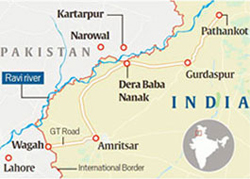
- 23 Oct 2024
In News:
- India and Pakistan have extended the Sri Kartarpur Sahib Corridor Agreement for another five years (until 2029).
- Purpose: The extension ensures uninterrupted operation of the corridor, allowing Indian pilgrims to visit Gurdwara Darbar Sahib Kartarpur in Pakistan.
- Significance: The extension reflects continued cooperation between India and Pakistan, with potential implications for improving bilateral relations.
Background of Kartarpur Corridor:
- Inception: The agreement was first signed on October 24, 2019, to allow visa-free access for Indian pilgrims to Gurdwara Darbar Sahib Kartarpur near Narowal in Pakistan.
- Pilgrimage Details:
- Eligibility: Indian nationals and Overseas Citizens of India (OCI) cardholders can visit the gurdwara on a daily basis.
- Return on Same Day: Pilgrims must return on the same day.
- No Religious Restrictions: Pilgrims of any faith can use the corridor.
- Capacity: Up to 5,000 pilgrims per day can visit the gurdwara.
- Historical Importance: The corridor facilitates the Sikh community's access to a key religious site, located just 4.7 km from the India-Pakistan border.
- Service Charge Dispute:
- Pakistan's Service Fee: Pakistan continues to charge a $20 service fee (approx. ?1,680) per pilgrim, which India has consistently urged Pakistan to waive.
- Pakistan’s Justification: Pakistan maintains the fee to cover the $17 million spent on refurbishing the gurdwara and developing infrastructure for the corridor.
- Geopolitical Context and Timing:
- Recent Developments: The agreement renewal follows External Affairs Minister S. Jaishankar’s visit to Pakistan to attend the Shanghai Cooperation Organization (SCO) Council of Heads of Government meeting.
- Improved Bilateral Relations: Jaishankar’s visit marked the first visit by an Indian foreign minister to Pakistan in nearly nine years, signaling potential thaw in relations, despite the lack of formal bilateral dialogue.
- Strategic and Religious Importance:
- Religious Diplomacy: The Kartarpur Corridor is viewed as a confidence-building measure and a symbol of religious diplomacy, particularly for the Sikh community.
- Historical Legacy: The corridor links Gurdwara Darbar Sahib Kartarpur in Pakistan to Gurdwara Dera Baba Nanak in India, facilitating access to a site of immense religious significance for Sikhs.
- Implications for India-Pakistan Relations:
- No Formal Bilateral Talks: Despite the successful renewal of the agreement, formal talks between India and Pakistan remain suspended, particularly after India’s revocation of Article 370 in Jammu and Kashmir in 2019, which led to a diplomatic freeze.
- Pakistan's Diplomatic Stance: Pakistan had recalled its high commissioner from India in August 2019, and tensions have remained high since then.
- Potential for Future Engagement:
- Diplomatic Channels Opened: The renewal of the Kartarpur agreement and Jaishankar’s visit suggest that diplomatic channels are still open, and there may be scope for further engagement if both sides take steps to address outstanding issues.
IMF retains India’s growth projection at 7% for FY25
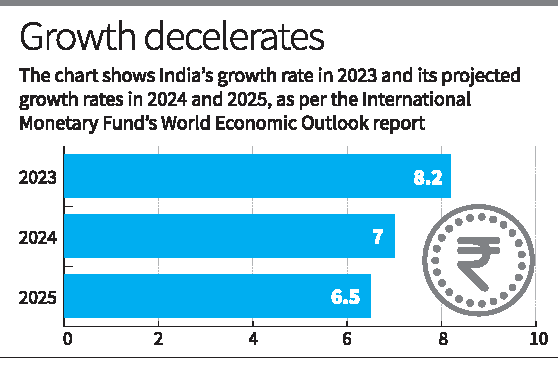
- 23 Oct 2024
In News:
The International Monetary Fund (IMF) has revised India's GDP growth forecast for the fiscal year 2024-25 to 7%, up by 20 basis points from its previous estimate of 6.8%.
- India’s Growth Projections:
- Current Fiscal Year (FY2024-25): India’s GDP growth is projected at 7%, unchanged from June 2024 estimates.
- Next Fiscal Year (FY2025-26): Growth expected at 6.5%.
- Growth Decline from FY2023 (8.2%): The slowdown is attributed to the exhaustion of pent-up demand post-pandemic and the economy returning to its potential.
- Global Economic Growth:
- World Output: Projected global growth at 3.2% in both 2024 and 2025.
- Advanced Economies: U.S. GDP growth revised upward to 2.8% in 2024 and 2.2% in 2025.
- Emerging Markets & Developing Economies: Growth revised upwards, largely due to stronger economic activity in Asia, with China and India being key contributors.
- Global Inflation and Monetary Policy:
- Inflation Decline: Global inflation has decreased from its peak of 9.4% in Q3 2022 to 3.5% projected by end-2025.
- Inflation Outlook: Despite reductions in inflation, price pressures persist in some regions.
- Monetary Policy Tightening: IMF acknowledges challenges due to tight monetary conditions in several economies and their potential impacts on labor markets.
- Global Risks and Challenges:
- Geopolitical Tensions: Ongoing Russia-Ukraine war and escalating conflicts in West Asia (e.g., Lebanon) have increased geopolitical risks, potentially affecting commodity markets.
- Protectionism: Growing protectionist policies worldwide are a risk to global trade and economic stability.
- Sovereign Debt Stress: Debt burdens in several countries could become a source of instability.
- Weak Chinese Economy: Slower-than-expected recovery in China remains a significant concern for global economic growth.
- Monetary Policy Risks: Prolonged tight monetary policies in some countries could impact labor markets and economic recovery.
- IMF’s Policy Recommendations for Medium-Term Growth:
- Monetary Policy Neutrality: Countries should adopt a neutral monetary policy stance to balance growth and inflation control.
- Fiscal Policy Adjustment: Build fiscal buffers after years of loose fiscal policy to ensure stability.
- Structural Reforms: Implement structural reforms to boost productivity and cope with challenges like aging populations, the climate transition, and the need for youth employment.
- India’s Economic Outlook - Key Drivers:
- Rural Consumption Growth: The upward revision of India's FY2024-25 GDP forecast to 7% is driven by improved consumption, especially in rural areas.
- Upward Revisions for 2023: The increased growth forecast also reflects positive carryover effects from India's 8.2% growth in 2023.
- Emerging Asia's Growth: The growth outlook for emerging Asia is supported by India and China, though long-term growth prospects for China are weaker (projected to slow to 3.3% by 2029).
- Global Economic Outlook:
- World Growth Projections: Global growth is expected to remain at 3.2% in 2024 and 3.3% in 2025.
- Diverging Growth Rates: Growth across economies is converging as output gaps close, particularly in advanced economies (e.g., U.S. labor market cooling, euro area recovery).
